PRO ARB
PROFESSIONAL TREE CARE FOR TREE SURGEONS
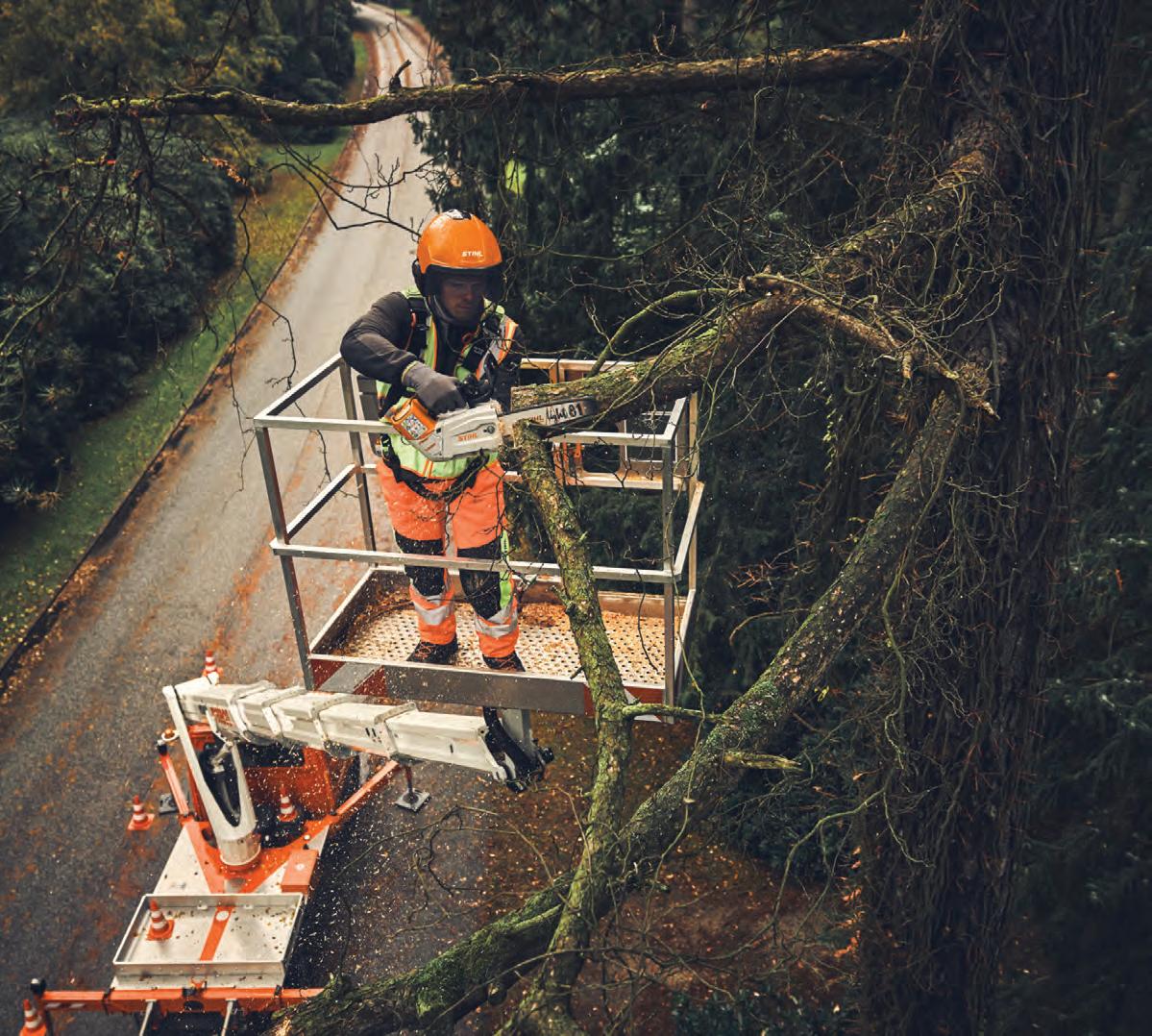



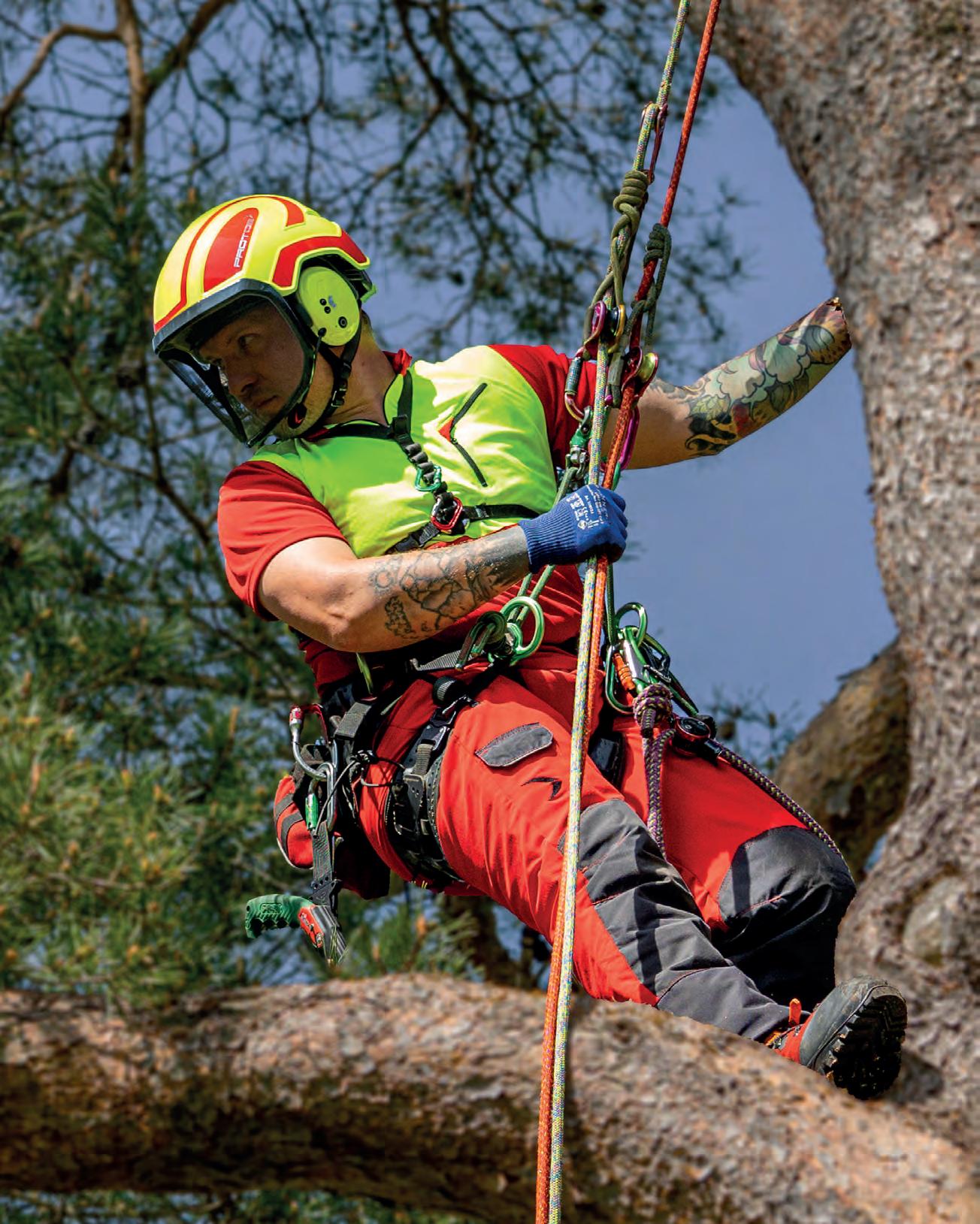


PROFESSIONAL TREE CARE FOR TREE SURGEONS






2025 • VOLUME 12 • ISSUE 05
This ‘Pro Arb Live Special’ issue brings you the wealth of knowledge presented at FutureScape’s first dedicated arboricultural theatre.
Across the two-day event, a consistent focus in the theatre was on how collective action from diverse sectoral perspectives can achieve meaningful and valuable change, elevate skills for individual professionals, and improve business practices.
Turn to page 17 for a full rundown of Pro Arb Live’s sessions. Don’t miss the lively discussions on attracting the next generation into arb and the critical role of regulation and accreditation in uplifting the industry. Likewise, on page 30, we showcase insights from day two of the Arboricultural Association Conference, featuring expert analysis of emerging trends, new research, and their implications for modern practice.
ALL ENQUIRIES
Tel: 01903 777 570
Eljays44 Ltd
BizSpace, Courtwick Lane, Littlehampton, West Sussex, BN17 7TL
EDITORIAL
Deputy editor –Edward Brown edward.brown@eljays44.com proarbeditor@eljays44.com
Content director –Nina Mason nina.mason@eljays44.com
Content subeditor –Carmel Mary carmel.mary@eljays44.com

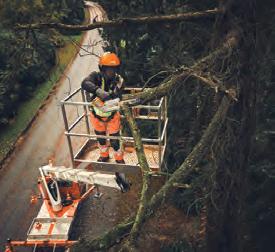

On page 28, read about a recent Honey Brothers event celebrating 70 years in business, which highlighted the latest innovations from arb suppliers –pay particular attention to the work of Terry Banyard from Notch and Daniel Ball from Medi Arb. In a similar vein, Pro Arb attended a Stihl press conference at its German headquarters (page 34). At the conference, the manufacturer seized the opportunity to share its perspective on the global machinery market and announce its future lineup, as well as its research and development roadmap.
In a different turn, page 13 contains our lead interview with Luke Fay of Treework Environmental Practice, who analyses the ecopolitical consultancy landscape and presents a vision for a more professionalised advocacy of the arb sector. Meanwhile, on page 10, the
charity Tree Aid, founded by Fay’s father, explains its work using trees to combat climate change and poverty in Africa.
Finally, turn to page 58 to see the latest submission for the Arb in Action competition, in association with Outwear. After weeks of reviewing an incredible array of submissions from across the industry, we are proud to present the finalists and announce the winner. Each photograph masterfully captures the skill, passion and artistry at the heart of modern arboriculture. Email proarbeditor@eljays44.com to submit your pictures for the December/January competition.

EdwardADVERTISING
Commercial director – Luke Chaplin
luke.chaplin@eljays44.com
Tel: 01903 777 582
Sales executive – Ollie Finch
ollie.finch@eljays44.com
Tel: 01903 777 579
MARKETING
Marketing executive – Kiri Shaw
kiri.shaw@eljays44.com
Tel: 01903 959 408
PRODUCTION
Senior designer – Kara Thomas
Printed by Stephens and George Ltd
Published by ©Eljays44 Ltd
CIRCULATION
Subscription enquiries –Ollie Finch
Pro Arb is published six times per year by Eljays44 Ltd. The 2025 subscription price is £50. Subscription records are maintained at Eljays44 Ltd, BizSpace, Courtwick Lane, Littlehampton, West Sussex, BN17 7TL, UK. Articles and information contained in this publication are the copyright of Eljays44 Ltd and may not be reproduced in any form without the written permission of the publishers. The publishers cannot accept responsibility for loss of, or damage to, uncommissioned photographs or manuscripts.
ollie.finch@eljays44.com MANAGEMENT
Managing director – Jamie Wilkinson
jamie.wilkinson@eljays44.com
Divisional director – David Griffiths
david.griffiths@eljays44.com
FOLLOW US ONLINE proarbmagazine.com
Follow us on X @ProArbmagazine
Like us on Facebook Proarbmagazine

Connect to our LinkedIn group Pro Arb UK
For careers in arboriculture and horticulture go to: horticulturecareers.co.uk
If you would like to send us press releases to post online,
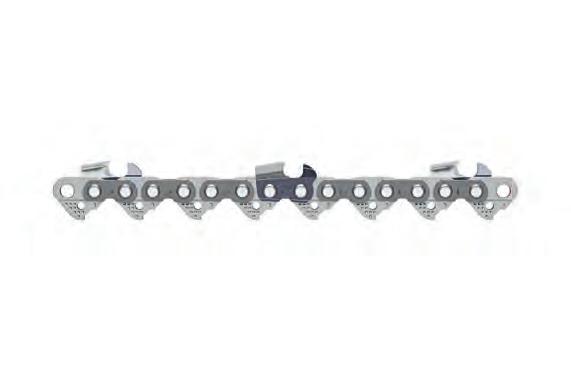
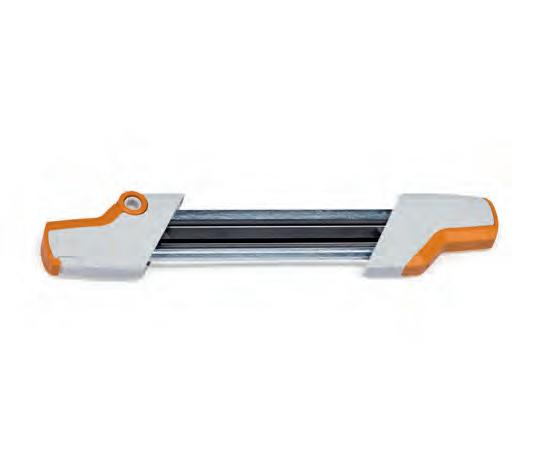
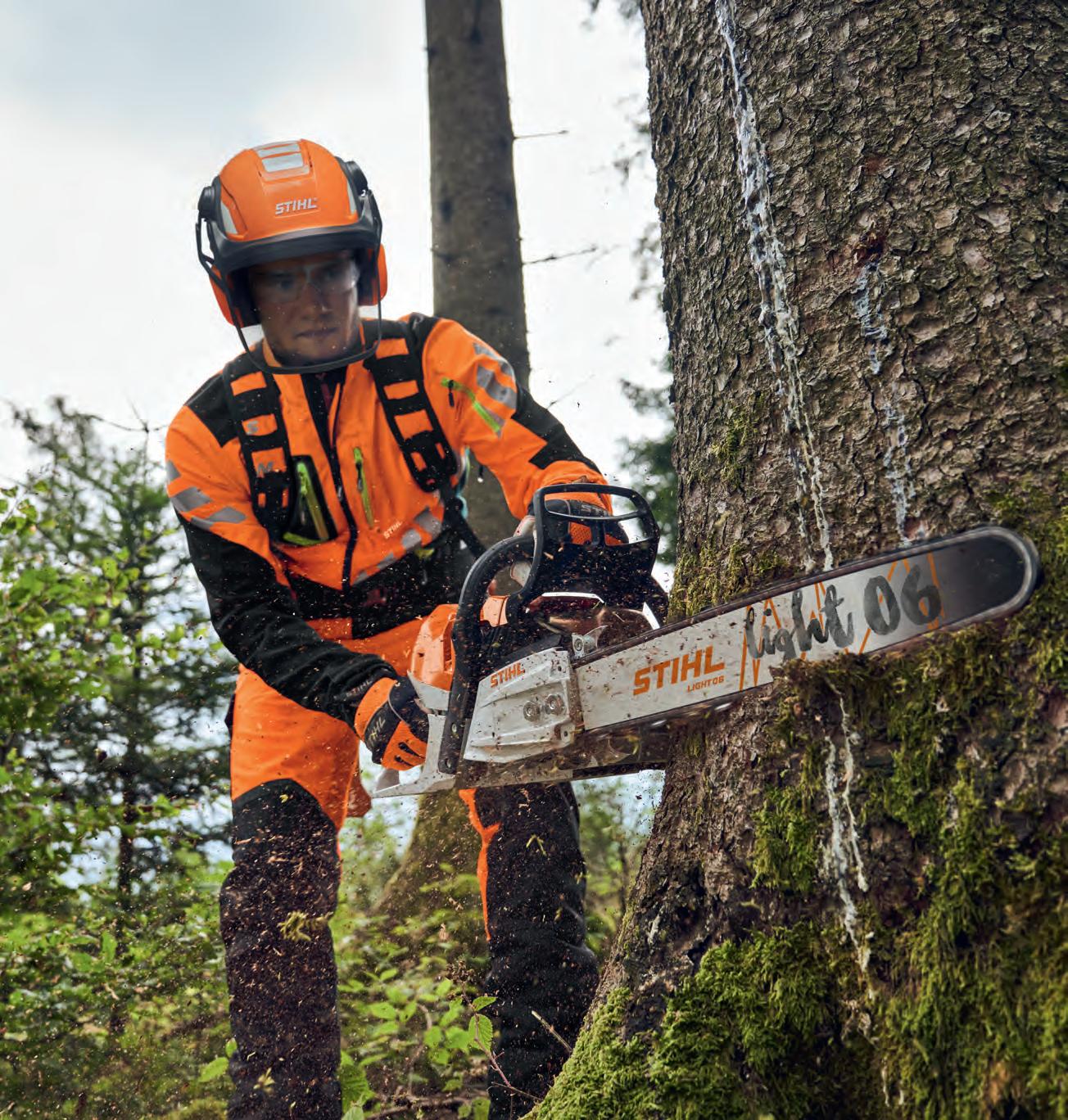
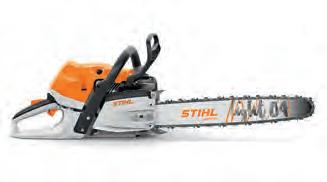
Get a free saw chain plus a 2-in-1 EasyFile this Autumn when you buy selected STIHL petrol and battery chainsaws and pole pruners.
Petrol models: MS 151, MS 151 T, MS 194 T, MS 201, MS 201 T, MS 261, MS 271, MS 291, MS 391, MS 400, MS 462, MS 500i, MS 661, MS 881, HT 105, HT 135
Battery models:
MSA 160, MSA 161 T, MSA 190 T, MSA 200, MSA 220, HTA 66, HTA 86, HTA 135, HTA 150, HTA 160
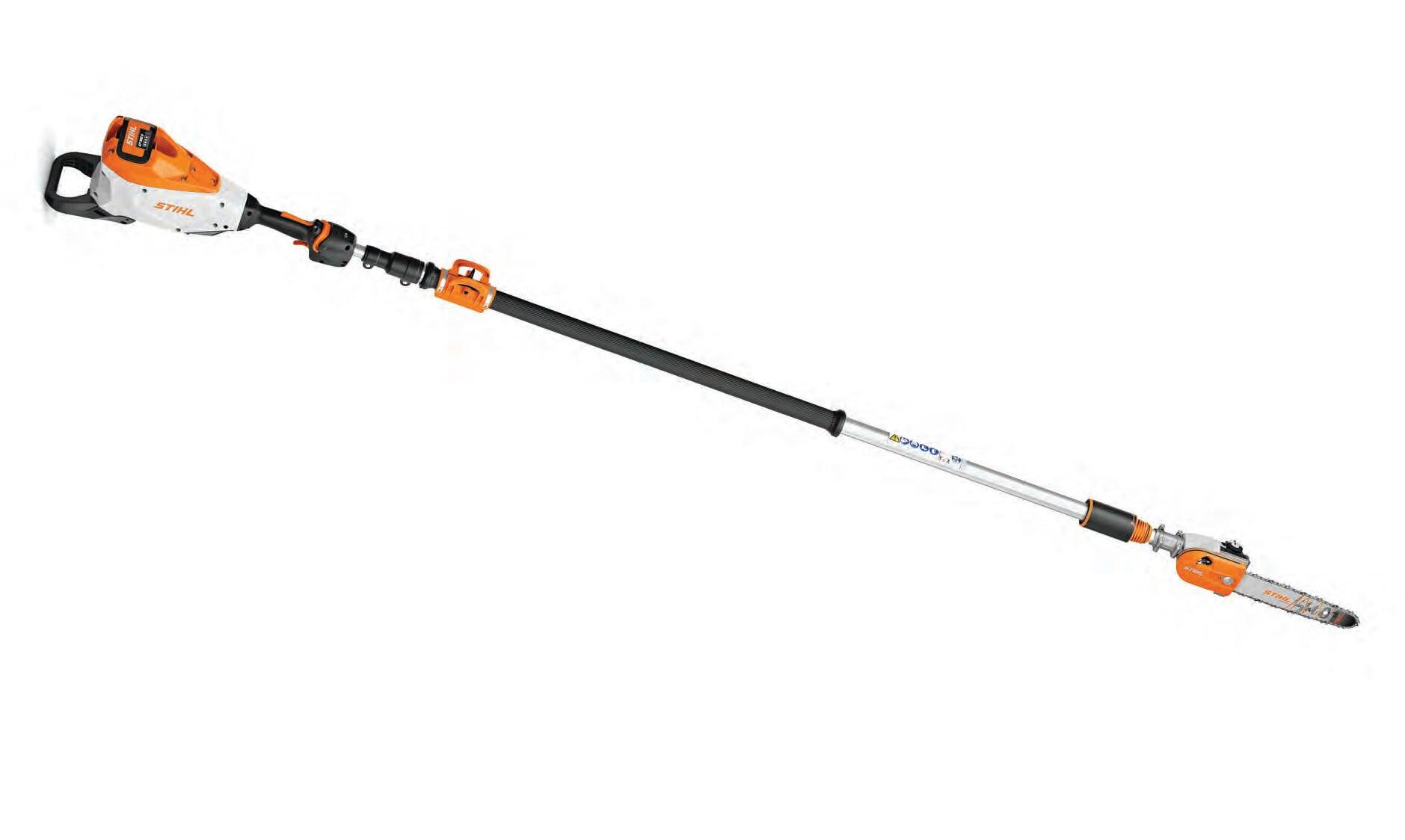
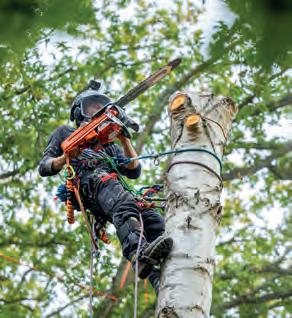


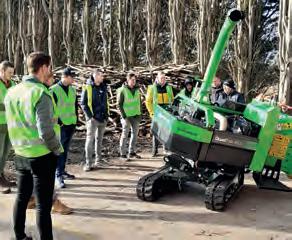
Luke
Keeping warm and sweat-free with Woolpower
With GreenMech and Vermeer
A
Why urban greening is essential?
What to know about the legal and medical risks?
Honey Brothers celebrates its
Henri
A ROUNDUP OF ALL THE LATEST ARBORICULTURE NEWS FROM AROUND THE UK. FOR MORE STORIES VISIT PROARBMAGAZINE.COM
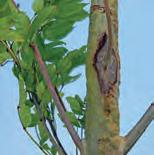
A study published in August, led by the UK Centre for Ecology and Hydrology, has concluded that the carbon sequestration cost of ash dieback is larger than previously thought. The disease has killed an estimated 9m UK ash trees, with 100m more expected to die, reducing the atmosphere’s CO2 removal.
The research, the first to account for the entire ecosystem’s carbon cycling, estimates that soil losses from ash dieback resulted in 5.8 million tonnes of CO2 emissions over five years. Dr Fiona Seaton, the lead author, states: “Tree disease is a triple whammy for climate change mitigation. A lot of future net zero plans assume a certain level of forest carbon sequestration, but this is threatened by the exponential increase in tree diseases such as ash dieback in Britain and across the world.”
Chris Nichols of the Woodland Trust, a co-author, comments: “Not only does [dieback] jeopardise the wildlife that depends on ash and risk costing the UK billions of pounds in the future, but we are increasingly understanding what dieback could mean for climate change resilience. This kind of research is vital in refining our approach to woodland conservation.”
The UK government’s eradication programme has eliminated the spruce bark beetle from all outbreak sites in England identified in 2021. Known as Ips typographus, the pest was first discovered in the UK in 2018 and can attack healthy spruce trees under specific conditions.
After three years of monitoring 13 sites, the Forestry Commission confirmed the eradication of the beetle. Dr Anna Brown, Forestry Commission director of forest services, comments: “The success of our eradication and monitoring programme shows that we are managing to keep this pest from establishing in England, but this takes a huge amount of effort and the

continued support of the woodland and forestry sector.”
While eradicated as of 1 September, the government urges landowners to remain vigilant and report any sightings via Tree Alert. Unmanaged, the pest could threaten an estimated 725k hectares of spruce.
George Trott, founder of G Trott Tree Consultancy, won the award for best arboricultural consultancy in Wales and the Southwest at the Prestige Business Awards in August. Trott remarks: “I think the real value in this for me is that I work

alone and that has pros and cons, one of the cons being that sometimes it’s hard to know if what I’m doing is the right thing. It really is extremely valuable and helpful to be recognised for such awards, as it shows I must be doing something right.” The Prestige Awards judge on excellence, innovation and sustainable practices. The 2025/26 ceremony was held at Bristol’s Ashton Gate Stadium. Trott, a previous 2020 Pro Landscaper 30 Under 30 winner, established his own consultancy last April.
gtrotttreeconsultancy.co.uk
In August, a study published in Evolutionary Applications from the Royal Botanic Gardens, Kew, and Forest Research evaluated whether planting trees or allowing natural colonisation creates more genetically resilient woodlands. This research will inform the UK’s goal to reach 16.5% canopy cover in England by 2050.
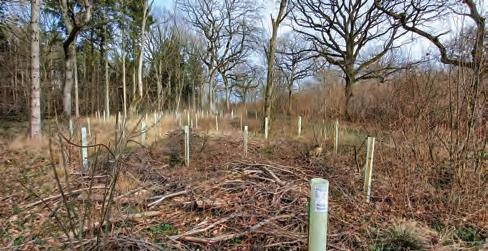
Scientists compared the genetic diversity and health of English oak and silver birch in both planted and naturally colonised sites. They concluded that both methods can create healthy forests locally. However, natural colonisation alone is insufficient for meeting national targets due to the fragmentation of woodlands.
Dr Guillermo Friis, the paper’s first author, explains: “A remarkable finding of our study was that inbreeding – the loss of genetic diversity that occurs when closely related individuals reproduce –was twice as high in naturally colonised
young forests compared to planted ones. This is likely due to the lack of connectivity between forest patches, often isolated by large areas of farmland. By choosing seed sources carefully, planting can help grow forests that stay healthy and adaptable over time.”
Conversely, planted woodlands were less diverse than expected, as seeds are often sourced from limited areas. The study recommends a “hybrid approach” and that conservation programmes prioritise collecting seeds from a broader range of trees to better balance genetic diversity with local adaptation. kew.org forestresearch.gov.uk
The Forestry Commission secured its highest-ever penalty for unlicensed tree felling in August. A contractor was fined £30k for illegally felling 586m³ of woodland

near Belford, Northumberland, in early 2023. The landowner was also fined £400 for the same offence, which violates the Forestry Act 1967.
In a statement, the commission emphasised that restocking notices, which require landowners to replant trees, are standard in such cases. Failure to comply can lead to an Enforcement Notice, mandating not only restocking but also a decade of maintenance. The substantial fines signal that unlicensed felling, where a licence is required, is a criminal offence.
One of the UK’s largest cell-grown tree nurseries, Alba Trees, partnered with agri-tech start-up Re-Genus in August to roll out a new biogenic growing system called Woodland Grow. The initiative aims to plant five meters trees over three years to support the UK’s climate targets. The system replaces synthetic fertilisers and peat with a fungi-rich microbiome, mimicking healthy woodland soil to promote long-term

tree health. Over one million trees have already been grown using the method in biodegradable Ellepot paper pots, with most of the initial batch already sold.
Gavin Adkins, CEO of Euroforest Silviculture, reports: “If this system consistently delivers higher survival and growth rates post-transplant, it’s a game-changer for the economics of reforestation and woodland creation.”
Craig Turner, CEO of Alba Trees, says: “This partnership embodies everything we believe in –innovation, sustainability and quality. By combining Alba’s proven nursery systems with Re-Genus’s microbiome expertise, we’re growing trees with the future of the planet in mind.” albatrees.co.uk re-genus.co.uk
Tubex has announced that all its recyclable tree shelters are now being produced using at least 50% recycled content. Available for the 2025/26 planting season, the standard shelters of all heights, including the Shrubshelter and Easywrap range, will incorporate an increasing proportion of material from used shelters.
The manufacturer states this improvement is part of its broader goal to enhance product sustainability. Dean Latten, Tubex’s plant director, explains: “It was always our goal to maximise the amount of recycled content in our shelters, but we needed to ensure that we could manufacture consistently at that increased level. Thanks to a brilliant effort from our team in Aberdare, we
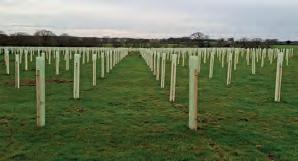
are now able to do this. This is the same leading recyclable shelter range that thousands of landowners and foresters trust, just made with more recycled material.”
Tubex reports these shelters to have the lowest carbon footprint in its lineup and to be fully recyclable, creating a closed-loop system. The company says this allows contractors and landowners to minimise waste, comply with regulations, and reduce the long-term environmental impact of planting projects.
tubex.com
In September, Simon Rotheram managing director of Beechwood Trees and Landscapes, was elected to the board of trustees of the Arboricultural Association.
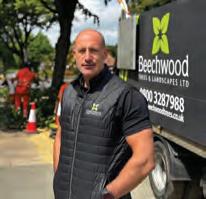
Selected by a vote of his peers, Rotheram will help set the Association’s strategic direction and
ensure legal compliance.
On his election, Rotheram writes on LinkedIn: “I’m truly honoured to have been elected as a Trustee. A huge thank you to everyone who supported me. I’m really looking forward to getting involved, working alongside such passionate people, and playing a part in shaping the future of our amazing industry.”
Trustees for the Association are volunteers and can serve a maximum of three consecutive three-year terms. beechwoodtrees.co.uk
Seeds from a ginkgo tree that survived the 1945 atomic bombing of Hiroshima have been entrusted to the University of Leicester. The gift from the Japanese organisation Mayors for Peace marks the 80th anniversary of VJ Day on 15 August.
The seeds were harvested from a tree in Hiroshima’s Shukkeien Garden, a living witness to the atomic bombing of the city. Leicester mayor Peter Soulsby states: “In Japan, the trees that miraculously survived the horrors of Hiroshima and Nagasaki are called ‘hibaku’ – or survivor trees. The fact that green shoots and new life could emerge from such devastation is an extraordinary symbol of hope – but as we approach the 80th anniversary of VJ Day, I hope that the ginkgo saplings that will grow from these hibaku seeds will also become a lasting symbol of peace here in Leicester.”
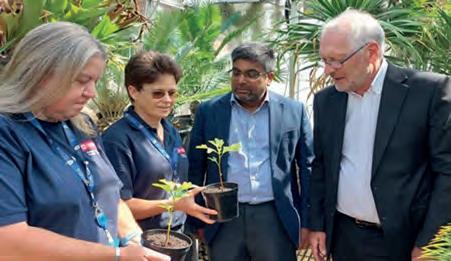
Canagarajah, the university’s president and vice-chancellor, says: “The university is truly honoured and humbled to have been chosen to grow and nurture these precious seeds on behalf of the city of Leicester. I hope the saplings will grow strong and tall and serve as living memorials to the people who lost their lives in Hiroshima and Nagasaki.”
le.ac.uk/botanic-garden
Once grown into saplings, they will be planted in the University of Leicester’s Botanic Garden, with others distributed across the city. Professor Nishan




The world’s first Husqvarna chainsaw with fuel injection

It’s an immediate feeling. The power and acceleration. The speed. Husqvarna 564 XP® is your shortcut to the pure joy of cutting. Innovation at its very best. With Husqvarna Fuel Injection technology, you get to enjoy instant acceleration and power delivery, all wrapped up in a tight, slim package. The power of a 70cc Husqvarna saw with the size of a Husqvarna 50cc saw. A groundbreaking landmark that will make you feel unstoppable. An instant winner. Feel it, try it, run it. Go. Experience your new instant favourite at your Husqvarna dealer or read more at husqvarna.com/uk/chainsaws/564xp-fuel-inject/

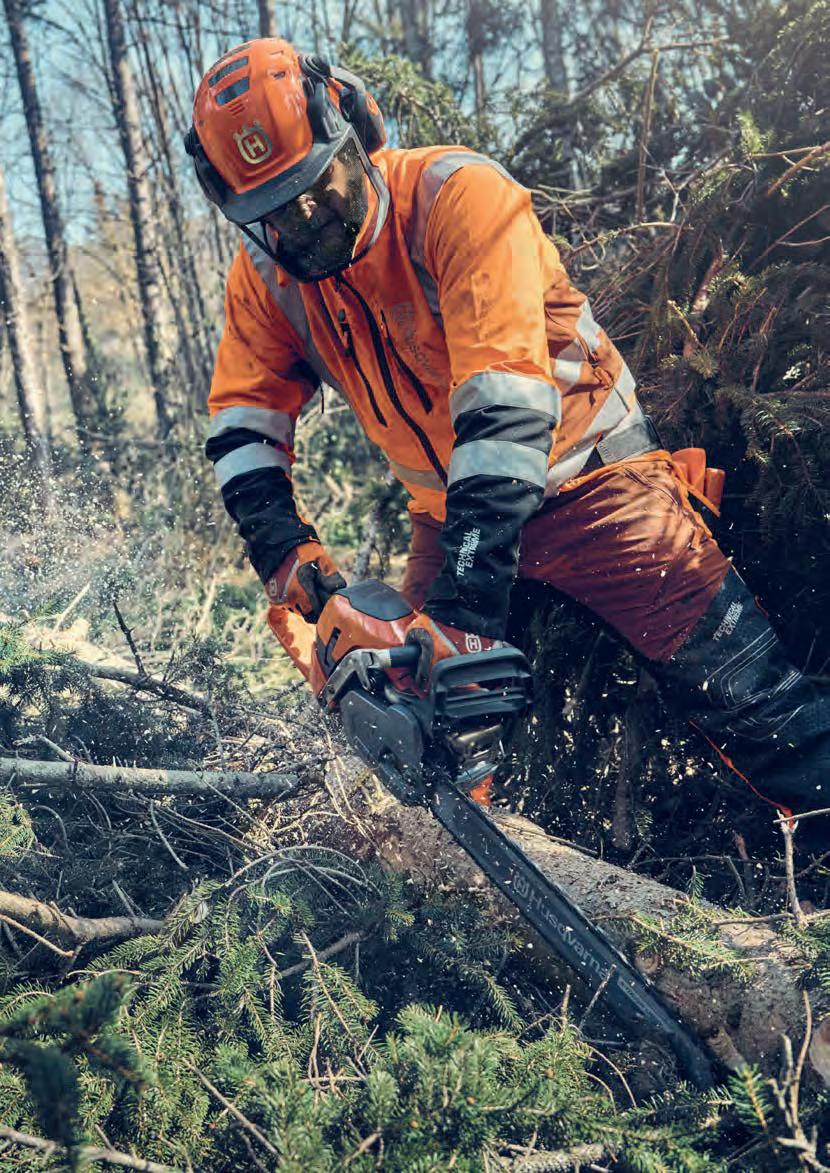

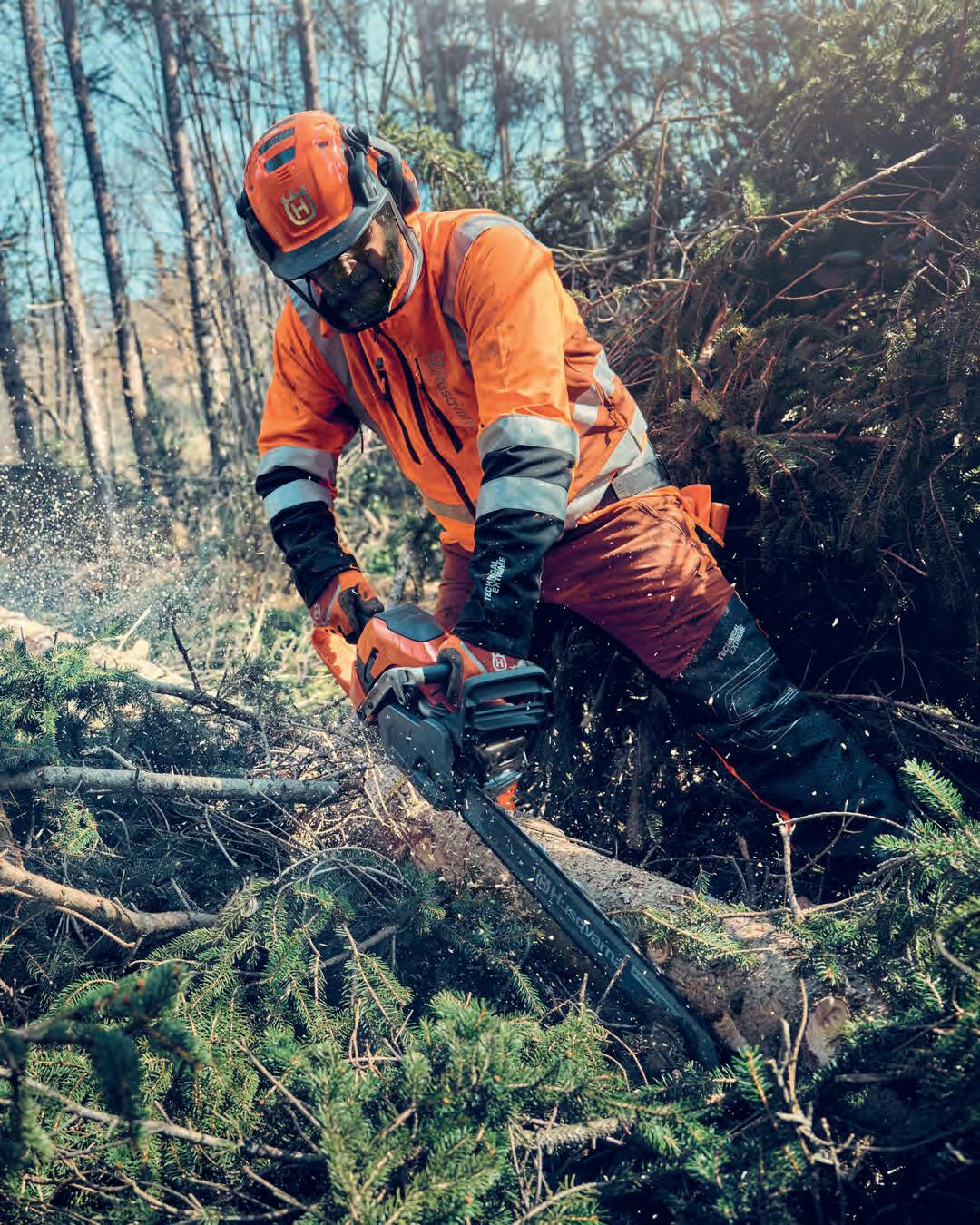


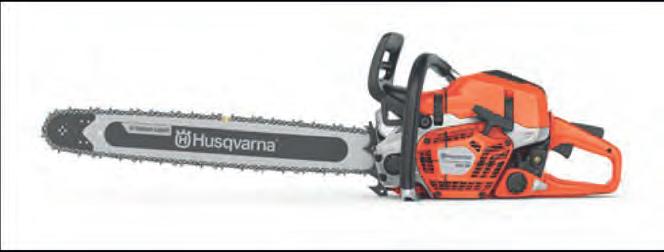
In 1987, arborist Neville Fay and others in the tree care industry founded Tree Aid in response to the devastating famine in Ethiopia. While the 1985 Live Aid concert provided the inspiration for public mobilisation, Tree Aid’s mission was related, although distinct: to offer a long-term solution to the persistent issues of poverty
and environmental degradation once African famine relief had ended. Today, in the context of climate change-caused land degradation, drought and insecurity, Tree Aid’s work across six African nations – Mali, Senegal, Ghana, Niger, Burkina Faso and Ethiopia – is arguably as essential as it was when it was founded.
At the event, Tree Aid patron and actor, Adjoa Andoh, of Casualty and Bridgerton fame, presented the journey and transformation for communities like one in Yendi, Ghana, where economic survival once meant making charcoal. However, she reveals a new path, “From chopping down trees, burning trees, to growing trees,” fostering sources of both environmental and local economic resilience.
Andoh also shared the poignant story of Wumbei Wunaya, whose family struggled when the river dried up. Now, her community tends a Tree Aid-sponsored nutrition garden. The
impact on Wunaya’s life was tangible. “The project has brought us a nutrition garden, moringa and vegetables, which we’re able to consume at home,” Wunaya is quoted. “There was nothing like this in the dry season before. We’d have to rely on our okra for the entire season.” Andoh adds that the women now grow trees to shade and protect the soil, and harvest fruits like moringa leaves, mangoes and shea nuts to produce shea butter, creating new avenues for income.

She concludes by linking these deep-rooted connections to the urgent work of the present. “The trees we grow through the work of Tree Aid are a mighty and effective bulwark against the effects of the climate crisis,” Andoh says. “The continued support for our work means change for the better can happen and be sustained,” she affirms, ensuring that stories of struggle are steadily being rewritten as narratives of growth, self-sufficiency and enduring hope.
Tree Aid reports progress in African dryland restoration Programmes manager Lucy Swain detailed the charity’s achievements over the past year and its calculated approach to combating poverty and climate change in Africa’s drylands. In the 2024/25 period, she reports that Tree Aid supported over 1.2m people and expanded into more than two hundred new communities across all countries. “These communities are in rural areas, and they typically depend on trees for their livelihoods,” Swain states. The charity also promoted the sustainable management of over 24k hectares of land.


A key initiative involves working with community groups, known as Village Tree Enterprises, which are often women-led. These groups, Swain continues, “harvest and sell non-timber forest products such as shea, dawadawa and baobab”, supporting them to “generate new and diversified sources of income”. Swain explains this “whole systems approach ensures the change that we hope to achieve will be sustained and long-lasting.”
She highlights that planting interventions are an essential component of creating
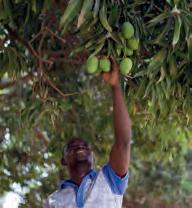
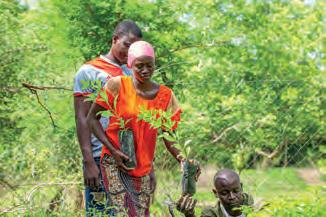
sustainable projects, for example, using techniques like demi-lunes (half-moons), which are crescent-shaped pits that collect rainwater, increase soil fertility and help trees survive dry periods. She shares a powerful observation from Senegal: after a fire swept through an area, trees protected by demilunes were regrowing, while other areas remained barren.
The impact is tangible. Swain reports that a recent project in Mali saw the “average annual household income rise by 386%,” with income from forest products growing by 720%. This led to 44% of participating households exceeding the poverty line. Concurrently, the project also improved nutrition. “We’re seeing that households are increasing their calorie intake,” Swain says, and “food insecurity is decreasing.”

Getting into the nittygritty of Tree Aid’s operations, Pietro Carpena, head of programme quality and advocacy, briefed on how the organisation uses its almost four decades of field experience to advocate for larger systemic changes,
moving outside direct community work to influence global policy. The charity works extensively with governments and international institutions to promote policies that put local people at the centre of natural resource management. “Rights and access to land are critical,” Carpena emphasises, noting that providing evidence on how resource access for women builds resilience is a “really powerful” tool for influence.
A cornerstone of this work is forest governance, which Carpena describes as “ensuring that the community itself can become the stewards of the land.”
Over nearly 20 years in Burkina Faso, this
THE CHARITY HAS SET A TARGET FOR 2027 TO CULTIVATE
initiative has worked with 18k households to create inclusive local structures, giving vulnerable groups a voice in managing the forests they depend on. This field evidence is captured in reports that Tree Aid has presented at global forums, such as the UN climate and desertification conferences. Its research focuses on critical gaps, such as climate finance failing to reach the communities most affected by climate change, while also ensuring that local voices are heard on the international stage.
Scaling up its initiatives
Tree Aid has outlined its ambitious strategy to expand its evidence-
Georges Bazongo, director of programmes, spoke about how longterm funding has been pivotal for the organisation’s success in Burkina Faso. Unlike other countries where projects are short-term, sustained support in Burkina has allowed for significant capacity building.

“In the state of Burkina Faso, for the forest governance project, we had over 17 years of funding from the Department for International Development and the Swedish Development Agency,” Bazongo remarks. “That has allowed us to build competencies, stories and knowledge, and that replicates in our mobilisation of the funding.” This enduring partnership has enabled Tree Aid to expand its proven model from Burkina into neighbouring countries, creating a wider impact across the region.
gathering efforts and share its methodologies across Africa and internationally. The charity has also set a target for 2027 to cultivate over 12m trees and restore 66k hectares of degraded land. A key component of its upcoming initiatives will be largescale tree planting projects aimed at enhancing carbon sequestration.
World Suicide Prevention Day was observed on 10 September under this year’s theme, ‘Changing the Narrative on Suicide’. The World Health Organization states that the theme’s central aim is to spark institutional dialogue and create supportive environments where individuals feel comfortable seeking help. But how does this dialogue translate from an institutional aspiration to a practical, peerto-peer conversation?

In search of an answer, Pro Arb Magazine sought best practice guidance from the suicide prevention charity Samaritans. In an interview, Samaritans listening volunteer Damon Preece brought to light the power of simple, non-judgemental listening as a key practical framework for colleagues and employers to follow when speaking with someone experiencing a mental health crisis or seeking an empathetic ear.
Samaritans’ active listening framework
‘Use open questions’, ‘Say it back’ and ‘Have courage’ – provides a clear, structured guide for navigating difficult conversations through active listening.
He comments that it begins with showing you care by giving the person your full attention, which Preece simplifies as “putting down your phone and looking at the person.” The next step is to have patience, as creating a safe, unrushed environment may take time for a person to feel ready to talk. Preece acknowledges that many people worry that reaching out to someone who seems to be struggling can seem intrusive; nevertheless, he adds, “You’ll soon be able to tell if the person you’re speaking to isn’t comfortable. If they don’t want to open up, you can let them know you’re there for them.”

Preece began by explaining Samaritans’ ‘SHUSH’ listening tips – a condensed version of the charity’s core training. The ‘SHUSH’ framework –denoting ‘Show you care’, ‘Have patience’,
“The key message is always going from a point of knowing nothing,” Preece continues.
The final tip is to have courage, which Preece identifies as often the most challenging part.


“Having worked in all-male environments, I understand how difficult it can be to begin a conversation about mental health,” he remarks. However, Preece reassures someone who is concerned about a colleague not to be put off by a negative response and to remember that silence does not need to be filled.
For those who lack confidence, Preece stresses that what is aimed for is not to be a professional therapist, but to offer support. “We as Samaritans are not professional therapists either,” he notes, highlighting that the Samaritans’ helpline (116 123) is a free, 24-hour resource for anyone struggling.
Another key component is open questions, which Preece describes as a “Samaritan superpower”. These are questions that get more than a ‘yes’ or ‘no’ answer. It is also crucial to say what is communicated back, checking your understanding by reflecting, what you heard by not offering a solution.
When asked how businesses can move from discussion to actionable support, Preece recommends that they proactively seek mental health first aid training. “If they want, businesses can also contact their local Samaritans branch; we can come along and deliver a talk on the SHUSH tips.”
For more information, visit: samaritans.org
ARBORICULTURE IS INFLUENCED BY SHIFTING ECONOMIC AND POLITICAL ENVIRONMENTS. LUKE FAY OUTLINES THE CURRENT LANDSCAPE AND SUGGESTS A COHESIVE STRATEGY TO SECURE THE INDUSTRY’S FUTURE

At the Institute of Directors on Pall Mall, Luke Fay, managing director of Treework Environmental Practice, spoke with Pro Arb Magazine about the legacy and current state of arboriculture. In that fitting setting, the discussion focused on the sector’s challenges and ways to enhance its image and purpose in a new technological era. Fay emphasised the need for arboriculture’s leaders to understand the external environment -political, market-driven, and social - to create effective strategies for the future.

Taking decisions at the crossroads: pioneering and steering Fay describes his entry into arboriculture as “privileged”. In the 1980s, after responding to the devastation of Dutch elm disease with a Stihl chainsaw and a transit van, his father, Neville Fay, founded Treework Services, a tree surgery and hardwood flooring company that began taking on consultancy projects as it expanded. “I started to do those consultancy projects for local authorities in the ‘90s. However,
Neville later sold the tree surgery, timber processing and flooring business but kept the consultancy and came to work with me as co-directors of Treework Environmental Practice,” Fay explains. “My dad has been a visionary in our field for decades. His career is marked by a series of foundational achievements, including Tree Aid in 1987, then being one of the founders and the first Chair of the Ancient Tree Forum, and later taking a leading role in the inception and achievements of the
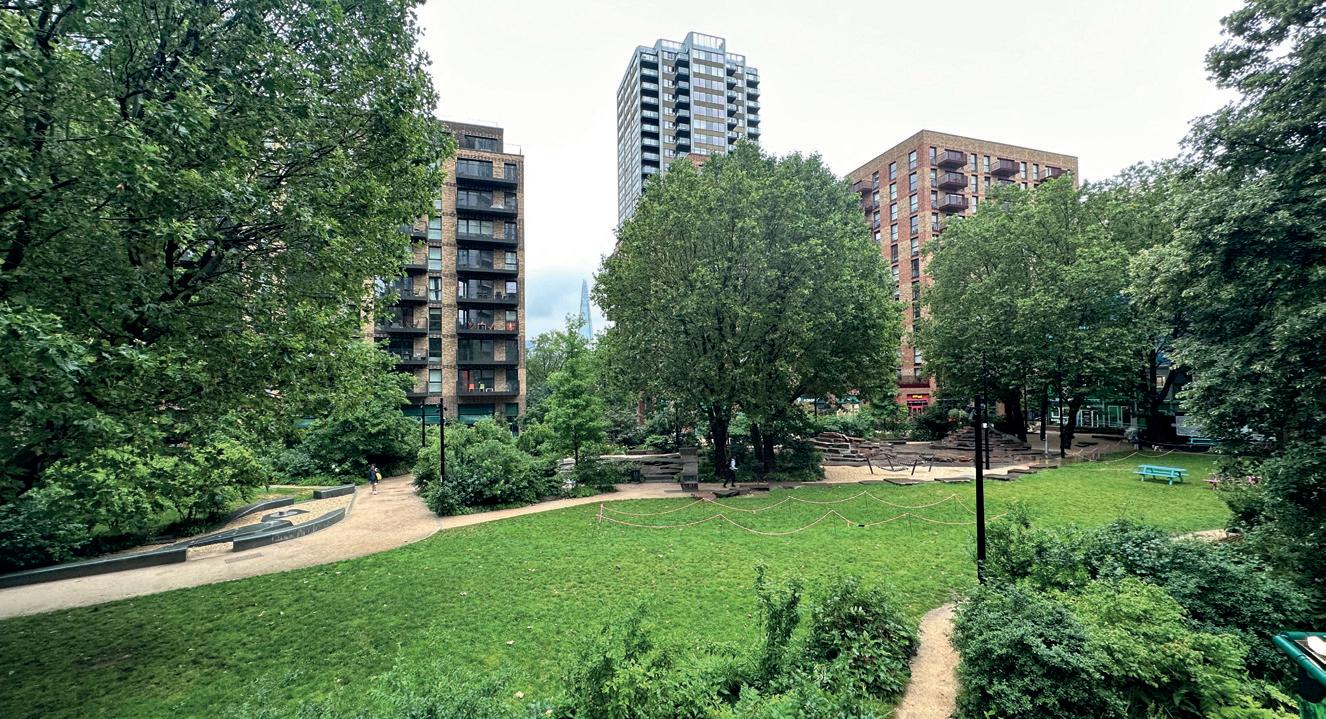
In 2012, Treework acted as the project arboriculturist for the Outline Planning Application for the Elephant Park regeneration scheme, which replaced the Heygate Estate. The approved plan permitted the removal of 283 trees out of the 406 mature trees, retaining 123. Further arboricultural design input
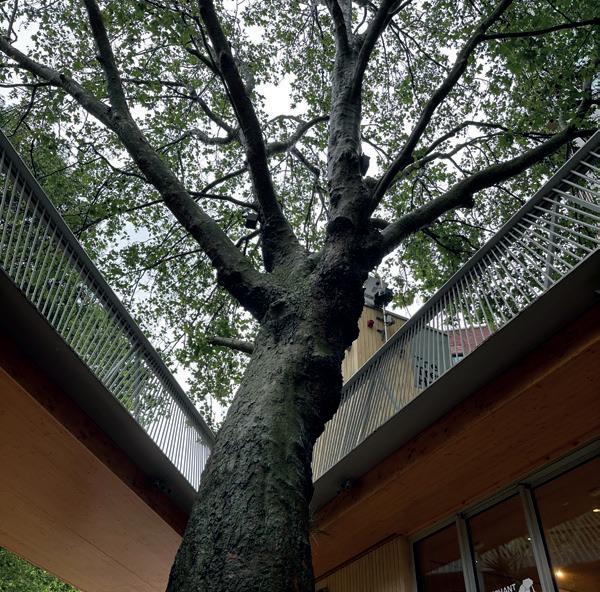
retained 5 more trees bringing the total number of retained trees to 128. By modelling tree growth and utilising a CAVAT (Capital Asset Value for Amenity Trees), Treework supported the project’s goal of developing a landscape with a fifty-year head start, achieving a CAVAT value that surpasses that of the original tree population by five percentage.
The scheme has planted over nine hundred trees in Southwark, increasing the area’s total tree number by 1% and enhancing the Council’s tree resource by 1.6%. Additionally, i-Tree calculations estimate that these trees will contribute £12,600 per year in ecosystem services.
The project has won multiple awards and serves as a study tour destination for built and natural environment professionals.
National Tree Safety Group. He then went on to establish, with my sister Ellen Fay, the Sustainable Soils Alliance, an organisation whose influence continues to grow.”
Throughout his own career, which spans over a quarter of a century, Luke Fay has continued his father’s legacy of pioneering within arboriculture. His leadership has been instrumental in delivering arboricultural consultancy on award-winning landmark projects, from the iconic London 2012 Olympics sites within historic settings of the Royal Parks and Hampton Court Palace to the multi-million-pound Elephant Park regeneration in South London, as well as the careful stewardship of nationally important ancient trees in highly sensitive historic sites. Moreover, beyond his work at Treework Environmental Practice, Fay has dedicated considerable effort to elevating the entire sector. He has contributed to shaping its future through roles with the Landscape Institute’s Digital Practice Group, the London Tree Officers’ Association’s Diversity and Inclusion Working Group and
WE PASSED OUR 40TH YEAR IN 2023, AND I FIND MYSELF IN THE COMPANY OF PEOPLE, WHO ARE DEEPLY DEDICATED TO THE SUCCESS OF TREEWORK, INCLUDING SOME OF THE LEADING PROFESSIONAL TREE EXPERTS IN THE UK
the CAVAT Group, while also helping to steer professional development and research initiatives such as the Arboriculture and Forestry Advanced Apprenticeships Group and the Communitree Project with Forest Research and the Open University. Fay has grown the company into one of the largest arboriculture-only practices, with nineteen people, including dedicated operations and sales managers, its own tree management software, a national presence
and an innovative home-working structure.
Fay says, “We passed our 40th year in 2023, and I find myself in the company of people, in all parts of the company, who are deeply dedicated to the success of Treework, including some of the leading professional
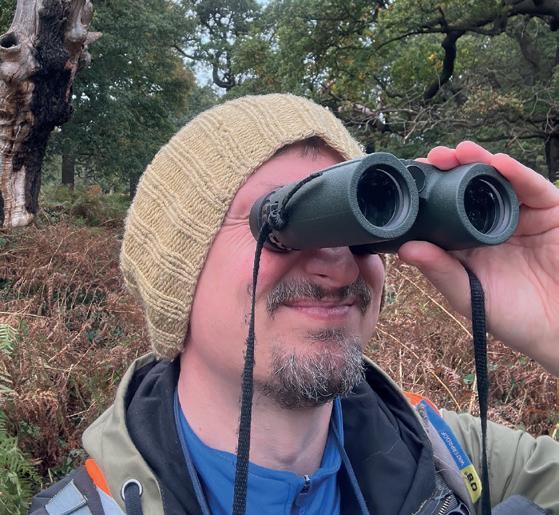
tree experts in the UK. We are building a team of the next generation of leading arboriculturists. It’s humbling.”
Across his professional life, Fay notes that running a business has made him aware of the flow of economic and political tides and how they can influence industry-level opportunities. The 2008 financial crash reshaped arboriculture. Pre-crash, Fay recalls that work was plentiful as demand for arboriculturists was booming, as they provided services to a growing development sector. Post-crash, “developers were much more cost-focused,” Fay explains. The arboricultural input, always a minuscule part of a development’s overall budget, was relentlessly squeezed, seen not as adding value but merely mitigating risk. However, he says a corrective shift began around 2018, as a growing public and political awareness of climate change, symbolised by grandiose pledges to plant “a billion trees”, suddenly made trees a headline feature. “This is the moment arboriculture still needs to grab,” Fay comments, “because potentially it may not be here forever.”
The succession crisis
Perhaps the most pressing long-term challenge for the industry that Fay identifies is a simple one: people, or a lack thereof.
“Bringing people into arboriculture has been a passion of mine for a long time,” he states. The data, however, is alarming. The number of people entering college courses is “minuscule”, and many of those who do complete them return to practical tree surgery rather than moving into consultancy.
Returning to Fay’s use of the word “privilege”, the root cause behind the recruitment crisis, he believes, is a profound lack of awareness – young people are not being given the “privilege” of learning about the industry. “People don’t know about arboriculture.” He contrasts it with the highly successful campaign by the Royal College of Engineering, which made “engineer” a top career aspiration for schoolchildren almost overnight. “If they don’t know that they can work with trees, how will they consider getting into the industry?”
One often overlooked element of the recruitment crisis, on which he has worked with the London Tree Officers’ Association’s Diversity and Inclusion Working Group, is the stark lack of diversity and representation in consultancy and on-the-tools arboriculture.
Using London as an example, Fay notes that global majority people make up roughly half the city’s population, yet this is not reflected in council tree officer teams. “The biggest barrier”, he suggests, is again, “people aren’t aware that it’s something that they could do.” The arb industry often attracts talent through family connections and experience, which limits
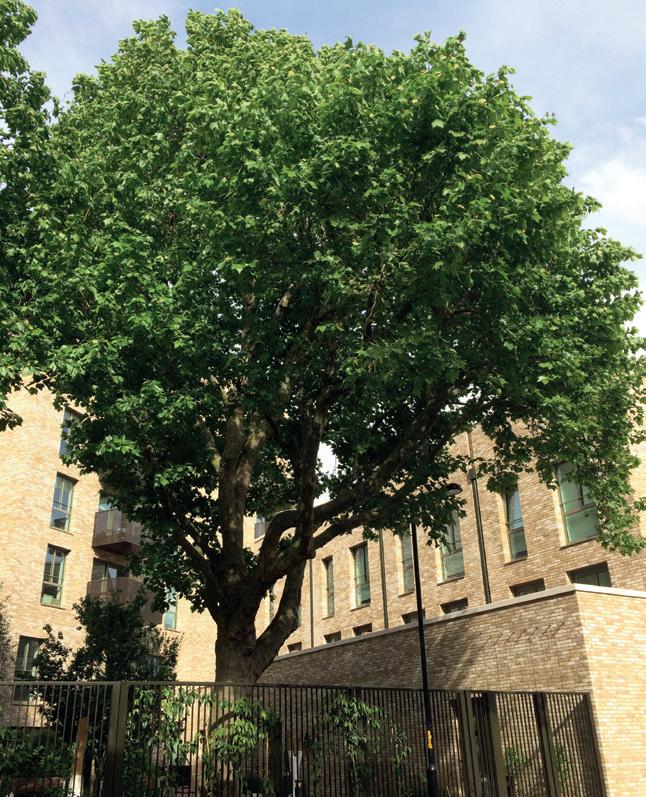
its pool of talent and perspective.
Luke highlights that those issues in the arboriculture sector are gaining attention, particularly from the Arboricultural Association, which has succeeded in getting
BRINGING PEOPLE INTO ARBORICULTURE HAS BEEN A PASSION OF MINE FOR A LONG TIME
arboriculture to be included in career advice and has launched an Arb Ambassador Scheme for schools. Fay, for his part, at Treework has established a structured career path with six grades, emphasising mentoring and training, and views new professional apprenticeships at Levels 4 and 6 as crucial for future growth. However, this requires businesses like Treework to confidently invest amid ongoing uncertainties.
The looming political shock to consultancy The greatest immediate uncertainty, Fay plainly describes, is political. The UK government’s proposed planning reforms, specifically the idea of a “Nature Restoration Fund” or off-site mitigation, could, in his view, trigger a dangerous crash for the environmental consultancy industries, including arboriculture.
Currently, developers are typically required to follow a “hierarchy of if you can retain, retain”, i.e., in terms of arboriculture: retain trees on-site, replace them on-site, possibly replace them off-site, or, as a last resort, pay for compensation. Luke says, “With arboriculture, there is another layer to this hierarchy, because big trees provide exponentially more benefits than smaller or newly planted trees, so retaining large trees and providing them with the space above and below ground to flourish, is massively important for creating liveable places and supporting nature.” When this system works well, arboriculturists are engaged in the design process from the start.
The ‘Planning and Infrastructure Bill’ (currently progressing in the House of Lords) could provide a mechanism for developers to
sidestep that process and only pay into a central mitigation fund. “The imperative for the private developer is to maximise returns to shareholders,” Fay notes. Each milestone in the planning process represents an element of project risk overcome with associated capital release. If the quicker or cheaper option is to offer to pay for the environmental impact, supported by an assumption that planning decisions will be made in favour of housing, the intricate and valuable work of integrating trees into developments could be left for post-planning conditions or excluded entirely. For the consultancy industry, where maybe 50% to 70% of all work comes from planning and development, this is an existential threat to the profession.
“If that happens,” Fay says, “we will see a crash in the sector.” Consequently, he is engaging with professional bodies, including the Arboricultural Association and the Landscape Institute, lobbying in favour of the natural environment. He adds:
“At present, there is an opportunity for consultancies from the house building target of 1.5 million dwellings for the end of this Parliament in 2029; likewise, a tremendous amount of value is added to the environmental outcomes of Nationally Strategic Infrastructure Projects, for meeting the UK’s net Zero targets, by having expert arboricultural input to avoid tree loss. However, at the same time, the proposed
reforms to planning are a threat to the whole Natural Environment sector, and although arboriculture is a tiny part of the sector in cost terms, it could well be a collateral victim of this bill.”
IT IS EVIDENT THAT THERE IS A WILLINGNESS TO SHARE DATA AND A DESIRE TO SEE IT USED. THIS DATA IS CRUCIAL FOR MAKING THE ECONOMIC CASE FOR TREES AND ENSURING THEIR SURVIVAL
Despite the challenges, Fay sees clear paths forward. The first is a need for industry data. Unlike other sectors, arboriculture lacks a routinely published “state of the industry” report. “In the arboriculture sector, consultancy practices are often grouped with larger aligned industries like tree surgery, forestry and horticulture, and arboriculture doesn’t even have its own Standard Industrial Classification. We need to know more about what the baseline we’re working from is; what is the ‘actual’ proportion of arboricultural consultancy that is dependent on planning
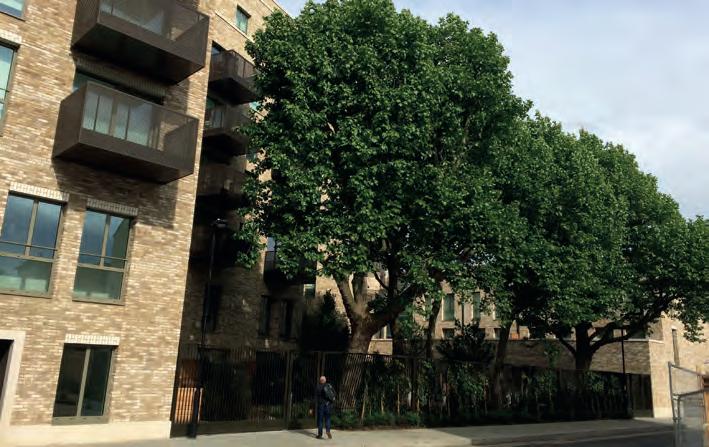
and development work? In addition to good information, a state of the industry analysis, at least on an annual basis, to help inform companies, outlining the threads of concerns and opportunities that relate to the sociopolitical and technological environments,” he argues. Accordingly, he proposes a regular survey, structured around a PESTLE (Political, Economic, Social, Technological, Legal and Environmental) analysis, to give the sector the structured, lay-of-the-land intelligence it needs to advocate for itself and plan for its future. He is also championing the power of shared data through initiatives like the Big Tree Data Project with the Open University. By pooling 28k digital tree records from councils and consultancies, the project has produced models of allometric relationships between the physical parts of trees for forty-six species / twenty-nine genera of UK trees. From this, he and project scientist Joe Fennell produced the ‘Handbook of Tree Allometric Equations and Size Characteristics’, along with the dataset containing the equations, both of which are available online for free. At the recent Arboricultural Association conference, Fay and Fennell presented on their findings. Fay reflects, “Arboriculturists have been early adopters of data and spatial technologies. From our recent workshops, it is evident that there is a willingness to share data and a desire to see it used. This data is crucial for making the economic case for trees and ensuring their survival.”
Ultimately, Fay’s vision is for a proactive industry, not reactive; valued, not tolerated. It requires a concerted campaign to make arboriculture a known and aspirational career, a political fight to ensure trees are seen as critical infrastructure recognised for their benefits and a business culture that can invest in the next generation. His goal for Treework is similarly forward-looking and profound: “To outlive the me and the people who are in Treework now.” For that to happen, his company and the industry as a whole must navigate difficult paths ahead. It must plant its right seeds for the future: attract the right people and convince a sceptical world that arboriculture is not a luxury, but a basic necessity.
ON OCTOBER 7-8, A FIRST-OF-ITS-KIND DEDICATED ARBORICULTURE THEATRE CAME TO FUTURESCAPE –PRO ARB LIVE . AT THE TWO-DAY EVENT, SPEAKER AND PANEL DISCUSSIONS OPENED A WINDOW INTO THE STATE OF THE INDUSTRY AND CHARTERED ROUTES FOR SOLUTIONS TO ITS SYSTEMIC CHALLENGES.
The first panel discussion at Pro Arb Live tackled the thorny issue of regulation, accreditation and compliance for tree surgery businesses, centring on the role of the Arboriculture Association (AA) accreditation scheme. The conversation between industry peers revealed a sector grappling with how to raise standards while making the path to accreditation more accessible for smaller firms.
For contractors, the journey to becoming ‘Arb Approved’ is known to be demanding. James Drewitt, managing director of CJ Tree Surgeons, describes it as “not an easy road,” involving learning a whole new system of procedures and documenting. Lawrence Thor, managing director of Thor’s Trees, echoes the same sentiment. He mentions that it can be “overwhelming for newcomers” and that the “expensive part is actually getting yourself up to becoming a compliant company.”
A salient theme noted was the ‘onesize-fits-all’ nature of the standards. Drewitt argues it is “infinitely harder” for a small company to implement all requirements compared to a large firm with dedicated management layers.
“To get more contractors onto the scheme… we need to make it easier for the smaller guys,” he remarks, suggesting better template resources could be a “great stepping stone.”
Tom Hamments, technical officer for the AA, acknowledged the problem.
“The Arb Association is very conscious of the issue and wants to do something about it,” he says, confirming his work on proposals of revised versions of the standards to make them “slightly simpler for smaller companies, and maybe slightly more complex for larger companies.” This could include an optional specialist models for bigger companies, and a dedicated accreditation focus on health and safety for smaller companies, leaving out the standards that may not be applicable.

customers to understand they should be “hiring somebody who has professional accreditation.” Likewise, Thor figures that the industry itself must champion the badge, saying, “We have a responsibility, as the people who are associated, to speak well and speak loudly.”
The panel agreed on the need for greater recognition. Becky Wilkinson, learning and outreach manager at the Royal Forestry Society (RFS), emphasises a market-driven approach, stating the overarching goal should be to get domestic
Despite the challenges, the panel’s managing directors affirmed the value of AA accreditation. Thor reasons that the scheme provides a framework for what is already a heavily regulated industry, showcasing that a business is operating legally and safely. “I know that it’s worth it in the end,” says Drewitt, a sentiment that encapsulates the industry’s complex relationship with its badge of quality.

Akey conclusion of the ‘Branching Out: Closing the skills gap’ panel discussion was that the arboriculture industry’s critical skills shortage is due to a systemic failure in creating accessible career pathways, not a lack of interest. The consensus was that while passion for the outdoors is abundant, practical and financial barriers are stifling entry.
Becky Wilkinson, learning and outreach manager at the RFS, stresses a primary bottleneck: geographical isolation from training. “Many people get in touch with the RFS, but their nearest college is going to be a two-hour drive, and instantly we’ve lost them,” she comments.
Awareness was identified as another major hurdle. James Drewitt, managing director of CJ Tree Surgeons, shared his own experience, observing that arboriculture was never presented as a career option during his schooling. “It was always land-based industries or agriculture or horticulture. I think there’s an awareness issue at the heart of this,” he says.
This sentiment was repeated by Dr Andy Hirons, senior lecturer in arboriculture at Myerscough College, who points to a “real visibility problem”, and by Mandy Maynard, head of industry partnerships for forestry and arboriculture at Lantra, who calls for elevating the profession’s status. “I hate it. I still hear it on a daily basis,
‘oh I’m just a tree surgeon.’ What arborists do is incredible, and that’s why we need to up it,” Maynard urges.
In overview, all panel participants agreed that the responsibility lies with the industry to proactively engage with schools. Wilkinson proposed a tangible solution: a grassroots campaign encouraging employers to become active ambassadors of the industry in schools and colleges. “My challenge to everybody here is to do one careers fair at a local school and talk about tree careers – because children don’t know enough about our industry as a career option.”
On retention, the discussion turned to pay and career progression, with Drewitt linking low wages directly to the difficulty of retaining staff in tree surgery. Although Helen Mallet, training provision manager of Vegetation Management Training, stresses that pay is only one side of the problem, another being the lack of clear internal career pathways. She advises employers to have early conversations about an employee’s aspirations for their long-term future, asking, “Where are you going next?”
To close the skills gap, all panellists determined that industry stakeholders must unite in a long-term effort to engage young people and create clear career pathways.
The journey to a more sustainable arboriculture sector will be a transition, not a sudden switch, requiring a pragmatic blend of battery power and cleaner fuels. This was the consensus from a panel of experts at Pro Arb Live, who debated the practical integration of new, greener technologies. From the front line, Dan Pennington, managing director of Connick Tree Care, details the current reality. “We probably use 40% battery, 60% petrol,” he says, noting the limitations of battery power for heavy-duty tasks. On the cost of cleaner alkylate fuels, Pennington was direct: “The main driver is cost. Until regulatory bodies bring in legislation to clarify that alkylate fuels are the basic requirement, there is going to be this issue with cost and competition.”


Advocating for alkylate fuels, Axel Hildebrand, business development manager of the Anglo American Oil Company, positioned Aspen Fuel as an immediate “drop-in” solution for operator health, arguing it can “reduce carcinogenic exposure by around a hundred times.” Likewise, to Pennington, Hildebrand envisages the need for a level playing field across the UK arb sector, suggesting the industry standards should be “petrol with alkylate.”
Manufacturer representatives on the panel offered differing timelines for the battery transition. Joerg Baumele, product
manager of EGO Power+, was optimistic about the increasing performance of battery equipment, citing rapid technological advances from the car industry. In contrast, Robert Trott, a tree professional specialist at Husqvarna, who is also a working arborist, envisioned a continued coexistence. “I don’t see alkaline taking over battery, the same way I don’t see a battery fully taking over alkaline. No, they work hand in hand 100%,” Trott says, emphasising that a tool-specific approach is likely to remain the standard for the foreseeable future.
Overall, the majority of panellists determining the industry’s green transition will rely on using the right tool for the job: battery power, where its performance is a ‘no-brainer’, and alkylate fuels in petrol equipment to immediately reduce environmental and health impacts. Nevertheless, many voiced that regulatory incentives are needed to level the playing field for users of greener fuels and battery equipment.

In a competitive industry, what is your edge? At the ‘Your Competitive Edge’ seminar, speaker Peter Wharton argues that it lies within an organisation’s workforce. The Director of Wharton Natural Infrastructure Consultants, named the 2025 Institute of Chartered Foresters’ Member of the Year for his neurodiversity work, asserted that fostering an inclusive environment is
a powerful business strategy.
“It’s not about what we don’t have, it’s actually how we do things differently,” says Wharton, who shared his own ADHD and dyslexia diagnoses. He urges leaders to move beyond traditional practices, suggesting “walk and talk” interviews and flexible hours. He adds, “Let’s work on how employees want to work,” detailing policies like quiet zones and assistive technology to help neurodiverse employees in the workplace. For Wharton, embracing neurodiversity and creating an adaptive environment is key to unlocking innovation and building a supported, productive team.
ARBORICULTURE STARTUPS: “BE AN OAK, NOT A WILLOW”

Entrepreneur George Trott, director of G Trott Tree Consultancy, recommends that new arboriculture businesses embrace calculated risks during his ‘From Startup to Scaling Up’ seminar. “You just have to say yes and then work like hell to learn how to achieve or perform the job you’ve just won,” Trott comments, sharing his own journey.
He emphasises that founders must wear many hats, from finance to HR, and cautioned against premature, large investments. “Is this purchase going to add value to the business? If the answer is no, then there’s a high likelihood you don’t need it,” he counsels.
Citing examples like Steve Jobs, Trott reframed failure as an essential step. “Failure isn’t the opposite of success. It is actually the first step towards it,” he explains. His final piece of guidance for the packed audience was to “start small, but start” and to “be an oak, not a willow”, prioritising sustainable growth over rapid expansion.

This year, the felling of the Sycamore Gap tree resulted in a landmark legal case, culminating in unprecedented custodial sentences for two tree surgeons. Sarah Dodd, CEO of Tree Law, who observed the trial, spoke about her thoughts on the case at Pro Arb Live.
“It really is the first case of its kind,” Dodd
acknowledges, underscored by the “murder level of investigation” by police and global press scrutiny. She adds that the case set a new tone for the severity of such acts. However, Dodd expresses a complex view of the outcome. While recognising it “has massively fast-tracked the discussion on how we go about giving better protection to valuable trees,” she was left with the trial feeling that the tree itself was lost in the legal process. “I left feeling like there were no winners,” she reflects. “The Sycamore Gap tree is gone.”
‘CHAINSAWS ARE NOT GARDEN EQUIPMENT,’ WARNS LANTRA IN NEW SAFETY CAMPAIGN
At Pro Arb Live, Lantra publicised its new ‘Respect the Chainsaw’ campaign, aiming to educate the public on the significant safety risks posed by untrained users of the powerful tool and demand proper training and equipment protection. The campaign is being initiated following the discovery of alarming saw accident statistics.
“Since being in my role as head of forestry and arboriculture, it’s been very clear to me that there’s a major point that people don’t understand,” comments Mandy Maynard of Lantra.

“Chainsaws are not a piece of garden equipment. They’re a dangerous tool in the wrong hands.” She revealed that Health and Safety Executive data indicates nearly 3k accidents, including sixty-seven fatalities, in the last decade.
Speaking about the new campaign, Clegg Bamber MBE, head of communications at Lantra, explains
that the campaign’s first phase involves asking distributors to place QR codes on chainsaws at the point of sale. In later phases, the goal is to change regulations so that a certificate of competence is required for purchase. The initiative launch also includes a new safety film, detailing the importance of education and professional guidance when using such a dangerous piece of equipment.
SCAN TO FIND OUT MORE ABOUT THE ‘RESPECT THE CHAINSAW’ CAMPAIGN


In his seminar, Callum Throw, managing director and principal arboricultural consultant of Arb Innovators, showcased how advanced technology has the potential to transform arboriculture. His firm makes use of new technology, such as drones for LIDAR and photogrammetry to create 3D visualisations, moving beyond traditional 2D client plans.
Throw’s primary focus in his seminar was on virtual reality’s (VR) ability to create immersive, safe learning environments for recruits. He cites research showing that learning assisted with VR can lead to “three to four times knowledge retention” and higher confidence in applied skills.
“This is not about a replacement for traditional field training,” Throw clarifies. “It’s substituting the gaps.” He continues that this developing technology could also be crucial for attracting new talent, stating, “I want my legacy at Arb Innovators to make the industry more appealing to the younger generation using VR technology.”
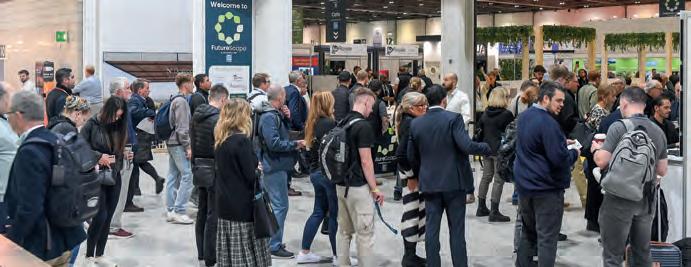
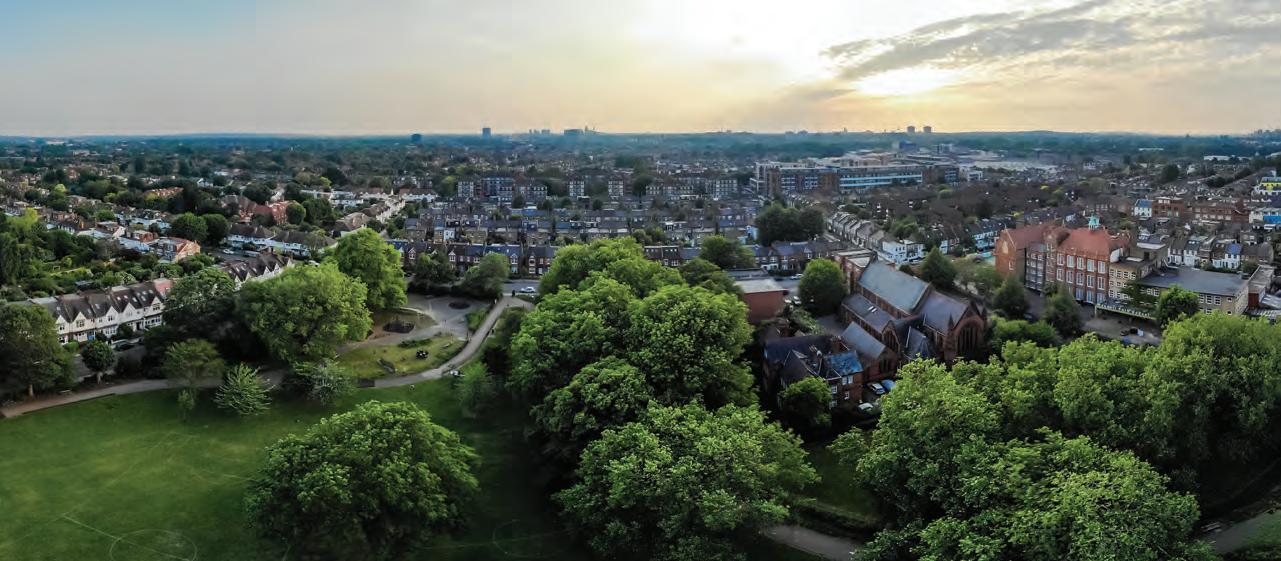
In an industry focused on tree care, characterised by petrol-powered chainsaws and protective gear, the broader mission can often be overlooked. Dr Mark Johnston, a notable figure in British arboriculture and keynote speaker at this year’s International Society of Arboriculture (ISA) Conference, believes that caring for individual trees is just the starting point. He argues that the main goal should be to use arboricultural expertise as a vital force for urban greening, community welfare and environmental equity.
This philosophy is highlighted in his autobiography, ‘Planting Ideas in the Urban Forest’, available as a free e-book and a reasonably priced paperback. The book serves as both a personal memoir and a historical account of British arboriculture, showcasing its potential and missed opportunities to influence urban environmental policy.
From tree surgery to urban forestry Johnston’s journey into the world of trees began in the forests of West Wales in the early 1970s. It was there he first heard of tree surgery, a profession that promised a more sociable working environment than remote forestry. However, it was during his studies at Merrist Wood College that he first
encountered the concept of urban forestry.
“I first heard about urban forestry in 1976 when I returned to Merrist Wood College but only picked up on it when I became a tree officer at the London Borough of Harrow a year later,” recalls Johnston. “Because it interested me, I contacted the early pioneers of urban forestry, people like
URBAN FORESTRY AIMS TO IMPROVE THE WELFARE OF URBAN RESIDENTS. THE PLANTING AND CARE OF TREES IS A MEANS TO THAT END, NOT AN END IN ITSELF
DR MARK JOHNSTON
John Andresen and the man who coined the term in the modern era, Erik Jorgensen, and started corresponding with them.”
Through these correspondences, Johnston came to view arboriculture as a vital component of urban forestry, essential to its multidisciplinary approach along with landscape architecture,

urban planning, traditional forestry and other disciplines. His integrative view, that while “ they’re not the same thing... arboriculture is a key component of urban forestry,” was embraced in North American-based organisations like the ISA. In Britain, however, he witnessed an “historic missed opportunity”. At the time, industry resistance, fuelled by a perception of urban forestry as an Americanism and a clinging to non-academic traditions, blocked this integration. These sentiments in the arboriculture industry were later directed at Johnston’s work, perfectly encapsulated by the pushback against his early efforts to develop higher education courses at Merrist Wood: “ We do not need managers, we need monkeys.” Fortunately, University Centre Myerscough was eventually successful in developing HE courses in arboriculture.
The image problem and a recruitment crisis
In recent years, Johnston believes the arboricultural industry has suffered from an ongoing image problem. Where tree officers were once seen as “the good guys, the protectors of trees” in the 1970s and 80s, years of austerity-driven cuts, lack of
maintenance and high-profile controversies like the street tree felling in Sheffield have tarnished that reputation.
“The industry hasn’t had good press… We’re often not seen as the protectors and promoters of trees; we’re seen partly as the problem, not the solution,” he notes. This, he believes, is a primary reason why the sector now faces a succession crisis, struggling to attract young, environmentally conscious talent who are instead drawn to fields like conservation or rewilding.
The solution, he proposes, is a concerted rebranding effort led by marketing professionals to reframe arboriculture as arboriculture and urban forestry, a career dedicated to “picking up the environmental challenge and making a difference” in towns and cities.
Lessons from the front line:
Media and muscle
Johnston’s conviction is backed by extensive experience. In the late 1980s, inspired by the community-driven ‘Million Tree Project’ in Los Angeles, he co-founded the ‘Forest of London’ project. This initiative became a model for others in Dublin, Cardiff, Glasgow and Belfast and taught him invaluable lessons in public engagement.
FOR THE FIRST TIME, WE ACTUALLY HAD THE EVIDENCE TO SHOW THAT IN THE MORE DEPRIVED AREAS, THERE WAS SIGNIFICANTLY LESS TREE COVER
DR MARK JOHNSTON
He learnt “the power of a message that goes out through mass media”, orchestrating attention-grabbing stunts like climbing the tallest tree in central London with Richard Branson. However, he equally emphasises that “you can’t have all hype and no substance.” For every media event, there had to be a robust organisation at the grassroots level to ensure community involvement and on-the-ground delivery.

CONTRASTING

The central pillar:
Arboriculture as the key discipline
Amid the broader goals of urban forestry, Johnston remains adamant about the nonnegotiable role of arboricultural expertise.
“We are the tree experts,” he asserts. “If you’re going to do urban greening, urban forestry, you need people who know about the planting and care of trees… If you don’t have this, all the urban planning and landscape design in the world isn’t going to do much.”
For Johnston, this expertise must be directed by the guiding principle of ‘tree equity’. He recalls that as a young tree officer, he observed an obvious but unquantified inequality in tree canopy cover between wealthy and deprived urban areas.
This anecdotal observation was cemented with data when he led the groundbreaking ‘Trees in Towns II’ study for the UK government. Published in 2008, the report formally correlated low tree canopy cover with the Indices of Multiple Deprivation, a measure of health, education, employment, and crime. “For the first time,” he says, “we actually had the evidence to
show that in the more deprived areas, there was significantly less tree cover.”
This concept has now gained global traction through the ‘Tree Equity Score’ developed by the US non-profit American Forests and recently adopted in the UK by the Woodland Trust. Johnston, invited to be a keynote speaker at its UK launch, sees it as a “huge leap forward” that finally aligns resources with the original mission of urban forestry: to improve the welfare of urban residents.
“Urban forestry aims to improve the welfare of urban residents. The planting and care of trees is a means to that end, not an end in itself,” he comments. “You start in the areas of greatest need. That’s what we’re about here.”
For Mark Johnston, the memoir is more than a history; it is a planting of ideas. It is a call to his industry to reclaim its role as environmental champions, to embrace its academic and professional development, and to ensure that the growth of the urban forest leaves no community behind.
Johnston’s free e-book can be downloaded at: markjohnstontrees.com
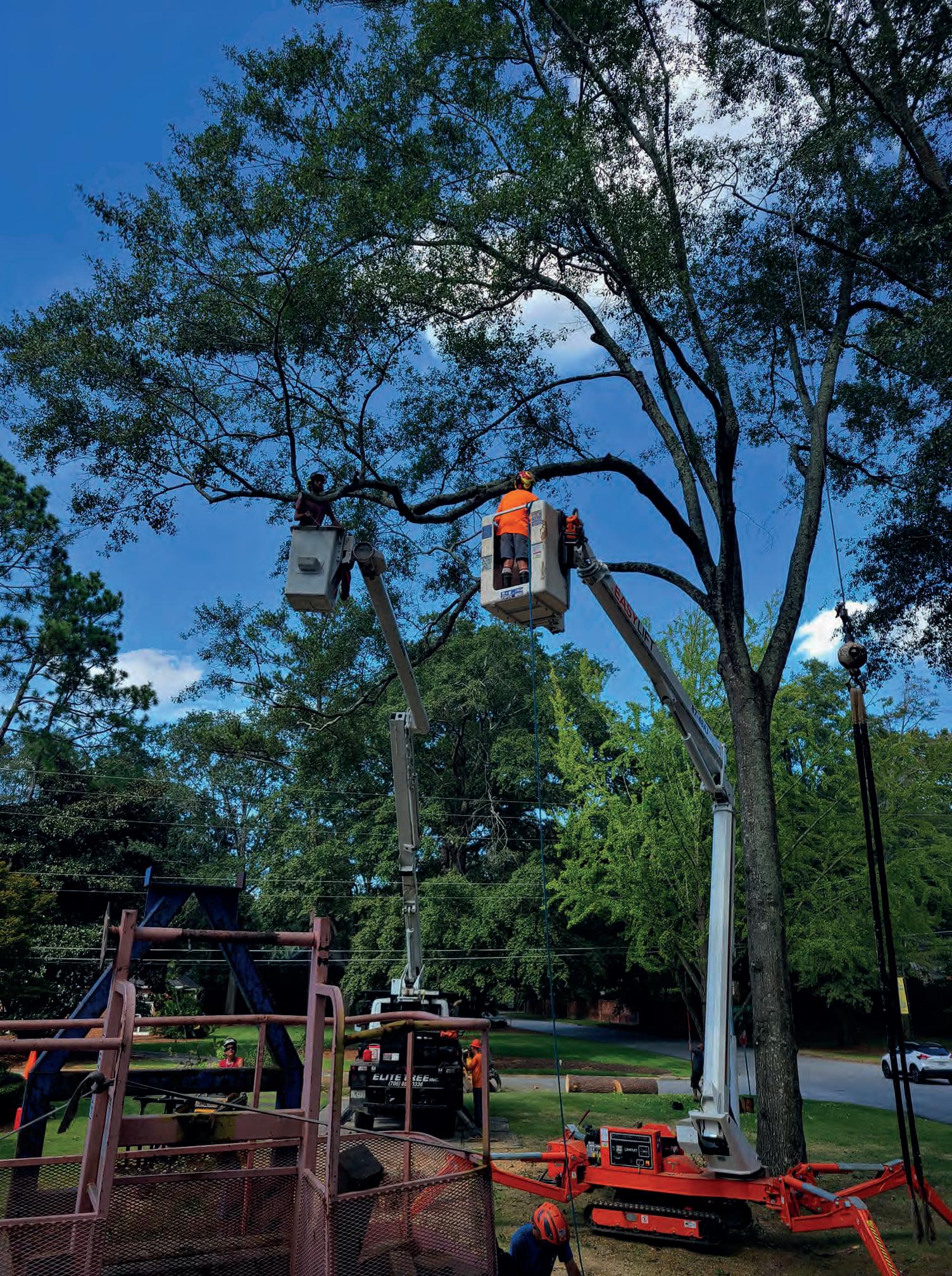

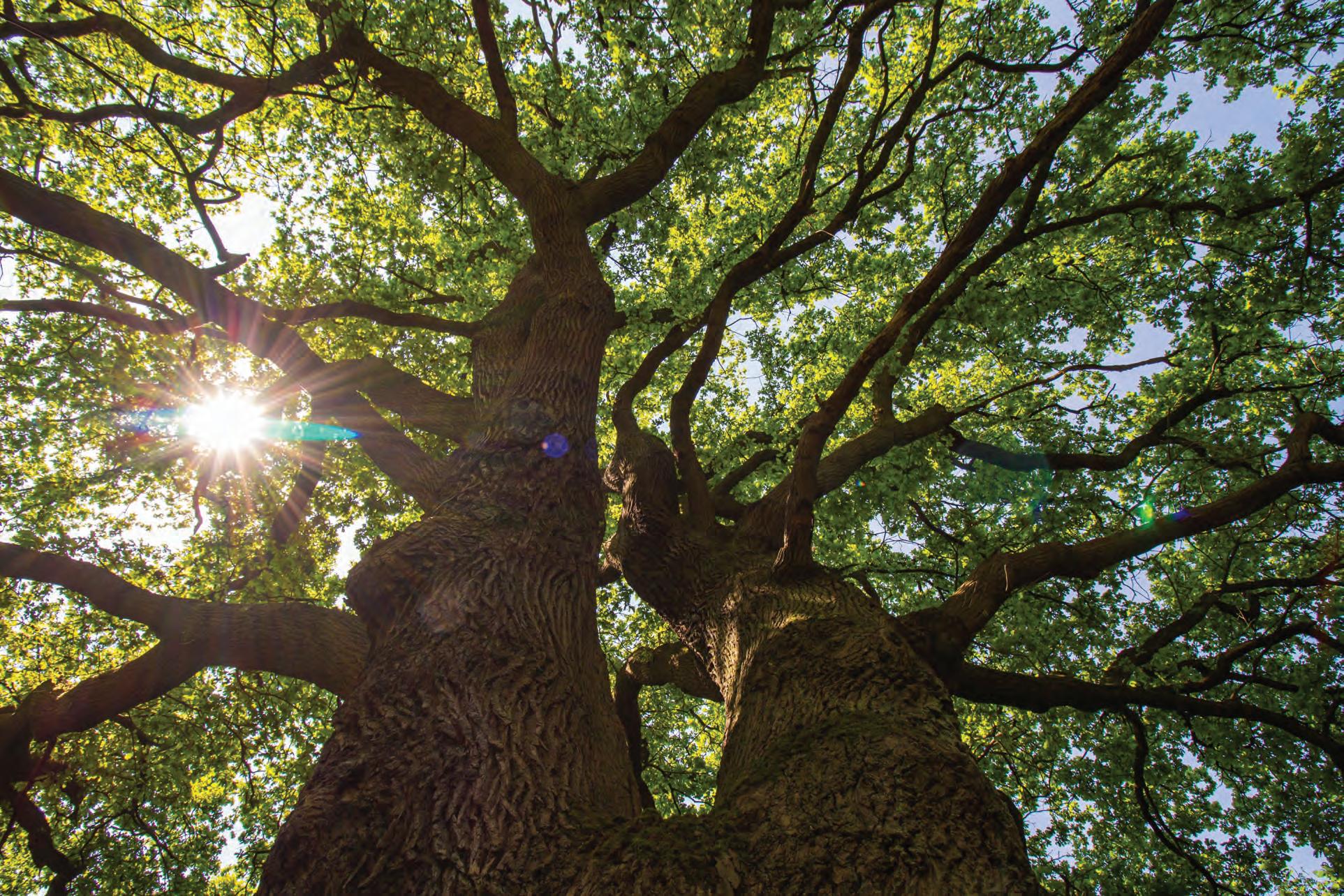

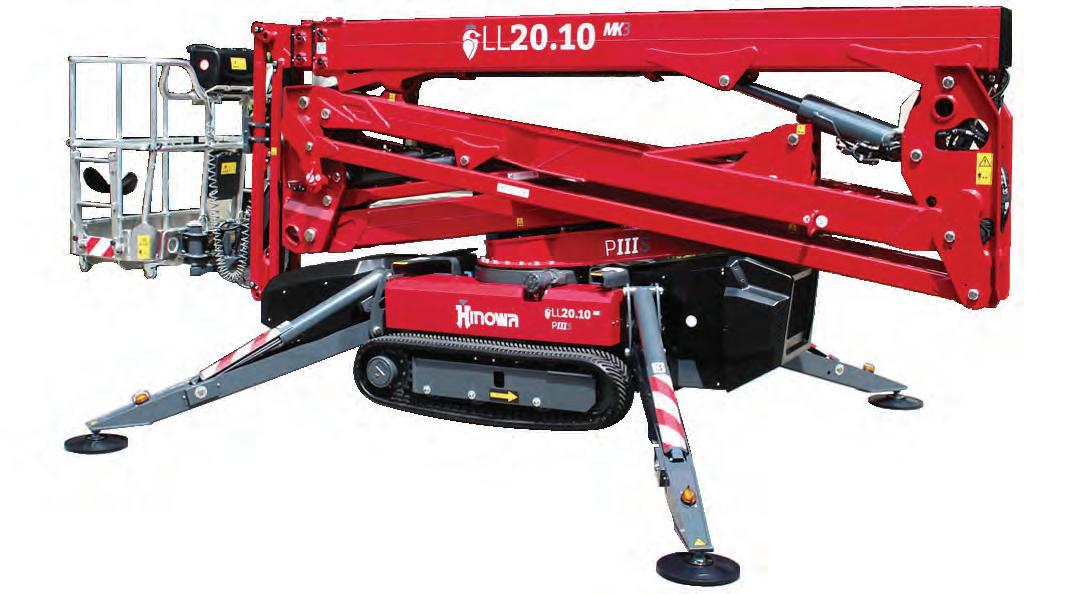
Trusted by arborists, tree surgeons, and forestry professionals across the UK, the Hinowa 20.10 delivers safe, stable, and versatile access for tree work, with 20.1m reach, 9.7m outreach, and proven all-terrain performance.
Trusted by arborists, tree surgeons, and forestry professionals across the UK, the Hinowa 20.10 delivers safe, stable, and versatile access for tree work, with 20.1m reach, 9.7m outreach, and proven all-terrain performance.
KEY FEATURES
20.1m working height & 9.7m outreach
230kg basket capacity – two person capacity
KEY FEATURES
20.1m working height & 9.7m outreach
Compact width: 0.79–0.98m – pass through narrow access with ease; basket easily removable for even tighter access
230kg basket capacity – two person capacity
Flexible power options – bi-energy or full electric options
manufacturer-backed warranty
UK stock available for fast turnaround
Compact width: 0.79–0.98m – pass through narrow access with ease; basket easily removable for even tighter access
Auto-levelling outriggers – fast, safe set-up in all conditions
Flexible power options – bi-energy or full electric options
Auto-levelling outriggers – fast, safe set-up in all conditions
IS A PERMANENT, INCURABLE INJURY. THIS GUIDE OUTLINES ESSENTIAL HAVS HEALTH AND LITIGATION PREVENTION STRATEGIES FROM AN OCCUPATIONAL HEALTH SPECIALIST.
For tree surgeons, the high-pitched whine of a chainsaw or the relentless grind of other tools of the trade is the soundtrack of their livelihoods. Yet, with the constant contact with that work-related equipment and more precisely its engine’s vibrations lies an insidious and long-recognised occupational hazard: HAVS, commonly known as vibration white finger. Nevertheless, despite long-standing medical knowledge on preventing the development of the condition, it remains a frequent medical diagnosis and can lead to significant liability payouts from employers if they are judged to have been negligent.
The medical description of HAVS has been known for over a century. As Professor Robert Douglas, an expert witness specialising in occupational diseases, explains, the pioneering work of Dr Alice Hamilton identified the condition in ‘A Study of Spastic Anaemia in the Hands of Stone Cutters’ in 1918. “She was way ahead of her time,” Douglas
notes, “and there’s been no real big improvement on her initial analysis since.”

Often mistaken for the more widely known Raynaud’s phenomenon, HAVS is in fact a more complex syndrome.
THE PHYSIOLOGICAL MECHANICS BEHIND THE SYNDROME INVOLVE ENERGY FROM VIBRATING TOOLS BEING ABSORBED INTO THE HAND, DAMAGING NERVES AND BLOOD VESSELS
Douglas describes that the most visible sign is the blanching of the fingers –the classic “white fingers” caused by vasoconstriction – which can be triggered by cold or vibrations. However, this is often accompanied by neurological, aka
nerve, damage, experienced in symptoms, for example, loss of tactile feeling in the fingertips and motor disturbances in the arm. “I’ve come across people who first notice where they go fishing, and they can’t tie the knots properly on the hook,” Douglas comments, highlighting the impact on dexterity. “Or doing up shirt buttons; they’ll get their wife to do it for them.”
The physiological mechanics behind the syndrome involve energy from vibrating tools being absorbed into the hand, damaging nerves and blood vessels.
In a healthy body, the natural thermoregulatory system, a “clever bit of engineering”, says Douglas, exchanges heat from the core to the extremities through arteries and veins. However, likely connected to a genetic vulnerability, damage to that thermoregulatory system can disrupt blood flow to the extremities.
Using the Stockholm Workshop Scale, Douglas adds, the progression of the damage can be graded, with each severity ranked by
the vascular (blanching) and sensory-neural (numbness, loss of dexterity) symptoms. Typically, he explains, initial symptoms include occasional tingling and minor blanching at the fingertips but can later advance to frequent blanching “attacks”
THE FOCUS MUST BE OVERWHELMINGLY ON PRIMARY
Douglas reports. While anti-vibration gloves are marketed, their efficacy in dampening harmful vibrations is limited. Their true value lies in keeping the hands warm, as cold is a major trigger for blanching attacks. Providing adequate gloves for warmth is essential, but touting them as a primary protective measure against vibration is akin to “handing out a paper face mask that doesn’t really work.”
affecting all fingers, accompanied by persistent numbness and a reduced ability to perform delicate tasks. In its most severe stage, it can cause trophic skin changes and necessitate a complete change of occupation.
A plain reality of HAVS is that there is no cure for the neurological damage. Treatment is limited to managing symptoms, such as with the calcium antagonist drug Nifedipine, which can help vasodilate or widen blood vessels but carries side effects like lowering blood pressure. Consequently, Douglas emphasises that the focus must be overwhelmingly on primary prevention.
This centres on a multi-faceted approach rooted in “enlightened selfinterest” for employers. Firstly, engineering controls are paramount. Businesses should invest in modern, well-maintained equipment designed to minimise vibration. In his professional experience, Douglas comments that some older tools can have vibration levels “five hundred times greater than the threshold limit values.” Secondly, regulating daily vibration dosage through job rotation and enforcing frequent rest breaks is another critical component in reducing cumulative exposure.
The role of gloves is often misunderstood,
On the other hand, a robust occupational health programme is a powerful defence. This includes conducting pre-employment medicals to identify workers who may already have a predisposition, annual health surveillance to monitor for early signs and immediately removing from exposure any worker whose condition deteriorates to a moderate or severe stage.
The legal repercussions For businesses that neglect these duties, the consequences can be severe and financially tangible. Douglas, who frequently acts as a witness in such cases, recalls claims where settlements can reach £40k or more for a diagnosed case of HAVS. In court, the absence of a documented risk assessment, a lack of health monitoring and failure to provide adequate safety protocols severely weaken an employer’s position. Conversely, a business that can demonstrate a proactive safety culture, with clear evidence of risk assessments, health surveillance, equipment maintenance and employee training, has a strong defence. It represents a commitment to duty of care that is not only ethically right but also legally prudent.
More than a century since Dr Alice Hamilton first detailed the ‘spastic hand syndrome’, vibration white finger remains a matter of regret, a preventable condition that continues to inflict damage on
Employers must protect workers from vibration risks under the Control of Vibration at Work Regulations 2005. According to the Health and Safety Executive, they are required to manage these risks effectively by providing training and suitable health surveillance for at-risk employees. There are two key thresholds based on daily exposure values. The Exposure Action Value (EAV) is set at 2.5 m/s² A(8). Once this level is reached, employers must take action to reduce exposure. The Exposure Limit Value (ELV) of 5.0 m/s² A(8) is the maximum permissible level and exceeding this is strictly prohibited due to severe health risks. In some cases, a diagnosis of HAVS should also be reported to the Health and Safety Executive (HSE) in line with the Reporting of Injuries, Diseases, and Dangerous Occurrences Regulations (RIDDOR).
workers. The knowledge to prevent it has existed for generations. The challenge remains in universally applying that knowledge, ensuring that the tools of
a trade never become the instruments of its practitioners’ disability. For today’s arboriculture and tree surgery sectors, the message is clear: vigilance, modern equipment and unwavering commitment to worker safety are the only true safeguards against industrial injury.


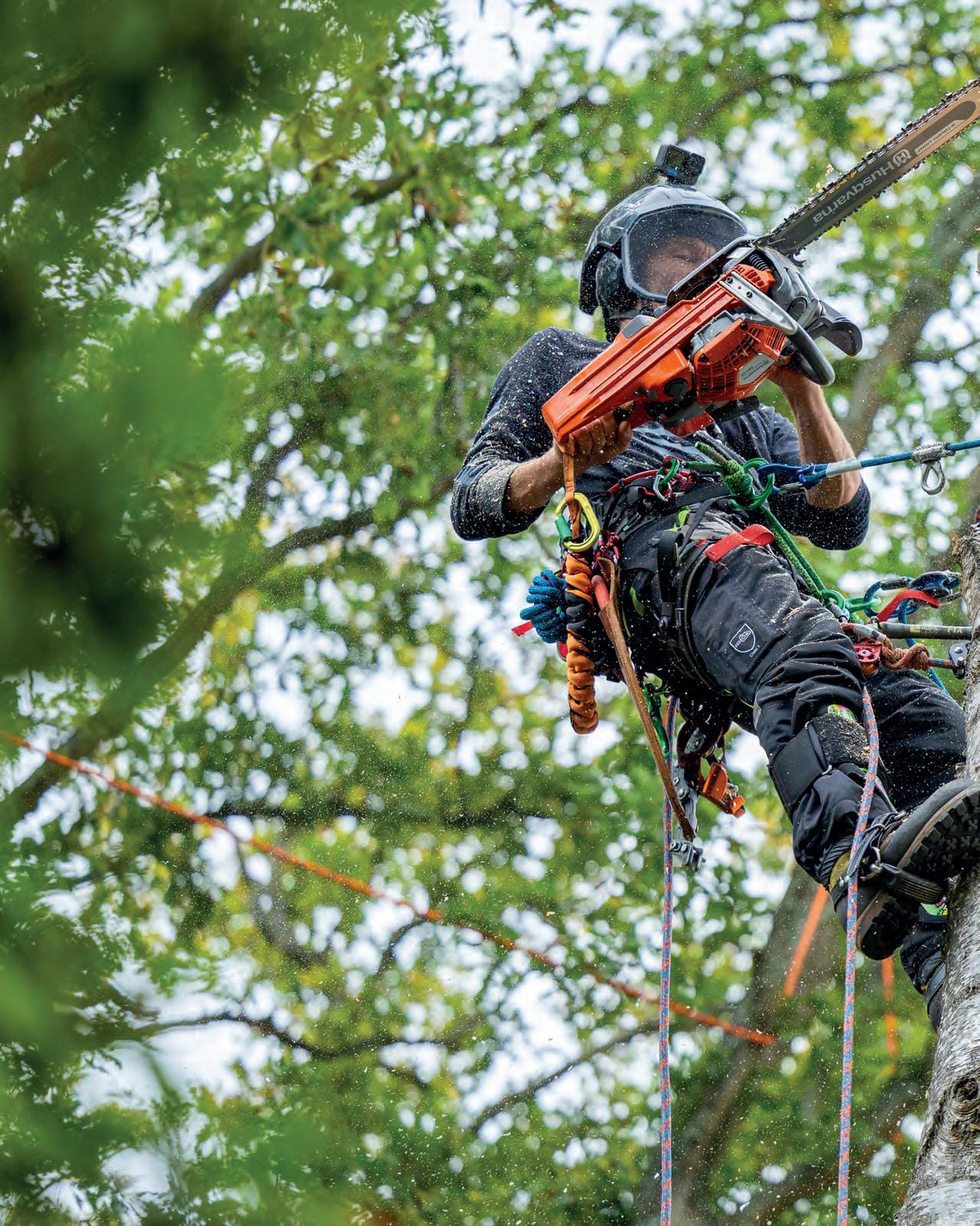
AN
ince its establishment in 1955, Honey Brothers has grown into a leading professional tree care equipment specialist. It now ships products worldwide, attributing its expansion to a comprehensive product range, competitive pricing and a strong commitment to customer service.
Based in Surrey and the New Forest, the company is an authorised supplier for several major brands, including Stihl, Husqvarna, Teufelberger, DMM and Silky. The company also holds the position of UK distributor for brands such as Notch, Reecoil, Fitwell and Distel. Furthermore, it maintains the largest UK stock holdings for Pfanner, Protos and Petzl products.
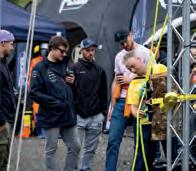
To celebrate its seventh decade
MEDIARB’S ADVANCED ARBORICULTURE TRAUMA KITS
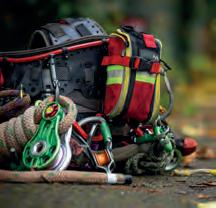

milestone, Honey Brothers hosted ‘HoneyFest 25’ on 20 September at the Peasmarsh site, an event embodying the company’s ethos of customer appreciation and industry engagement. The day featured arborist forums, demonstrations from brands like Husqvarna, Stihl and Notch and activities such as axe throwing. Business development manager Andrew Wood explains the sentiment behind the event, saying, “This year, Honey Fest celebrates our 70th anniversary. It’s a huge achievement for us as an industry leader to have operated for this long while maintaining our standards and quality.”
Tel: 01483 561 362 honeybros.com
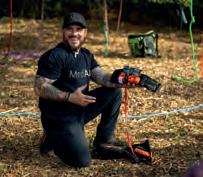
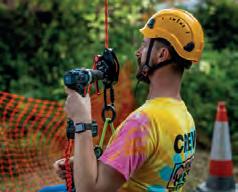
Daniel Ball, a former military serviceman turned arborist and director of MediArb, founded his company in 2020 to address a critical gap in tree care safety: the need for advanced trauma response kits. The venture began internally as “toolbox talks” after colleagues were injured. “I built these kits initially for my guys,” he expounds, which led to requests from subcontractors and the launch of a commercial product.
The kits are designed for the industry’s most severe risks, primarily chainsaw contact. Ball’s motto is that “doing something is better than nothing,” emphasising education alongside equipment. He notes that while PPE is essential, it has limitations. “PPE is only rated to so much,” he states, stressing that specialised trauma kits are necessary for catastrophic incidents. He cites cases where fellow arborists around the UK dealing with traumatic accidents, where lives have been saved by an on-site trauma kit.
MediArb kits include advanced haemostatic agents that can halt a femoral bleed in approximately 60 seconds and are fully certified to BSI 5990 standards. With many industry bodies already advocating for trauma-specific kits in high-risk arboriculture work, Ball’s mission is to provide crews with this essential, life-saving resource that exceeds standard Health and Safety Executive requirements.
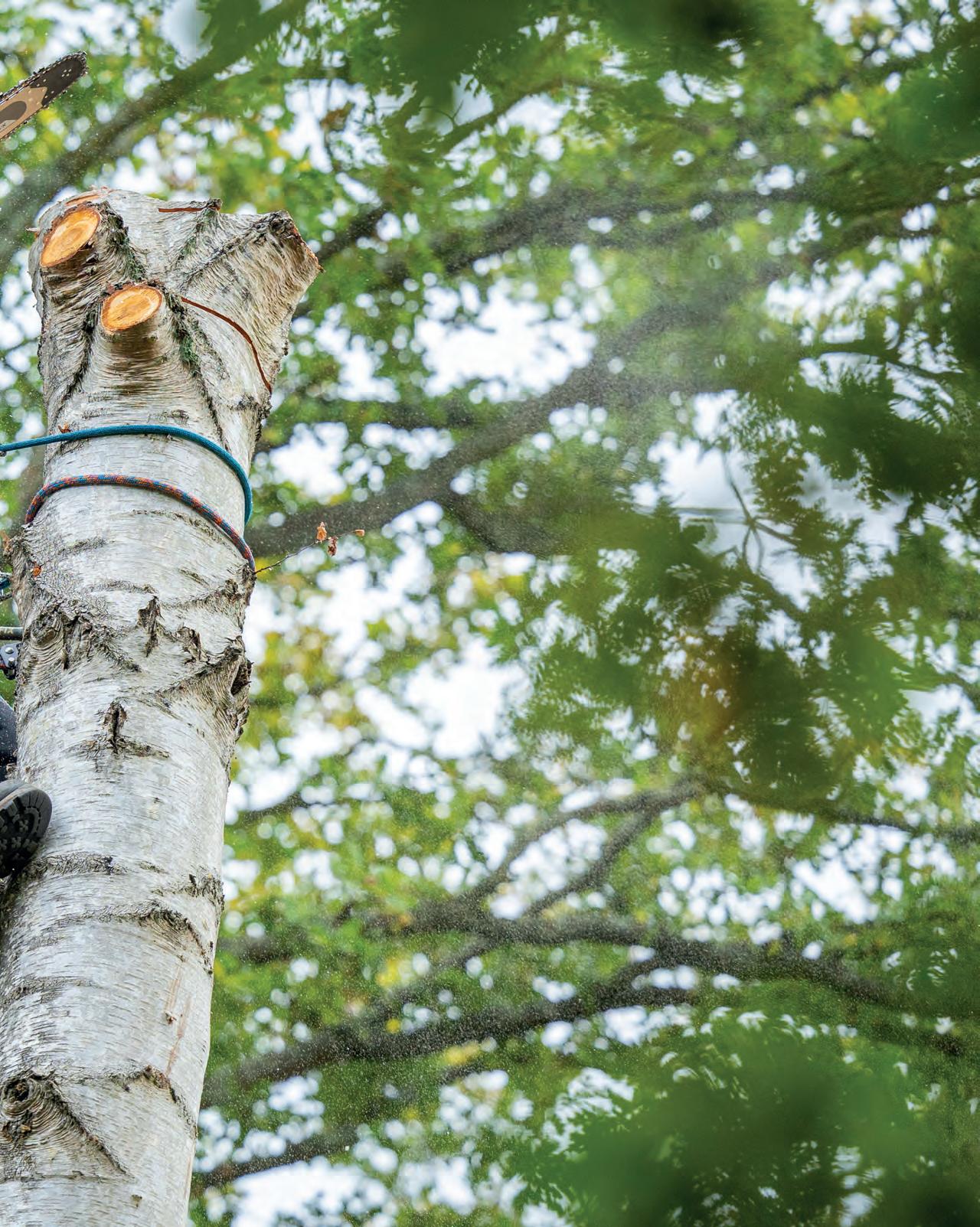
Educators at the local Merrist Wood College pitched up at Honey Fest looking to engage with prospective students, run into former learners and make some valuable connections with employers. Richard Cant, the curriculum manager for arboriculture, and Sarah Markham, business engagement specialist, comment that arboriculture training programmes continue to see healthy recruitment, driven by sustained demand within the tree care industry.
Recently, the college has been adapting its curriculum to better prepare students, notably with a shift to new T-Level qualifications. Cant describes the change as “really exciting, as it gives us the flexibility to shape the course in a way that truly meets the needs of industry.” The programmes aim to create qualified groundspeople in their first year, incorporating tree climbing and rescue training early on.

The all-new Stein Voyager 50, a kit storage bag built for arborists, was showcased by Peter Adams of Fletcher Stewart. “The idea is to keep systems separate and neat,” says Adams. The bag features a unique front-opening system so it “doesn’t just collapse,” providing easy access to gear. The design includes a dedicated space for two 15-meter ropes, allowing professional arborist equipment to be stored efficiently. It also features ergonomic support with back padding and a belly strap for comfort during transport.

Markham is optimistic about the sector’s future, emphasising that with Surrey being the most wooded county in the UK, there is a constant demand for skilled arboricultural professionals.
“There’s always work in arboriculture – it’s not an industry where we’re training people without the jobs to go into,” she explains.
This expansion in training coincides with a £21 million campus redevelopment project, which includes new arboriculture workshops.
Notch’s Six Pack rigging device exhibited at Honey Fest is the result of arborist and inventor Terry Banyard’s mission to solve a practical problem. Dissatisfied with traditional gear that twisted ropes and offered clumsy friction control, Banyard designed a solution from the ground up. “I was wanting something… that wouldn’t twist the rope,” he describes, highlighting the need for a more refined tool for potentially hazardous jobs.
One of the Six Pack’s standout features is its tuneable friction system. Ground crews can select specific rope configurations to perfectly match the load’s weight, ensuring a smooth and controlled descent, preventing the dangerous jerks
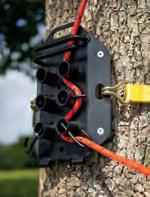
“HAND-POWERED CHAINSAW” FOR FORESTERS
Christopher Gottfried, founder of CEuk, highlighted the benefits of its range of pruning saws as ecological and practical alternatives for forestry work. He directed attention to the Trojan 600 Giant Folding Pruning Saw, which was developed in response to the demands of professionals. “Our biggest market is with foresters for the Trojan 600 but pruning use can filter to arborists too,” explains Gottfried, noting the tool requires minimal PPE and eliminates the need for “oils and fuel mixes” associated with petrol chainsaws. The company focuses on longevity, creating products that “can last, as long as you look after it.” With proper sharpening, a blade can last at least twelve months of daily use, offering a durable and cost-effective solution.
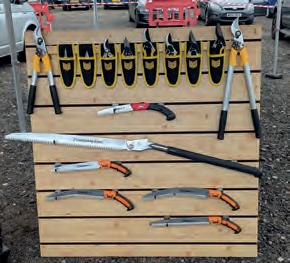
and equipment strain common with other devices. Its compact, low-profile design also minimises the risk of impact from falling branches.
Since its release, the innovation has garnered strong industry interest. Banyard attributes this to its unique approach: “It’s different to everything else… people are always keen to see something new on the market.” The Six Pack represents a clear evolution in rigging safety and control, born directly from the demands of life in the canopy.

MALIN RIVERS
collaborative initiative to catalogue and assess every tree species globally has found that 30% are threatened with extinction, a figure that “translates to 17.5k tree species” and surpasses the number of threatened mammals, reptiles and amphibians combined, according to Malin Rivers, head of conservation prioritisation at Botanic Gardens Conservation International. The Global Tree Assessment, launched in 2015, has compiled data on nearly 58k species. Rivers explains the project’s origins, stating, “We didn’t really have a very good understanding of what the
global picture was, because we didn’t have enough information.” Globally, the gathered data showed threats to tree species varied significantly by region. Agriculture and logging dominated in the tropics, whereas “in the temperate regions invasive species and pests and diseases are becoming the most dominant threat.”
From guiding protected area designations to creating public awareness resources, the established data has already spurred targeted conservation actions. The ultimate goal, Rivers says, is to use this information to “catalyse, maximise and inspire broad conservation action” for trees worldwide.
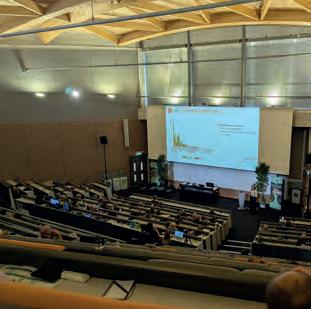
GROUNDBREAKING RESEARCH ON TREE SPECIES EXTINCTION, URBAN ALLERGIES AND DESERT GREENING WAS REVEALED AT DAY TWO OF THE ARBORICULTURAL ASSOCIATION CONFERENCE 2025
On 16 September, the University of Warwick hosted the second day of the Arboricultural Association Conference, attracting delegates for a day of networking and collaborative discussions.
Attendees participated in insightful lectures and hands-on workshops, enhancing their knowledge and connecting with fellow arboriculture enthusiasts. Pro Arb Magazine brings you the speaker highlights.

ANDREW BENSON
Urban tree ecophysiologist Andrew Benson unveiled the results of a three-year study. In collaboration with the University of Canterbury, New Zealand, the research investigated the effects of different root pruning methods on London plane trees in Christchurch. “This is a completed piece of research,” Benson states,
noting the team is working through the final edits before publication. Comparing two pruning techniques, the study examined internode cuts, which left stubs, and junction cuts made at a side root, like a branch reduction cut. The results were clear, Benson elucidates that the “internode groups grew significantly more new

Alasdair Nicoll detailed the management of Oak Processionary Moth (OPM) on a large estate in north-west inner London, highlighting a significant shift in strategy. OPM was first detected there in 2015, peaking at about two thousand nests in 2018 before numbers declined.
“In 2020, we moved to a risk-based approach,” remarks Nicoll. This meant ceasing widespread spraying and moving to targeted nest removal while leaving low-risk nests to “encourage natural predation”. The consequences of this shift have been minimal, with Nicoll noting that defoliation of trees is “very rare”, and “reports of exposure from the public of rashes [are] very low.”
A key element in the local ecosystem has been a newcomer, a non-native parasitoid fly, which achieved a remarkable 83% parasitism rate. The effectiveness of this and native predators was studied by a volunteer, Jeff, a professor with relevant expertise. The discussion underscored the importance of providing habitats for these natural controllers. “If you provide a habitat required for predation, then predation is going to occur,” Nicoll reckons, affirming that natural predation is a viable tool for long-term OPM management.
endy Batenburg’s discussion explored the significant health impact of tree pollen, noting that “20 to 30% of the population in the UK is allergic to pollen,” with symptoms affecting the airways and eyes and causing headaches. Her presentation emphasised that the health risk is particularly acute in urban living areas where tree density is high.

A key concern outlined was the exacerbating effect of climate change, which has extended the growing season.
“It means trees start flowering earlier and the flowering time could be longer,” Batenburg explains, resulting in “a longer
period where you can get increased health problems.”
Her research, utilising data from the Leiden University Medical Centre and Elkerliek Hospital in the Netherlands, identified birch as the most allergenic tree, with nearly 50% of patients showing a sensitivity. It was followed by beech, which poses a “high allergenic potential but a low risk, because there’s not so much pollen.”
Ongoing research aims to create a national pollen allergy model to inform the public and professionals better. A key recommendation, Batenburg comments, is to favour insect-pollinated trees over wind-pollinated species to reduce pollen dispersal. Planners are also advised to select female trees and limit highly allergenic species, like birch, to under 10% of the urban forest to mitigate health issues.
Droots than the junction” cuts and also recovered a greater hydraulic capacity, which is crucial for water uptake.
Benson concludes that the findings have direct applications for arborists. To minimise problematic regrowth near infrastructure like sewer pipes, his take-home advice is that “root pruning should be undertaken, cutting back to a side root”, a junction cut. Conversely, to maximise regrowth for purposes like transplanting, an internode cut is preferable.
orella Pinter-Burus outlined the immense scale and challenges of Riyadh’s greening initiative. The Saudi capital, a metropolitan area of over 1,500 square kilometres built on a limestone formation “like the Grand Canyon”, faces an extreme climate with summer temperatures reaching 50°C and humidity as low as 3%. “When it rains in [Saudi Arabia], it rains heavily, flooding cities... but if we don’t have [irrigation], we can have trees dying within two days in nurseries,” she states.
In 2019, the Green Riyadh Programme launched with the goal of planting over 7.5 million trees across the city. PinterBurus comments that the project was backed by considerable funding, with the government “spending billions of pounds.” A key challenge, however, is

water sustainability in a city with scarce groundwater, now partially addressed mainly through desalination pipelines. Beyond aesthetics, Pinter-Burus says that the programme aims to help address a public health crisis, combating high obesity and depression rates linked to a sedentary lifestyle. The goal is to create visually engaging spaces that
encourage outdoor activity. She concludes that despite startup nursery production challenges, quality has significantly improved to support the Saudi goverment’s vision of a vast urban transformation.
Next year’s conference will be held on 7-9 September at Lancaster University and in April, 2026 the Arboricultural Association will host a symposium on green equity

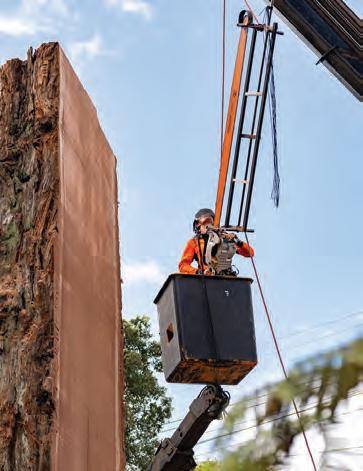
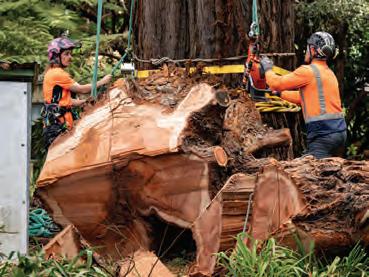
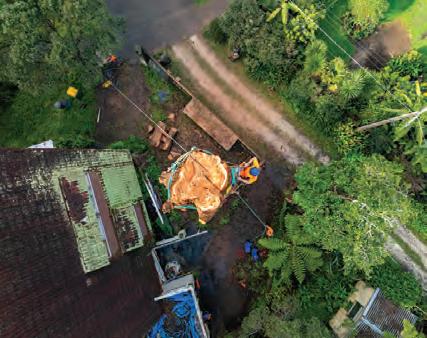
Naturally, for a long time, the arboriculture industry has been defined by a simple, utilitarian transaction: a tree becomes a problem for a client, and an arborist is hired to remove it. But a growing chorus of voices within the field is advocating for a radical paradigm shift, one that moves from removal to preservation by redefining how we all value the trees that shape our urban landscapes. The stories of two arborists, Scott Geddes and Catherine Nuttgens, though separated by geography, New Zealand and Britain, reveal a shared conviction to that end: advocating for trees’ importance in our private and community spaces.

From removal to revaluation
Scott Geddes, the owner of Auckland Tree Services, represents the industry’s internal struggle between business and preservation interests. He achieved what many would consider success, building a highly profitable business focused on tree removal. Nevertheless, he found himself
conflicted. “The number of trees I have murdered in my career is phenomenal,” Geddes recalls with stark honesty. “I had a successful business making trees go away, but I came to understand that as an industry, we are delivering a negative result to society.”
SCOTT GEDDES
This dissonance between profit and purpose crystallised at an industry conference where he learnt about rampant canopy loss across the world, a crisis mirroring Auckland’s own estimated 30% decline since 2012. “I was asking why nobody is watching over this.” He emphasises, “It was because, as an industry, we don’t count the long-term value of those
trees when we remove them, and as a society, we do not value trees despite them having immense value to us.”
Geddes’s first attempt to change course by simply refusing undesirable removal jobs was a painful lesson in market forces, costing him significant revenue. This experience taught him that the solution isn’t just arborists saying ‘no’ but fundamentally changing the narrative of what customers want. He now champions a “Tree Preservation Model”, arguing that arborists, as custodians of tree knowledge, have prime responsibility to communicate the tangible value of trees to clients and attempt to shape the demands of the market by primarily pitching ongoing maintenance and mitigation rather than wholesale removal.
“The bet I’m making for my business is that my strategy is good,” Geddes says, acknowledging significant resistance from an industry built on removal. Ultimately, aside from tree preservation, he hopes that his company’s model can be the prototype ensuring steady industry profitability over initial gains, framing his choice for fellow arborists simply: “Do you want to be shortterm rich or long-term wealthy?”

While Geddes focuses on individual clients, arboriculturist
Catherine Nuttgens, a chartered forester and certified arboriculturist, offers a complementary perspective honed on the front lines of community empowerment. Throughout her career in UK local government and NGOs, she has explored the intricate relationship between people and trees. This interest arose from her tenure as a Sheffield City Council tree officer amid the ‘tree wars’ (2013-2018), a period of intense local felling protest that laid bare how deeply a community can feel about its trees.
“Working in Sheffield during the protests
was a pretty grim time for Sheffield tree officers, but I found it fascinating and sometimes terrifying the lengths people would go to protect the trees, how they were used as political weapons, and how it sparked an international interest in the way that urban trees are viewed,” Nuttgens recalls. This conflict serves as an example of the strong emotions trees can evoke, and for her, a critical gap.
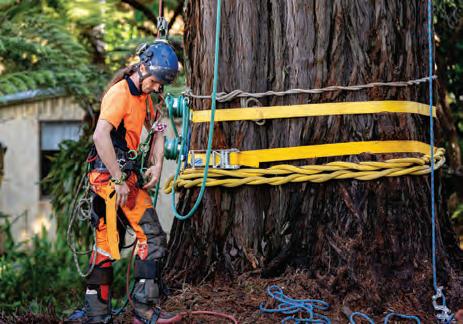
“The voice of the professional arb was drowned out by the clamour of both sides scoring points on one another,” she observes, pointing to a need for more open communication between authorities
WE ARE BEST PLACED TO COMMUNICATE THE BENEFITS AND PROBLEMS CAUSED BY URBAN TREES TO THE PUBLIC
CATHERINE NUTTGENS
and citizens about local tree work. “I think, as an industry, we are best placed to communicate the benefits and problems caused by urban trees to the public. Additionally, we should make clear that good arboriculture should always be about preventing trees from causing problems”
The felling of a single tree that led to international outrage more recently was that of the Sycamore Gap. Nuttgens was lucky enough to be part of the Trees of Hope project, where seeds were collected and grown from the fallen tree and community groups from across the country were invited to apply for a sapling, explaining what the young tree would represent for them. Nuttgens says: “Looking at the UK through the lens of these little sycamore trees, I was able to see a country where people from all walks of life care for and look after each other through kindness, steadfastness and pride. It was good to see when we hear so much to the contrary. The power of
trees as a positive narrative force is not to be underestimated.”
Nuttgens announces her involvement in the upcoming Woodland Trust Tree Equity campaign, adding that she is a believer that everyone everywhere should have access to the benefits of trees, as they can make our towns and cities more liveable. However, she caveats that the benefits of trees are only beneficial when residents appreciate the trees themselves, and some of the drawbacks of trees, which disproportionately affect the disadvantaged, are addressed. As a consequence, professionals should be given a bigger platform as tree experts to develop a more nuanced understanding of trees and avoid the polarisation, like Sheffield’s tree wars chapter. This way, she argues, we can all enjoy the positive benefits to society that trees can give us.
The insights of Geddes and Nuttgens create a powerful blueprint for the future of urban forestry. Geddes’s preservation-first model emphasises the value of retaining trees, making their benefits clear to property owners. Nuttgens’ communityfocused approach outlines how to garner public support for preserving public spaces. The message for professionals and policymakers is evident: trees should no longer be seen as disposable. Arborists must become advocates for the essential contributions trees make to our economy, environment and social wellbeing. Together, Geddes and Nuttgens are part of this crucial shift in perspective.
In his keynote speech opening the event, Stihl’s chief executive officer, Michael Traub, framed the rapid pace of technological, political and ecological change as a critical test for the nearly 100-year-old company. He continually emphasised that leadership is defined by decisive choices in times of such transformation.

A central theme of Traub’s speech was Stihl’s commitment to “dual technology leadership”, rejecting a rigid approach to the eco-technology transition in favour of a pragmatic one. Traub predicts that while battery-powered equipment could reach “north of 70%” of the business in key markets, a significant petrol-powered segment will remain for the foreseeable future, especially in markets with a strong preference for petrol-powered equipment.
“It’s not an either-or,” Traub explains. “We want to be where our customers are. If a customer wants petrol, they should get the best petrol-powered product from Stihl. And if a customer wants a battery, they should get the best battery system.” He contrasts this approach with that of the auto industry, which he says had been “a little too dogmatic” in promoting a “battery first” policy. This strategy requires different capabilities: precision engineering for petrol tools and building a scalable ecosystem for batteries.
In his market overview, Traub reports solid mid-single-digit revenue growth so far in 2025, with expectations to be more cautious in the second half of the year due to US tariffs. Addressing candidly the impact of the Trump administration tariffs on the US market, Traub comments: “If the tariffs are 15% or more, that cannot all be absorbed by the company or manufacturer. Over time, some costs may have to be absorbed by the consumer.” Nevertheless, he highlights Stihl’s established resilience in the American market through its manufacturing footprint in Virginia, where it produces over one hundred models and sources 60% of components in the US.


IN SEPTEMBER, STIHL HOSTED ITS BIENNIAL INTERNATIONAL MEDIA DAY AT ITS HEADQUARTERS IN WAIBLINGEN, GERMANY. PRO ARB WAS THERE TO CAPTURE THE KEY ANNOUNCEMENTS ON THE COMPANY’S LATEST PRODUCT INNOVATIONS, STRATEGIC DIRECTION AND INDUSTRY EXPERTISE.

Looking at the deeply complex global picture, Traub reports that the batterypowered transition is being primarily
led by Western Europe, where it now constitutes the majority of sales. This stands in stark contrast to Eastern Europe, North America, Africa, Latin America and most of Asia, where petrol remains, for the time being, dominant. Meanwhile, China’s “export engine has stalled due to trade conflicts”, which has forced Chinese manufacturers to redirect exports from the US, flooding markets like Oceania with inventory and intensifying competition in those regions. Traub adds that Chinese manufacturers’ reallocation of resources away from the US could also impact the flow of products coming into the European market in the next year. He characterises this volatility and global trade restructuring as an industry “wake-up call”, one that forces a renewed focus on Stihl’s core value proposition. Looking ahead to Stihl’s 100th anniversary, Traub concludes his speech by stating that the Stihl TIMBERSPORTS Championship’s return to Stuttgart in 2026 is an authentic showcase of his brand’s values: precision and strength. He also teased new products set to launch during the 2026 centenary year, which Pro Arb Magazine will feature as they become available.
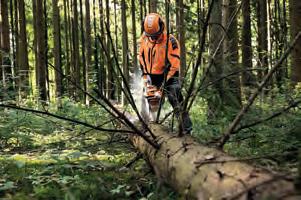
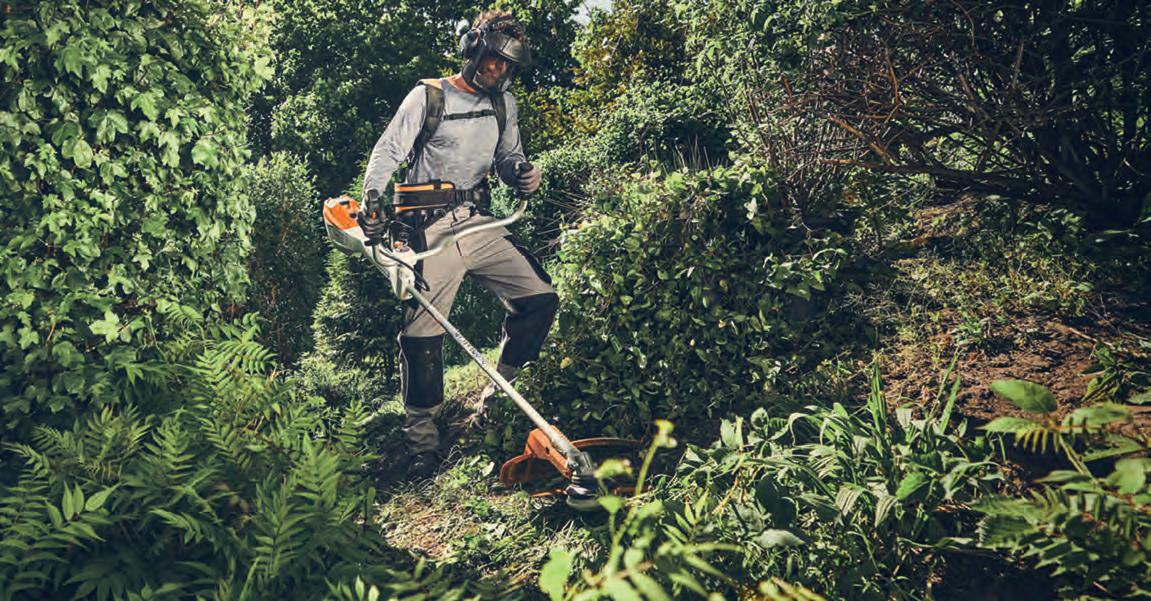
As referenced by Traub in his keynote speech, batterypowered equipment is becoming an increasingly prominent force in machinery manufacturing, driven by growing global demand and rapid technological advancement. The manufacturing trend is following sustainability and eco-tech corporate goals across multiple industries, where professional battery-powered tools are now supplementing, and in some cases replacing, their petrolpowered counterparts.
For Stihl, growth in demand for its battery-powered equipment has been substantial over the last half a decade. Between 2019 and 2024, the manufacturer saw a 93% increase in sales of battery-powered equipment, resulting in a 115% rise in revenue from those products. Although demand was strongest in Europe, notable upticks also occurred in North America and other international markets. Stihl reports that two out of every three landscaping and forestry professionals in Western Europe and
North America are now using battery-powered equipment for at least part of their work.
While battery power is advancing, it remains unviable for all forestry and arboriculture applications.
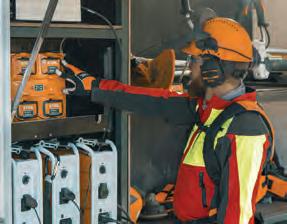
This is why Stihl is taking a dual-track approach, continuing to develop new high-performance petrol machinery alongside its battery-powered innovations. Stihl examined the practicalities of the move towards battery-powered equipment in a seminar presented to the international media, unveiling results from its two-year ‘Battery in Forest Management’ project study with Forst Baden-Württemberg. The partnership delivered concrete data on the challenges and future potential of batterypowered equipment in the forestry profession and looked at the continued place of petrol-powered equipment in the industry.
The project’s key finding indicates that for specific applications, particularly in young stand maintenance, the switch from petrol to battery is effective, efficient and technologically feasible. The primary advantages noted were significantly lower noise and exhaust emissions, along with reduced vibrations, contributing
to improved operator comfort and a better working environment. Additionally, researchers mentioned that the greater use of battery systems has also driven the development of novel work methods, including using tools like pole pruners that had no direct petrol-powered equivalent for certain precision forestry tasks.
However, the study found that the adoption of battery technology in remote forest environments presents a distinct set of challenges, with energy logistics being the most prominent. The central hurdle is no longer the performance of the tools themselves but ensuring a reliable energy supply throughout the workday.
As Julian Danner, product manager - Target Group Forestry & Treecare, notes, “When you work with battery, you will need to charge it. So, we have the challenge of energy management.”
This logistical challenge of on-site power can be overcome with modular systems, Danner reports.
A solution involves turning electrified vehicles into mobile charging stations, essentially, mobile power plants. By equipping them with components like the PS 3000 power supply and multi-battery chargers, these units can meet all of a team’s energy requirements directly where they work. Moreover, the development of faster, more robust chargers designed for outdoor use is seen as the next critical step. One such charger, the CM 8 battery charge control unit, is capable of sequential or parallel charging, as Danner comments is a “big step forward” that “massively changes the way our professionals can actually work” by providing “consistency in working and charging.” Despite the clear progress, the project acknowledges that
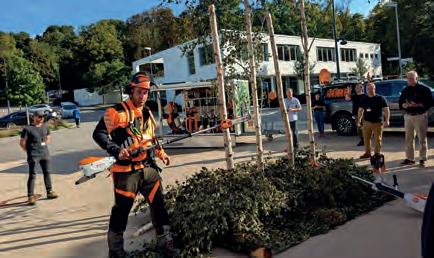
petrol-powered equipment remains the sensible choice for certain high-demand, remote forestry applications where the energy density of fuel is unmatched.
Stihl has also detailed its investment in special fuels made from biogenic raw materials to reduce the carbon footprint of its petrol engines, recognising that many professional users will operate hybrid fleets in the future.
For over 30 years, Stihl has provided sustainable fuel solutions in mainland Europe, starting with MotoMix in 1995, which cut CO2 emissions by 9%. This was followed
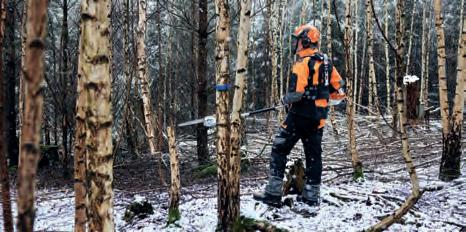
by MotoMix Eco in 2022, reducing emissions by 18%, and MotoMix Eco 20, released this year, with a 25% reduction. Stihl aims to continue developing these fuels through the end of the 2020s, targeting up to a 90% reduction in emissions. This aligns with the EU’s plan to increase fossil fuel taxes until 2030. Special fuels with biogenic raw materials are expected to be less affected by these tax increases, encouraging further research and development.
THE FUTURE OF FORESTRY IS NOT A SIMPLE REPLACEMENT OF ONE TECHNOLOGY WITH ANOTHER, BUT A STRATEGIC INTEGRATION OF BOTH
The economic case for switching to battery power is complex, hinging on usage, fuel costs and electricity rates. Stihl reports that battery tools are most cost-effective for frequent, low-power tasks, where long-term savings outweigh the higher initial investment. To help customers, Stihl provides a detailed cost calculator (stihl.co.uk/en/product-advisors/ battery-savings-calculator). As its portfolio manager of energy solutions, Joana Schierling, explains, “Using our online cost calculator tool, customers can compare how much does it cost to run a petrol machine and how much it costs to run a battery machine.” This tool provides a personalised break-even analysis by factoring in acquisition, operating and maintenance costs for a tailored financial assessment.
The ‘Battery in Forest Management’ project ultimately concludes that the future of forestry is not a simple replacement of one technology with another, but a strategic integration of both. Battery power offers undeniable benefits for specific tasks and improved working conditions, while advanced petrol technology and sustainable fuels will continue to provide necessary power for the most demanding applications. Stihl resolving that the industry appears to be moving toward a hybrid model where the choice of power source is a deliberate decision based on a specific job.
For more, visit: stihl.co.uk/en
THIS YEAR A NEW BATTERY-POWERED TOP-HANDLE CHAINSAW WAS INTRODUCED BY STIHL, THE MSA 190 T AS AN ELECTRIC ALTERNATIVE TO ITS PETROL MS 194 T
ENHANCED POWER AND CUTTING PERFORMANCE
• The saw’s performance is centred on a “Power Boost” function, which is designed to provide a temporary increase in electrical output, raising it from 1.25 kW to 1.5 kW. This feature is intended to help maintain cutting momentum in denser wood and reduce the chance of the chain stalling.
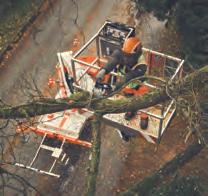
BATTERY SYSTEM AND REPORTED RUNTIME
FOCUS ON ERGONOMICS AND OPERATIONAL SIMPLICITY
• Weighing 3.2 kilograms (with guide bar and chain, without battery), the saw is engineered for reduced user fatigue during extended operation. For the best balance to weight ratio, Stihl recommends the chainsaw is used with the AP 200 S battery. A strap adapter accessory is available that allows the battery to be mounted on the operator’s harness, shifting weight from the arms to the hips. The saw also utilises a mechanical trigger system, noted
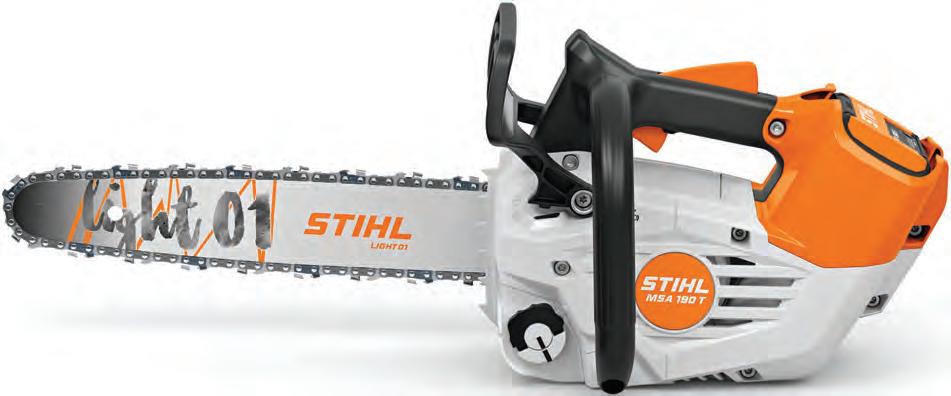
• As part of the AP System battery platform, the saw is compatible with the AP 200 S, AP 300 S or AP 500 S battery, which all offer full performance. It is reported to achieve up to 48 minutes of runtime with the AP 200 S. For longer tasks, runtime can be extended to 75 minutes with the AP 300 S and 90 minutes using the AP 500 S, which is the highest-capacity battery available in the system. This reduces downtime for the user between battery changes.
FEATURES FOR PROFESSIONAL AND SAFE USE
• The MSA 190 T is available in 12’’ and 14’’ versions and is designed to include several elements aimed at the demands of professional arborists. It is IPX4 certified, meaning it can be used in all types of weather conditions. Plus, the tool delivers consistent performance throughout the entire battery chargeStihl reports full power from 100% down to 0%, with no drop-off during use. The use of a mechanical trigger has also led to the omission of an automatic timeout deactivation feature, which is present on some competing electric models, benefiting professionals who prefer the simple, immediate and predictable control of their saw.
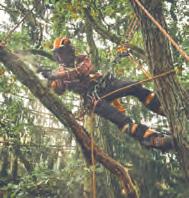
POSITION IN PRODUCT LINE
• Occupying a midtier position within the Stihl product family, the MSA 190 T is positioned between the MSA 161 T, which is an existing lightweight model, typically used for pruning, and the more powerful MSA 220 T model, which is intended for heavier cutting applications. This placement is intended to make it a versatile tool suitable for a broad spectrum of common arborist tasks.
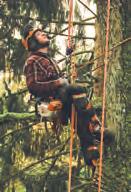
For more information visit: stihl.co.uk/en
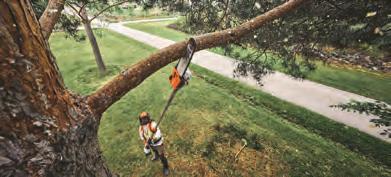
FOR PROFESSIONALS IN FORESTRY AND ARBORICULTURE, THE STIHL HTA 160
CORDLESS TELESCOPIC POLE PRUNER IS PRESENTED AS A TOOL DESIGNED TO COMBINE REACH, POWER AND OPERATIONAL FLEXIBILITY
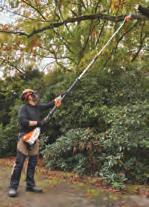
EXTENDED TELESCOPIC REACH
• A primary feature of the HTA 160 is its telescopic shaft, which can be extended to a maximum operational length of 405 cm (approximately 13 feet, three inches). This adjustability, starting from a retracted length of 285 cm, is intended to provide users with the ability to perform ground-based pruning and maintenance on high branches, potentially reducing the need for ladders or other access equipment and enhancing onsite safety.
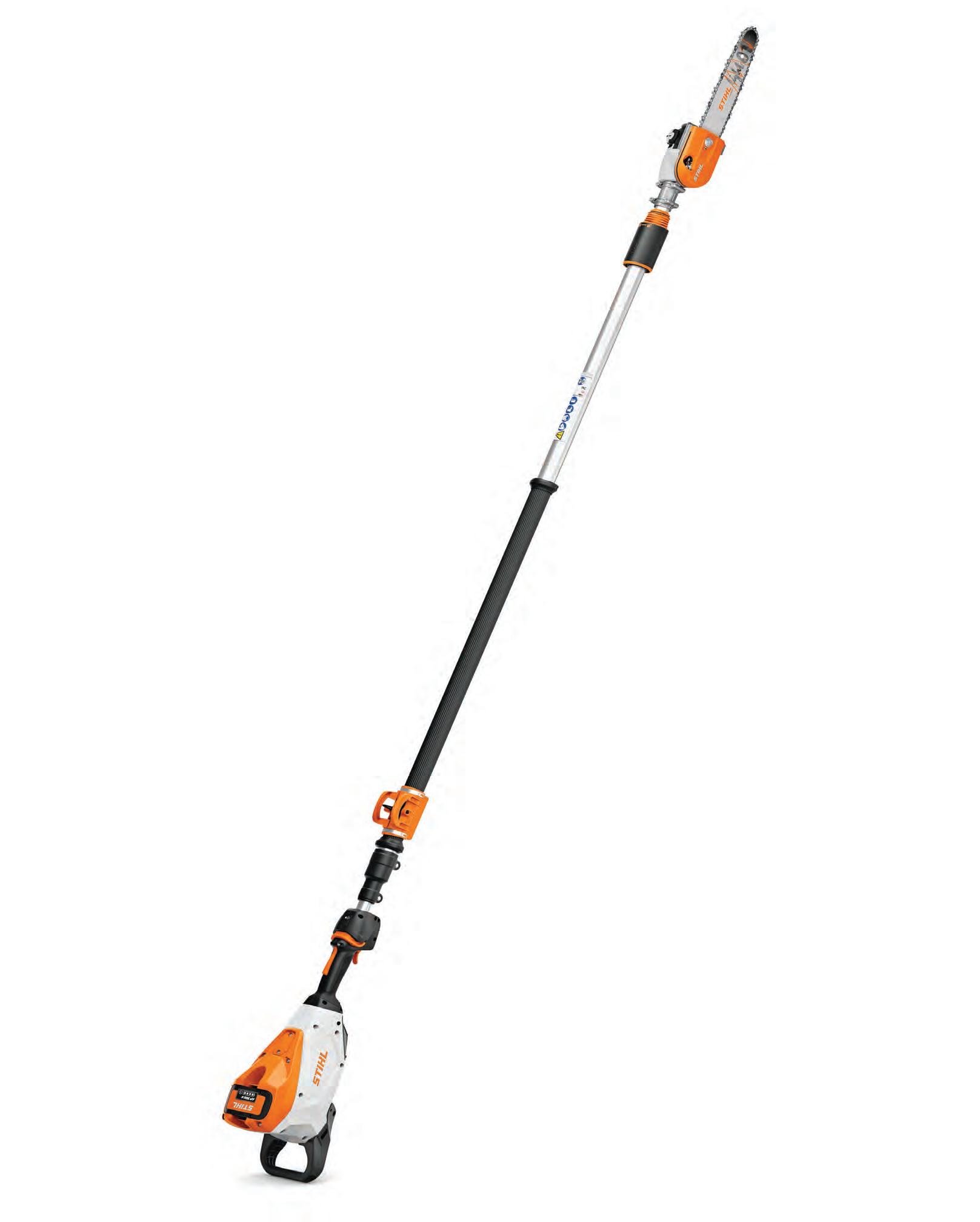
CUTTING CAPACITY
• Despite its cordless, battery-powered design, the tool is engineered for demanding tasks. It is capable of cutting branches up to 20 cm (nearly eight inches) in diameter. This capacity suggests it is suited for more than just light trimming, positioning it for substantive thinning and pruning work in a professional context.
BATTERY-POWERED OPERATION FOR REDUCED NOISE
• As p art of Stihl’s AP System, the HTA 160 is powered by lithium-ion batteries, a feature that directly contributes to low noise emissions during operation. The manufacturer identifies this as a key benefit for use in noise-sensitive environments, such as hospitals, schools and residential housing estates, where traditional petrol-powered equipment might cause a disturbance.
ERGONOMIC AND PROTECTIVE DESIGN ELEMENTS
• The product description notes several design features focused on usability and durability. These include a lightweight cutting head for improved manoeuvrability, a sturdy branch hook for managing cuttings, and an LED display on the handle for operational monitoring. For protection, the unit includes a protective foot to shield the motor housing from ground contact and an air filtration system designed to maintain optimal operating temperature and extend the tool’s service life.
• The pruner comes standard with a 3/8” P Picco Micro 3 (PM3) saw chain, which is designed for maximum cutting performance. Notably, the unit is also compatible with a narrower 1/4” P Picco Micro 3 chain. This option is underscored as being particularly effective for delicate work, such as maintaining fruit trees, providing professionals with configurability for different tasks.
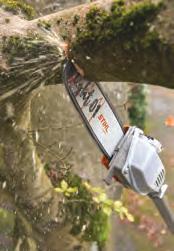
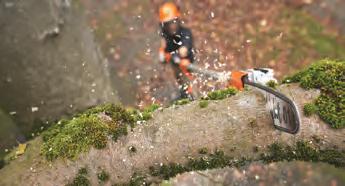
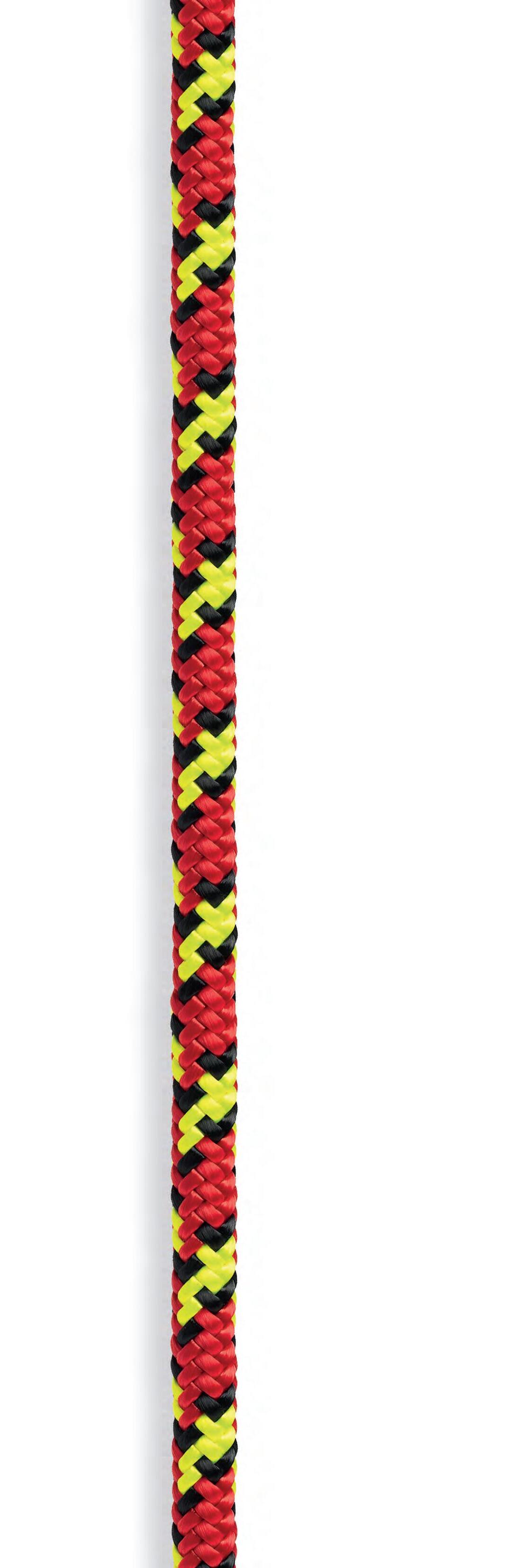

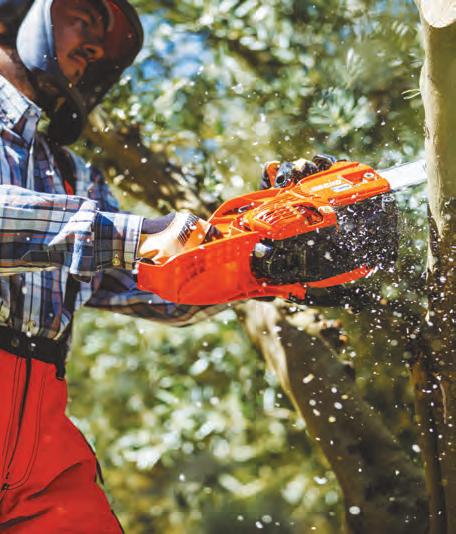
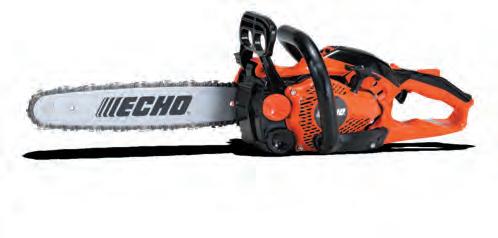
Based upon the legendary CS-2511TES top handle saw, the 25cc CS-2511WES offers an unprecedented power-to-weight ratio, wrapped up in a compact, rearhandle form factor. It is a 100% professional grade saw in a tiny package, making it perfect for carving, hedge laying, or trimming applications where space and obstacles limit access and manoeuvrability.
FROM FSI , CRYTEC , HYUNDAI AND VERMEER , COMPARING THEIR CAPABILITIES FOR PROFESSIONAL TREE
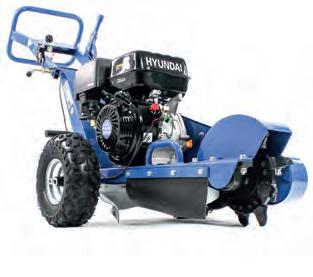
For professionals in arboriculture and forestry, accessing confined workspaces presents a significant challenge.
FSI’s B31 series of stump grinders is engineered to meet this need, with a narrow 74cm frame designed for areas where larger equipment cannot operate.
A key advantage noted by FSI is the machine’s weight, 680kg which is lighter compared to many alternatives on the market. This helps ease transport and minimises impact on surfaces like patios. The range includes models with engines ranging from 26.5hp to 38hp, all maintaining the same compact footprint. Track systems and a low centre of gravity also provide stability on uneven terrain.
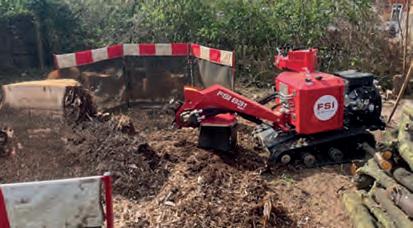
The newest model, the B31-980 REMOTE, incorporates radio control to enhance operator safety and precision. This feature allows for remote operation, making it especially useful for lone workers or those working in difficult conditions. Companies like Gascoigne Garden and Tree Service and Tree Stump Solutions have reported that the combination of safety features and performance makes the B31 suitable for their work requirements. Moreover, beyond reliability, a 120cm cutting sweep and a hydraulically driven cutter wheel are designed to reduce daily maintenance, aiming to maximise operational uptime.
Crytec Power introduced its updated CRSG150-R stump grinder last year, featuring a redesigned model aimed at commercial landscaping and arborist markets. The machine is engineered to balance power with manoeuvrability for a range of stump removal tasks. The grinder is powered by a 15-horsepower RATO engine, which the company states provide the reliability needed for challenging operations. Its primary cutting mechanism is a 300mm grinding disc equipped with nine specially designed teeth, intended to maximise efficiency and cutting speed.
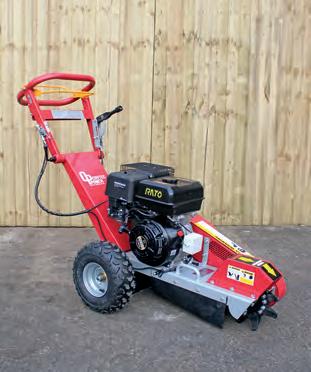

A key specification of the machine is its working reach, which enables it to effectively tackle stumps up to 600 mm in height and grind them to a depth of 235 mm in a single pass. This depth is designed to ensure thorough stump removal, minimising the need for repeated work on the same site. For the safety of the operator, the unit is equipped with a robust braking system that stabilises the machine during operation.
Additionally, practical considerations have been addressed in the redesign. The CRSG150-R features a foldable handle, which simplifies transportation and reduces storage space requirements. With dimensions of 1060 mm x 800 mm x 580 mm, the compact grinder is positioned as a solution for professionals in need of a capable yet portable machine for various job sites.
Nathan Welby, sales director at Crytec, details: “The Crytec CRSG150-R pairs a rugged 15 hp RATO engine with a 300 mm disc and 235 mm depth reach, offering powerful, efficient stump removal plus safe, compact storage thanks to foldable handles, designed for precision and performance.”
Vermeer offers a range of stump cutters engineered to strike a balance between power and site accessibility, catering to the diverse needs of professionals. The larger SC48TX model is built for demanding applications, while the compact SC30TX provides a solution for more confined spaces. The Vermeer SC48TX stump cutter is intended for high-power efficiency on challenging job sites. Its 48-horsepower Tier four Final diesel engine and

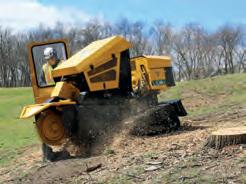
beltless direct-drive system are focused on maximising performance with minimal maintenance. A key feature is its adaptability: the retractable tracks narrow to 89 cm for access through narrow openings, such as garden gates, and extend to 140 cm for operational stability. For operator safety and precision, options include a full-function remote control and the SmartSweep system, which automatically regulates cutter wheel speed. With a 170 cm straightline cutting capacity and the ability to grind 41 cm below grade, it is built for large-scale stump removal. In contrast, the SC30TX stump grinder emphasises a compact design with a 25-horsepower engine. It is equipped with 16 Yellow Jacket teeth and features a 3.2 mph travel speed for manoeuvrability. Its focus is on intuitive operation and safety, with durable operator handles and an automatic shut-off system. This model is positioned as an accessible and easy-to-maintain machine for tackling tough stumps in smaller-scale or more restrictive environments.
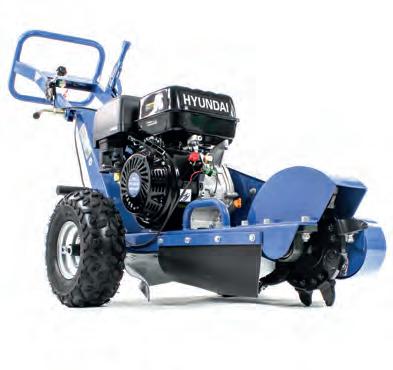
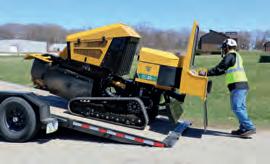
Hyundai Power Tools’ HYSG150-2 is a petrol-powered stump grinder designed for both professional and DIY users. Hyundai states that the machine aims to combine power with user-friendly features to simplify the stump removal process.
At the core of the grinder is a 420cc, 14-horsepower Hyundai four-stroke engine, engineered to handle demanding applications. Weighing 110 kilograms, this unit is designed for relative portability, enhanced by heavy-duty pneumatic tyres and adjustable handlebars for easier manoeuvrability.
A key operational feature is the handlebar-mounted control system, which combines the engine throttle with a wheel brake. This brake can lock one wheel, creating a pivot point that facilitates a sweeping cutting motion.
The HYSG150-2 is capable of grinding stumps up to 56 cm above ground level down to a depth of 33 cm. It is equipped with nine replaceable teeth tipped with tungsten carbide, chosen for its durability against various wood types. Operator safety is addressed with a protective steel shroud that helps contain debris during operation.
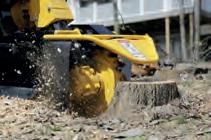
Together, these models illustrate Vermeer’s diverse approaches to stump removal, providing professionals with various options tailored to specific job site requirements.
The manufacturer highlights the machine as an alternative to more labour-intensive methods, such as manual digging or chemical treatments. With low scheduled maintenance requirements and full parts support in the UK, the HYSG150-2 is positioned as a practical solution for efficient professional stump removal.
A spokesperson for Hyundai Power Products tells Pro Arb Magazine: “The Hyundai HYSG150-2 combines powerful performance with user-friendly design, giving professionals a reliable and efficient solution for removing tree stumps quickly and safely.”
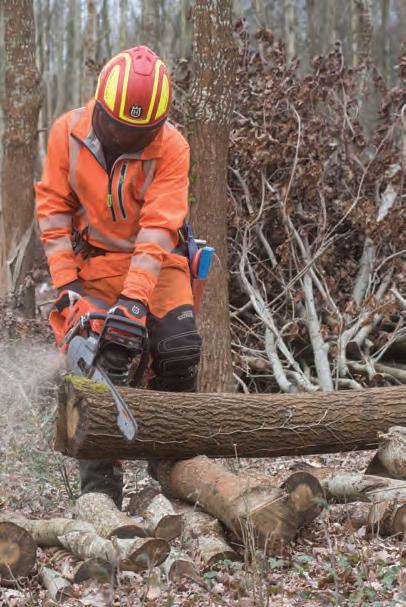
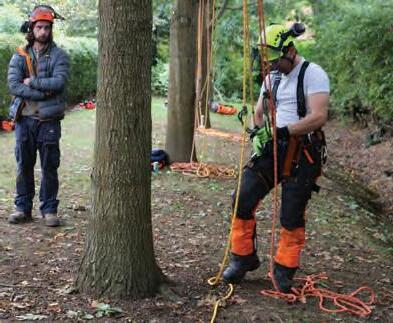
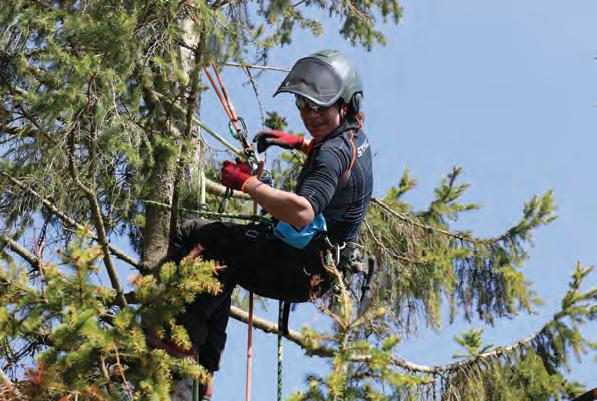



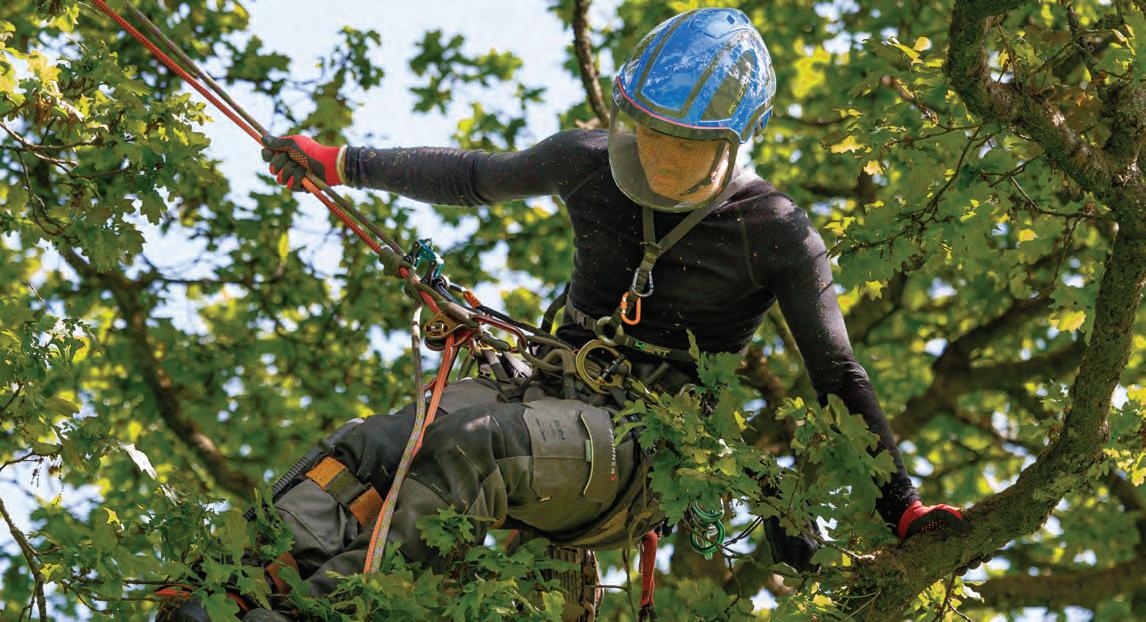

ANDREW HUNTER
FOR ARBORISTS FACING HARSH CONDITIONS, ADVANCED LAYERING SYSTEMS ARE VITAL. WOOLPOWER’S TEMPERATURE-REGULATING MERINO WOOL GARMENTS CAN ENSURE SAFETY, COMFORT AND DURABILITY, TURNING FUNCTIONAL WORKWEAR INTO A CRUCIAL INVESTMENT.
In the increasingly colder months, professionals working outside will operate in uncomfortable and potentially hazardous conditions. Comfort in such extremes is a safety requirement, not a luxury. The right clothing system does more than just keep a tree surgeon warm; it regulates body temperature, manages moisture and provides the freedom of movement necessary for precision work at heights. Health and Safety Executive regulations mandate that employers mitigate coldweather risks for outdoor professionals. Consequently, these workers require technically advanced layering systems
designed for active conditions, not just basic workwear. At the forefront of advanced thermal workwear are innovative fabrics like merino wool blends. Brands like Woolpower offer these fabrics in products with unique properties tailored to demanding environments. Andrew Hunter, managing director at Outwear, the exclusive distributor of Woolpower in the UK and Ireland, outlines the core value proposition of the company and its products:
“Woolpower keeps you warm when it’s cold, cool when the work heats up, and dry no matter how hard you push yourself. The fabric resists odours, handles abrasion like a champ and stretches with every move,
while smart design features like longer backs ensure comfort and freedom of movement all day long.

The science of temperature regulation
The primary challenge for any outdoor worker, especially one engaged in strenuous and dangerous tasks, is managing the body’s core temperature. An arborist may start a crisp morning climb in near-freezing conditions, only to generate body heat minutes later while operating a chainsaw. A standard cotton sweater, once damp with sweat, it becomes cold and heavy.
Advanced layering systems are engineered to solve this problem dynamically. As Hunter explains, “Woolpower’s innovative garment designs are engineered to regulate body temperature effectively, adapting to varying activity levels and environmental conditions.” This is achieved through specific fabric technologies. The signature Ullfrotté Original fabric “features a terry-loop knit structure, creating air pockets that trap body heat while allowing moisture to escape.” This blend of merino wool and synthetics creates a microclimate next to the skin, insulating against the cold while efficiently wicking perspiration away to evaporate.
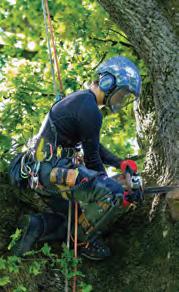
For higher-intensity work or warmer seasons, a lighter option like the Woolpower LITE series offers a “rib-knit design promotes efficient moisture evaporation and heat dissipation.” In practical terms, this means the garment works actively with the body’s changing state. “Woolpower keeps you warm when inactive by trapping heat, and it cools you when active by moving moisture away and letting excess heat escape,” says Hunter.
While temperature regulation is paramount, the demands of tree surgery require much more from a garment. Arborists constantly contend with abrasive ropes, rough bark, and heavy, snagging equipment. Durability is non-negotiable. The merino-synthetic blend is specifically designed to meet this challenge, being “tough enough to withstand abrasion from ropes, harnesses, and heavy gear.”
Furthermore, the nature of the job means laundry may be a low priority after an exhausting day. Here, merino wool’s natural properties offer a significant advantage. “Most Merino products are delicate and can’t be machine-washed. However, you can wash Woolpower as regularly as you
like,” comments Hunter. More importantly, the need for frequent washing is reduced because “it is not necessary to wash Woolpower often, due to it being a natural textile, the garments will not smell even after you have been sweating. This makes it perfect for wearing for long periods of time.”
This odour resistance is a major practical benefit for multi-day jobs or long shifts.
A common barrier to adopting woolbased clothing is the perception of itchiness. Woolpower addresses this by using “fine, soft Merino wool fibres that are much thinner than traditional coarse wool. This makes them bend easily against the skin rather than irritating the skin,” Hunter notes. The blend with synthetic fibres further ensures the garment is “soft, flexible and smooth”, providing comfort against the skin even during prolonged wear.
The actual effectiveness of this type of performance wear is realised through a systematic layering approach. Hunter outlines a typical three-layer system for a tree surgeon:
“Start with a heat-insulating and moisture-transporting undergarment closest to your body.” This is the critical layer responsible for managing moisture and maintaining a comfortable skin temperature.
“This layer is only necessary for colder temperatures and less strenuous activities. This helps to increase insulation between the base layer and the outer layer.” This would typically be a thicker clothing, adding warmth that can be easily removed as activity levels increase.
“This protects you against external cooling and keeps your heat trapped between the base and mid-layers.”

conditions with this modular system, minimising downtime and maintaining a consistent body temperature crucial for concentration and safety.
Cost vs. value: Investment perspective
For a crew manager overseeing a team, outfitting personnel with premium performance wear represents a significant investment. However, when viewed through the lens of total cost of ownership and enhanced operational efficiency, it can become a compelling proposition. Hunter’s pitch to a manager focuses on these long-term benefits: “Outfitting your team with Woolpower isn’t just about keeping them warm – it’s an investment that pays off both economically and practically over the long term.” The economic argument hinges on durability: “Unlike cheaper, disposable workwear, Woolpower garments are extremely durable... This longevity means you’ll replace uniforms far less often, saving money over time.
The practical benefits directly impact productivity and safety. “Comfortable workers are more productive and less prone to fatigue, which translates into safer, more efficient job performance.” Additionally, the reduced need for frequent laundering saves “both time and energy” for the team and the business. Ultimately, the ability to “adapt their clothing to changing conditions, minimising downtime and the risk of heat stress or cold-related injuries” protects a company’s biggest asset: its skilled workers.
For more information, visit: woolpower.uk
LEADING MANUFACTURERS GREENMECH AND VERMEER OUTLINE
A SAFETY FRAMEWORK, FROM MANDATORY PROTECTIVE AND OPERATOR TRAINING TO ENGINEERED EMERGENCY STOPS AND CRUCIAL JOBSITE PROTOCOLS FOR PROFESSIONAL WOODCHIPPER USE

To mitigate risk, manufacturer GreenMech underscores that a comprehensive safety policy extends far beyond a woodchipper itself, encompassing training, personal protection and daily maintenance protocols. The company details five essential tips for professional users.
First and foremost, the company stresses that operators must be provided with adequate training. This is not merely a recommendation but a legal requirement under the Provision and Use of Work Equipment Regulations (1998). GreenMech instructs that woodchipper
training is crucial for getting the best from a new machine and ensuring operators understand safe usage. The manufacturer offers its own training while also signposting to nationally recognised course providers like Lantra. Secondly, GreenMech states that abiding by guidelines for correct Personal Protective Equipment (PPE) is an essential component to mitigating risk. According to 2014 guidelines from the Health and Safety Executive (HSE), woodchipper operators are required to wear specific personal protective equipment (PPE). This includes a safety helmet compliant with EN 397, along with either a mesh visor (EN 1731) or safety glasses (EN 166) for eye protection. When noise levels
GreenMech’s tracked woodchipper, the QuadTrak 160D, is engineered for roadside and highway maintenance. Its key safety feature is a 270-degree swivel, allowing operators to position the infeed chute away from traffic. Powered by a 25hp diesel Kubota engine, it can tilt its undercarriage for work on slopes up to 30 degrees and includes an integrated trailer for transport and operation. The robust, high-tensile steel chassis supports a large hopper handling bulky material without pre-trimming. An electronic ‘No-Stress’ feed system ensures efficient chipping. The patented ‘Disc-Blade’ configuration reduces sharpening frequency to approximately every 150 hours, minimising downtime and maintenance. Additionally, the machine features a durable powder-coat finish and quiet operation and is backed by a comprehensive three-year warranty.

exceed 85 dB(A), hearing protection (EN 352) is mandatory. Additional required gear consists of close-fitting gloves with long cuffs to be tucked into sleeves, safety boots with grip and ankle support (EN 345-1) and non-snag outer clothing suitable for the weather.
The third pillar involves understanding the basics for safe operation. All staff should be able to recognise safety decals and master the controls for feeding, reversing and stopping. GreenMech call attention to the importance of maintaining a safe working height at the infeed to avoid compromising safety controls. The process begins even earlier, with chainsaw operators needing to understand how to size material for safe lifting and feeding, as well-presented brash prevents fatigue and injury.
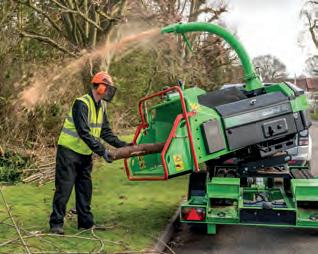
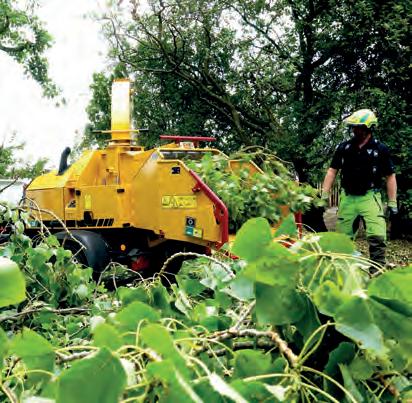
Fourth, conducting daily checks on the machine is fundamental.
Correct maintenance not only ensures operational safety but also extends the machine’s working life. Operators should
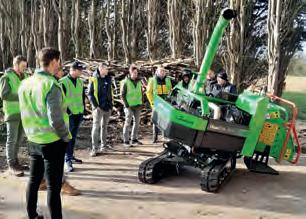
also possess the knowledge to identify potential issues early during that routine maintenance. GreenMech supports this by supplying an ‘ownership and maintenance record’ booklet with each machine to guide servicing. Lastly, a safety-first approach must extend to hitching and towing. GreenMech comments that knowing the correct method to hitch the machine to a vehicle is crucial, as is checking the handbrake status. Machinery must be securely fastened using the correct anchor points, with awareness that forward-facing straps can loosen. Regular trailer servicing is also suggested to ensure they remain in optimal working order.

In conversation with Pro Arb Magazine, the manufacturer Vermeer explains that safety is an inbuilt, engineered integral feature of all its woodchipper lineup. However, when asked about its top operational safety tips, similar to GreenMech, Vermeer emphasises that operators must always wear appropriate PPE including safety glasses, hearing protection, gloves, a hard hat and cut-resistant trousers when operating a woodchipper. Vermeer also stresses the importance of jobsite management, stating that you should never allow ropes or lines in a woodchipper working area. Furthermore, the manufacturer notes that it is crucial to follow proper shutdown and lockout/tagout procedures before attempting to clear a clogged chip chute or infeed jam.
Engineered with an emergency scenario in mind, Vermeer reports that its woodchippers are designed with specific safety features. These include a patented bottom feed stop bar at the front of the feed table that can be operated by a worker’s leg in emergency situations. This is complemented by an enhanced upper feed control bar offering additional emergency stop positions. The machines also feature long feed tables that provide more distance between the operator and the cutter drum and feed rollers.
Regarding the minimum safe distance for other personnel, Vermeer advises maintaining a broad perimeter, noting operators should keep equipment jobsites a safe and considerable distance away from climbing jobsites. The manufacturer also recommends that crews use proper jobsite setup with cones and signs around the equipment when working near streets and that personnel not operating
the machine should maintain a safe distance from the active working area. Finally, Vermeer further highlights what sets its machines apart from others on the market, referencing features like the Vermeer SmartFeed feed-sensing control, which it states enhances productivity by optimising efficient hardwood processing and monitoring engine speed and stopping or reversing the feed to avoid stalling and blockages. Additionally, the Vermeer Ecoldle engine control system is adjustable, saves fuel and reduces noise by automatically reducing engine speed after one or five minutes of inactivity.
The Vermeer BC200 brush chipper is designed for efficiency and durability. Its two-step start system allows operators to begin chipping quickly. Features like an infeed button, offset roller and a SmartFeed safety system aim to simplify operation.
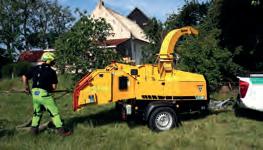
The machine is powered by a Stage V-compliant Kubota engine, available in diesel or petrol. An Ecodle system helps save fuel and reduce noise. Serviceability is a focus, with a one-piece hood providing access to key components like the chipper knives. A heavy-duty axle and powdercoating protect the unit for longterm use. The BC200 includes a three-year service coverage, extendable to five years. An optional turntable enhances versatility, repositioning for work on roadsides or confined spaces.
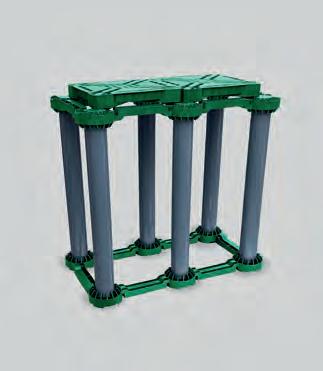
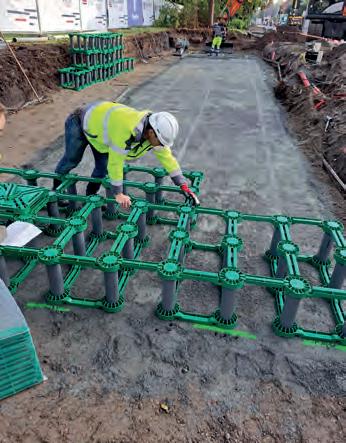


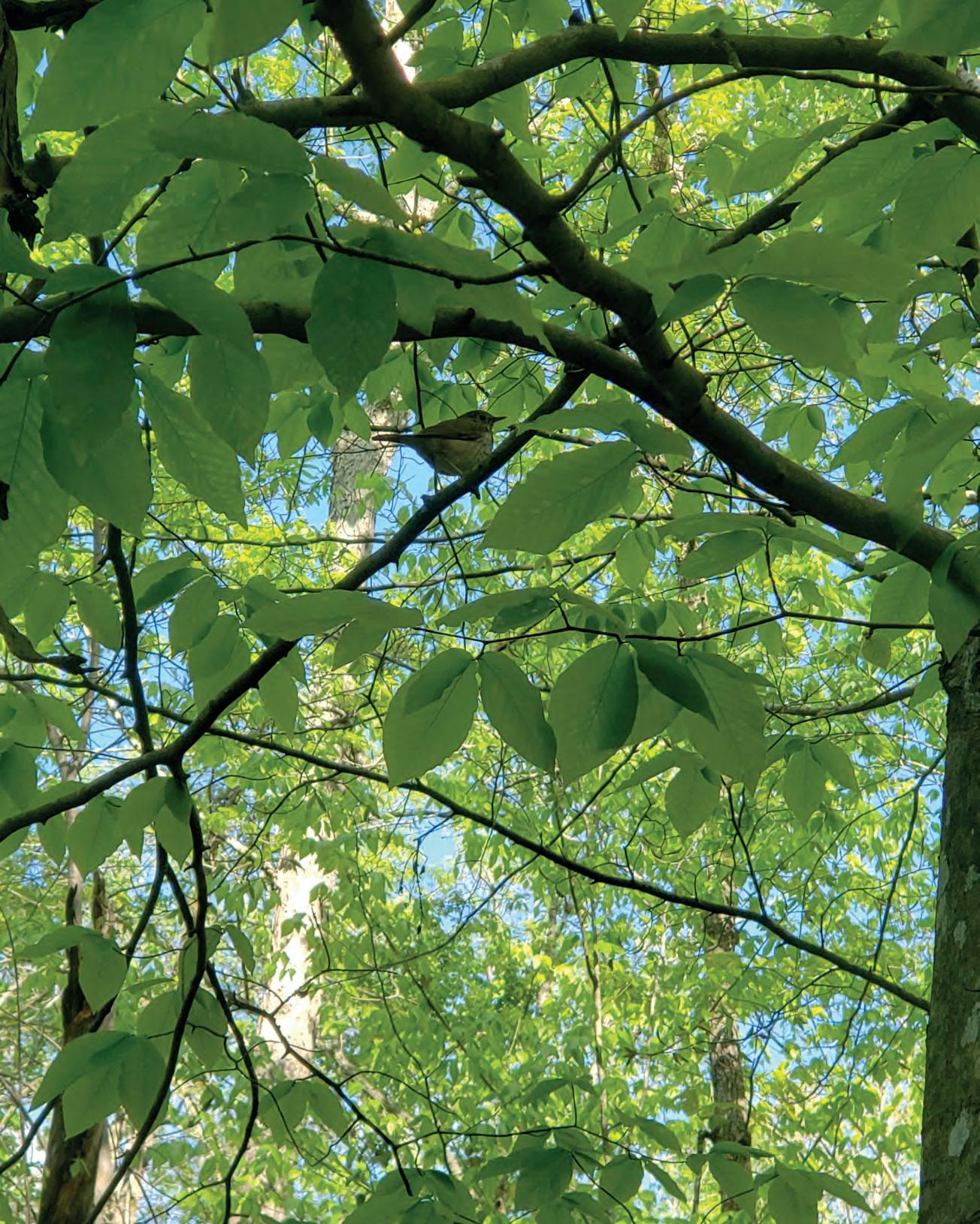
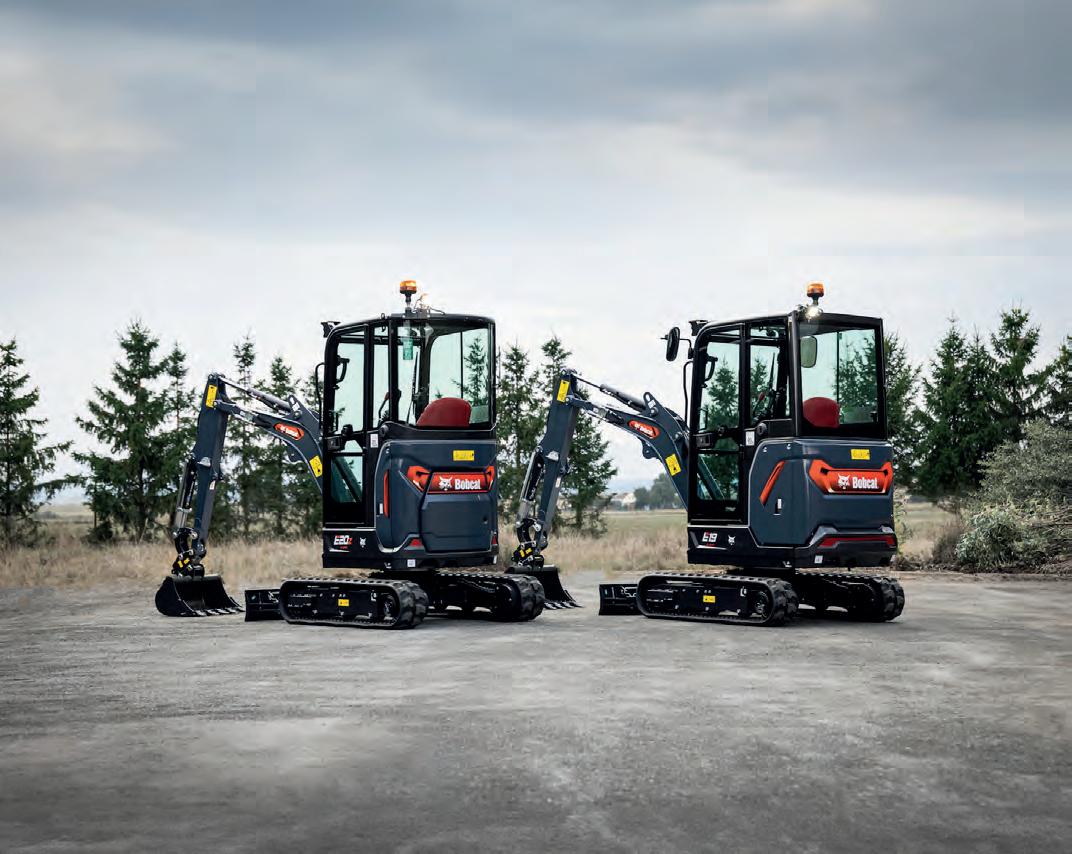
ver the last year, Bobcat has expanded its range of machinery, with the new R2-Series 1 to 2 tonne mini excavators being the very latest. For tree surgeons, Bobcat reports, these new machines are designed to tackle the unique challenges of the arboreal environment. Alongside a host of new and expanded ranges of attachments, Bobcat is making a clear statement about its commitment to the mini excavator and the rest of the compact equipment sector, culminating in an exclusive, limited-run Premiere Launch Edition that underscores the engineering advancements within the new R2-Series 1 to 2 tonne range.
The Premiere Launch Edition
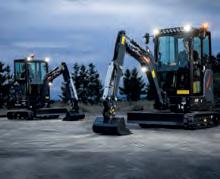
To mark the start of production, Bobcat is releasing a new limited series of 1 to 2 tonne machines. Only fifty Premiere Launch Edition units will be produced for the Europe, Middle East and Africa (EMEA) markets, with just twenty-five each of the top-tier E19 and E20z models available.
The special edition models are distinguished by an exclusive charcoal grey livery, a red and black cloth and leather seat cover and an individually numbered cab plate. They also come with
aluminium pedals and, crucially, four highvalue aftermarket kits as standard: Direct Return to Tank, Top Guard Cab, Travel Motor Hose Guard and a Bucket Cylinder Cover.
Miroslav Konas, product line manager for Doosan Bobcat EMEA, explains the thinking behind this launch: “The Premiere Launch Edition is a strong conversation starter and sales tool and allows dealers to offer customers a truly unique, high-spec machine that is both visually distinctive and technically enhanced. The non-standard colour and additional branding help increase awareness and generate buzz, and it serves to show that the new generation mini excavators are not just an update - they are a bold step forward.”
The engineering core

This “bold step forward” is most evident under the skin. The new R2-Series, comprising the E16, E17z, E19 and E20z models, replaces the previous M-Series. The headline innovation is the high-performance SmartFlow load-sensing hydraulics system. This system, coupled with a closed centre/ flow-sharing valve block and an upgraded engine, is a setup rarely seen in machines of this size.
Bobcat says the practical benefit for the operator is power on demand, a feature typically reserved for larger excavators. An upgraded engine ensuring both precision and efficiency. The SmartFlow system provides the required hydraulic flow while using the minimum energy, leading to a dramatic reduction in fuel consumption of up to 18% and a noise reduction of four dBA compared to the previous generation.
A more advanced hydraulics system allows for the smooth execution of multiple functions simultaneously. For an arborist, this means being able to operate a demanding attachment like a flail mower at full speed while simultaneously driving, slewing and lifting the boom without any loss of performance.
The new model line-up is tailored to diverse needs. Bobcat reports that the E16 is 100 kg lighter than the model it replaces, making it exceptionally easy to transport. Also, the E17z and E20z are Zero Housing Swing (ZHS) models, offering enhanced manoeuvrability in tight spaces by ensuring the entire upper structure rotates within the undercarriage footprint, a critical feature for working in confined urban gardens or near valuable property.
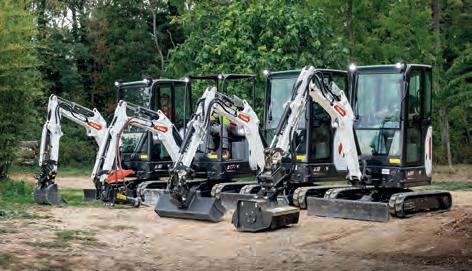
A top-of-the-range upgrade
Rounding out this year’s announcements is an enhanced version of Bobcat’s largest European mini excavator, the 9-tonne E88. The upgrade focuses on operator comfort with a new Fritzmeier cab, reduced noise and vibrations. Significantly for arborists planning complex projects, the E88 is now available in nine predefined configurations, including various long arm and articulated-boom specifications, allowing for precise machine tailoring to specific job requirements.
Bobcat product marketing specialist Patrik Nátr tells Pro Arb: “Bobcat mini excavators are the ideal solution for challenging forest environments, combining unmatched stability with superior performance technology. Our machines are highly stable on uneven ground thanks to their long tracks, and our lineup includes both conventional swing and ZHS models for maximum versatility in tight spaces.”
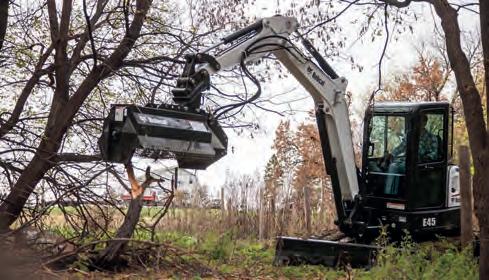
The A-SAC functionality gives the operator unprecedented control and customisation over the machine’s hydraulics, especially when using attachments.”
Nátr also advises a combined approach for maximum efficiency: “For the best results, we recommend combining your Bobcat mini excavator with a Bobcat loader. Loaders can be equipped with dedicated Bobcat forestry attachments, such as the powerful forestry cutter or the stump grinder, ensuring you have the perfect Bobcat tool for every stage of your operation.”
arborist’s attachment arsenal
A mini excavator is only as versatile as its attachments and according to Bobcat, the synergy between machine and attachment is key. For vegetation control, Bobcat offers several options. The Self-levelling Flail Mower, mounted on a mini excavator, allows operators to shred vegetation on difficult terrain, reaching areas inaccessible to other mowers.
As well as mini excavators, Bobcat has significantly expanded its line-up of attachments for the company’s wide range of compact loaders. The Log Grapple, available for the L23 and L28 Small Articulated Loaders (SALs) and the MT100 mini track loader, is a dedicated tool for grabbing and moving logs and brush, making light work of post-trimming or felling clean-up. For processing this material, the Grapple Bucket for larger loaders handles scraps, waste and brushes with heavy-duty reliability.
The company has also expanded its Brushcat Rotary Cutter range with new, smaller deck sizes for its SALs, enabling them to pass through narrow gates to clear untamed growth. Meanwhile, flail cutter attachments for compact loaders are ideal for cutting overgrowth on construction sites and roadsides, with a variable speed motor that can be tuned to the carrier’s hydraulic capacity.
With the launch of the advanced R2-Series mini excavators, the exclusive Premiere Edition and a comprehensively expanded attachment line-up, Bobcat is providing tree care professionals with a growing and refined toolkit designed to enhance productivity, comfort and versatility in some of the most demanding working environments.
He highlights the core technological advantages: “Our core advantage lies in performance: the sophisticated hydraulics system and A-SAC technology (Advanced Selectable Auxiliary Control) that deliver precise power and rapid cycle times. For more information visit: bobcat.com
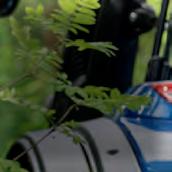
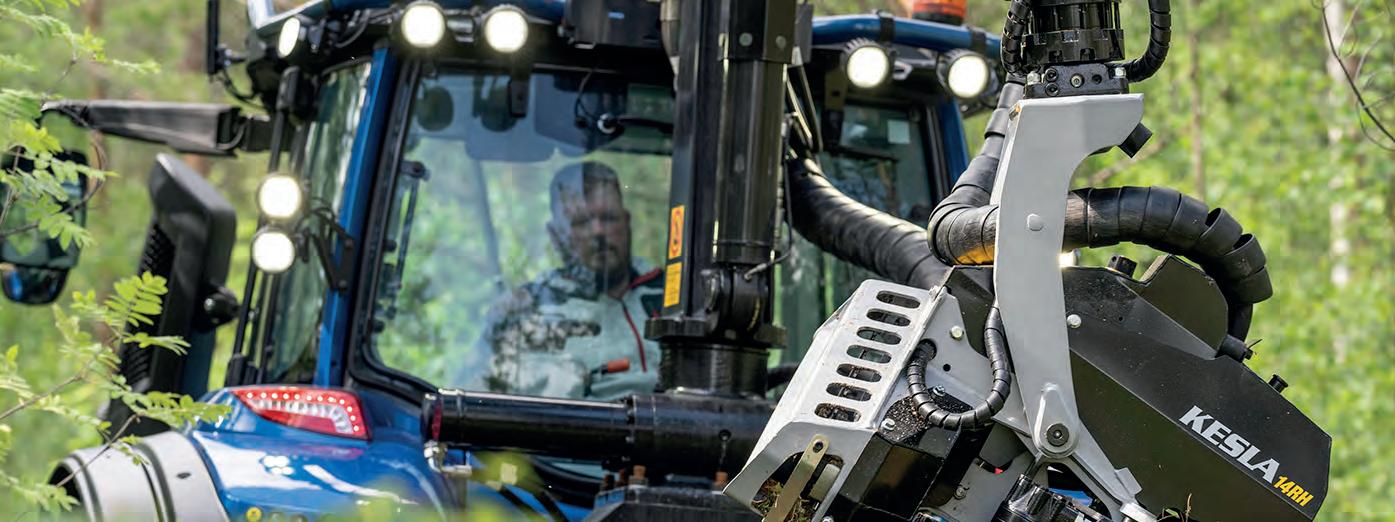
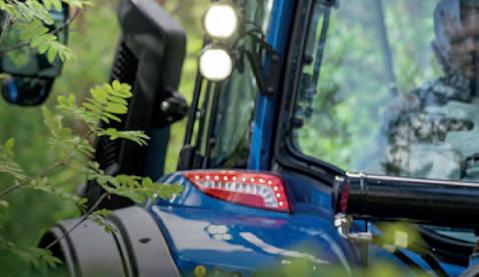


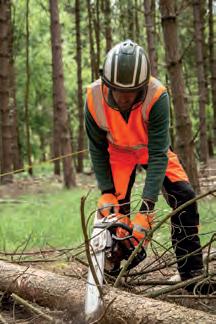
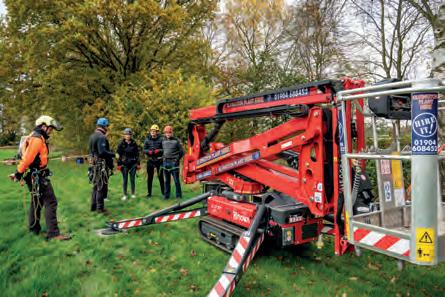



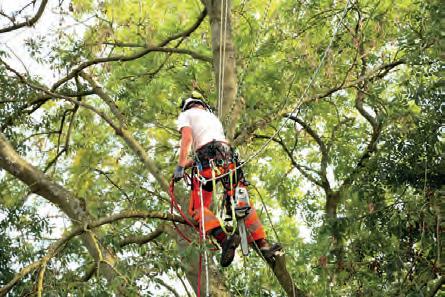




FCRACK THE CODE ON GOOGLE SEARCH. THIS GUIDE FROM CHRIS LONDON OF LANDSCAPE MARKETERS REVEALS HOW ARBORICULTURE BUSINESSES CAN LEVERAGE THE E-E-A-T FRAMEWORK , SHOWCASING REAL EXPERIENCE AND EXPERTISE, TO ENHANCE ONLINE VISIBILITY.
or arboriculture businesses learning to navigate the complex world of online search engines, Google’s ranking algorithms can often feel like an inscrutable black box. While specific formulas are closely guarded secrets, the guiding principles are not. At the core of modern search engine optimisation lies a critical concept known as E-A-T: Expertise, Authoritativeness, and Trustworthiness, later expanded to include Experience.
A recent interview in the last issue of Pro Arb Magazine with Chris London, owner of digital marketing agency Landscape
Marketers, shed light on Google’s business profiles and how to optimise them for local tree service results. However, in this article, London describes E-E-A-T as a more nuanced, albeit essential, framework for understanding how Google assesses a website’s value and ranks search results.
The evolution of E-A-T:
Adding an extra ‘E’ to the mix Google’s use of E-A-T to rank search results dates back to 2014, with the significant addition of “Experience”
arriving in late 2022. According to London, this update addressed a key shortfall in the original model.
“Originally it was only expertise, authority and trust. And the problem with that was that I might be an expert at writing about crown reduction or tree pests and diseases. However, I’ve never climbed a tree or cut one down,” he says. “So, Google brought in experience, to highlight experience’s role in content value and accuracy.”
Demonstrating “Experience” in a tangible way For service businesses, proving “Experience” is about showcasing real-world work in their online footprint. London’s strategy focuses on tangible evidence that a company doesn’t just talk about its services but actively performs them.
London suggests creating video, photo and case study resources on specific tasks, such as crown reduction or safe climbing techniques, and pairing them with a firstperson narrative. “At Landscape Marketers, we try and make sure all written content we put on a client’s website uses firstperson singular and collective pronouns (i.e., ‘I’ and ‘we’), because Google has signalled that using them is an important way of showing it is written from the author’s experience.”
This approach extends to customer reviews. “A large number of Google reviews shows the algorithm that a company has experience, particularly when reviewers mention names. For example, ‘Jacob did X, and it was a fantastic job.” London posits that this creates a verifiable digital trace.
When reviews mention team members and those same names appear on the company website and professional directories, it builds a cohesive, trustworthy profile that Google’s systems can recognise.
Establishing “Expertise” through content and credentials
While “Experience” is personal, “Expertise” is often demonstrated through more formal means. This includes the quality and specificity of website content, such as detailed blog articles on technical subjects.
“Expertise is much more than the tangible things, the Arb Approved accreditation, does a business have the right qualifications? This includes website content, such as blog articles on subjects. Also, a team page, showing who is in the
team and background,” London states.
When creating blog content, he emphasises targeting the questions potential customers are actually asking. “You’re writing for Google, but then you’re also writing for human beings. The whole purpose of a blog is to bring new potential customers into your website.” Effective topics range from practical advice based on subjects like “what to do with an overgrown
neighbour’s tree” to explaining technical differences between services like crown reduction and thinning.
Building “Authoritativeness” and “Trustworthiness”
The final two pillars, “Authoritativeness” and “Trustworthiness”, are closely linked. Authoritativeness is built when third parties vouch for a business. “This is a third party saying that a company is good, for example, through links to a website from other sites, mentions in the press and online reviews.”
London explains. For most small businesses, a steady stream of genuine customer reviews and an active social media presence are the most achievable paths to building authority.
“Trustworthiness” is established through transparency and consistency. “It’s all about proving that you’re an honest, open company,” says London. This includes having a verifiable physical address and phone number on the website and across all online profiles. He stresses the importance of NAP (Name, Address, Phone Number) consistency everywhere, from the Google Business Profile to online directories.
“Having the same details everywhere so that you don’t look shifty. A dodgy company is going to hide that information away.” Accreditations from bodies like Arb Approved or CHAS also bridge expertise and trust, providing external validation of a company’s standards.
The path forward:
A comprehensive strategy
London advocates for a comprehensive, “leave no stone unturned” approach.
In today’s world of accessible AI tools, London emphasises a clear boundary in content creation. While AI can assist, it should not be the primary author.
He states, “We wouldn’t use AI-generated content on a client’s website. Google says that AI content isn’t penalised, but it often produces poor-quality articles that are generic and sometimes inaccurate and that does hurt search ranking. AI is great for ideas, but it is better to write website articles from experience and knowledge so they are unique and demonstrate the creator’s expertise.”
He suggests a more authentic approach: “Recording videos in your own voice and using AI for transcriptions is ideal; it captures your true voice and shows your expertise.” Relying solely on AI text is risky. “It may not be a problem now, but it could be in the future if Google decides to penalise websites that rely on AIgenerated content.”
Given that Google’s precise weighting of each E-E-A-T factor is unknown and constantly evolving, the safest strategy is to diligently work on all fronts.
“It’s trying to make sure you do everything right, knowing that some things may only have a very small impact. However, if you do them all and keep working at them, you are ensuring your search ranking will continue to improve,” he concludes.
In the absence of a definitive roadmap, businesses that consistently demonstrate real-world experience, deep expertise, third-party authority and fundamental trustworthiness through every digital touchpoint are the ones most likely to crack Google’s algorithms, but, more importantly, earn the trust of their future customers.
For more information, visit: landscapemarketers.co.uk
According to the Mental Health Foundation, mental health issues were the fifth most common cause of sickness absence in the UK in 2022, accounting for 7.9% of all occurrences. This is corroborated by 2023 estimates from the health and safety executive, which reported that work-related stress, depression or anxiety led to 17.1 million lost working days, affecting nearly 900k workers. Furthermore, Deloitte (2020) found that for every one pound invested in workplace mental health, employers see an average return of five pounds.
ver the last few years, mental health has begun to be more widely understood as a central component of everyone’s lives, moving beyond its previous status as a peripheral or purely clinical concern. A key display of this shift in the corporate world has been the extensive adoption of Mental Health First Aid (MHFA) training, a programme gaining traction as a critical tool for early intervention and support. To understand MHFA training’s role and future in modern businesses,
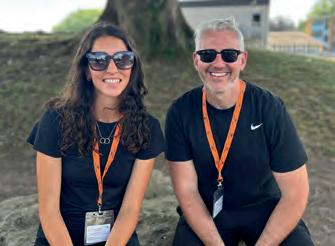
Pro Arb Magazine spoke with Colin Rouse, a wellbeing expert and director of The Workplace Health Coach, whose own journey into the field was born from lived experience.
Rouse’s background is in sport and public health, a sector he worked in for fifteen years before transitioning into the corporate wellbeing space. The catalyst for this focus on mental health was witnessing a toxic culture within a local council he worked with. During this time, Rouse himself experienced panic attacks. This lived experience, coupled with a passion for human connection in an increasingly digital world, led him to retrain as a Mental Health First Aid instructor.
But what exactly is the place of MHFA in a modern workplace? Rouse draws a clear parallel to physical first aid to illustrate its necessity. “I think the problem we see in companies at the moment is that it’s a lot of the time reactive,” he comments. “If someone breaks their leg, you can very much see that... the person will get it treated quickly. But I think with mental health, a lot of people will get support only once their symptoms have developed into a more serious condition.” MHFA training, which is licensed and

recognised by the Royal Society of Public Health, is designed to combat this delay. It empowers employees to recognise the signs and symptoms of mental health issues like depression, anxiety or bipolar disorder, and provides a framework for offering initial support. “MHFA training empowers people to feel more confident to begin conversations and to provide those first few steps to encourage someone to get support,” Rouse states. “And, more importantly, to help in a crisis.”
A key distinction, and one that Rouse emphasises strongly, is that Mental Health First Aiders are not therapists, counsellors or coaches. “So, counselling is often to deal with something that’s been traumatic in their lives, while coaching is all about goals and moving forward,” he clarifies. “However, Mental Health First Aid really is what it says, it’s first aid... It’s all about nurturing a colleague to take those first active steps.”
The framework used is ALGEE: Approach, Listen non-judgementally, Give support and information, Encourage appropriate professional help and Encourage other supports. It’s about creating a culture where employees feel safe to be open about their wellbeing without fear of stigma.
The structure and importance of self-care in training
For companies considering incorporating MHFA into their business, the training is offered flexibly via The Workplace Health Coach. “It can be delivered either online or face-to-face,” Rouse notes. There are several tiers, from a four-hour ‘Mental Health Aware’ course to the full two-day accredited training. The two-day course
is the comprehensive option, covering the signs, symptoms and first-aid action plans for a range of conditions. However, crucially, it also heavily focuses on the wellbeing of the first aider themselves.
“One of the most important principles in the training is self-care,” Rouse stressed. “Having these conversations cannot always be easy, especially if someone’s having a crisis; therefore, there is an initial discussion in a course about self-care support. How do you look after yourself? How do you put your own oxygen mask on first?”
PEOPLE TO FEEL MORE CONFIDENT TO BEGIN CONVERSATIONS AND TO PROVIDE THOSE FIRST FEW
This focus on self-care and boundaries is vital to prevent burnout and ensure that those who take on the role are protected. Rouse advises companies to encourage individuals who have a genuine empathy for the role to take the course, not just those assigned to tick a box.

“The one thing I’d encourage companies to do is to recruit or train Mental Health First Aiders who want to do it for the right reasons. This could be a person who has had some lived experience, as safeguarding self-care is paramount.”
The Future: An inevitable standard? Looking ahead, Rouse believes the adoption of MHFA is on an upward trajectory, driven by the immense strain on NHS adult talking therapy services and rising mental health statistics. “We know that actually there’s been a 48% increase in primary and secondary care
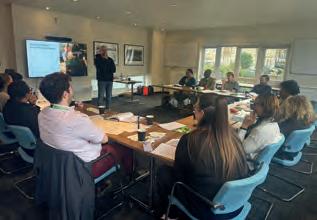
admissions, that’s huge,” he says. “This training is just one tool, if you like, in the toolkit to address that issue.”
He predicts that what is currently a best practice initiative will soon become a mandatory requirement. “I think in terms of the future, I think it will become legislation that companies will have to have at least a minimum of one Mental Health First Aider per fifty employees, per se. I think that’s only a matter of time.”
This shift is already being seen in tender requirements for large organisations and educational establishments. The fact that MHFA is the only licensed product of its kind in England, backed by academic research and the NHS, positions it as the gold standard for such future regulation.
For Colin Rouse, the mission remains rooted in that initial drive to foster resilience and human connection. As workplaces continue to evolve, Mental Health First Aid is poised to become an indispensable layer of support, equipping employees to care for each other and fundamentally changing the conversation further around mental health for the better.
Find out more at wphcg.co.uk, Pro Arb readers will recieve 20% off all courses.


For many skilled arborists, a natural career progression after years working as a climbing tree surgeon is to become their own boss. For Henri Ghijben, managing director of HRG Tree Surgeons, that dream became a reality fairly early in his career at 24.

His determined approach drove rapid growth from a one-person operation to a company with fortyseven employees and seven-figure revenue, including a major contract. However, changing contract terms triggered a financial crisis. Ghijben admits, “I made loads of mistakes... Didn’t know my numbers.” The pressure took a personal toll, resulting in long hours. Ultimately, the company collapsed in May 2019, leaving him with significant personal debt.
Addressing the business knowledge gap
For Ghijben, the failure was a harsh and necessary lesson. “I’d done it on pigheaded determination and hard work, but I hadn’t really learnt anything.” The turning point came when a business coach asked to see his balance sheet and profit-andloss statements. Ghijben’s response was: “What’s one of those?”
This moment of stark realisation illuminated what he sees as a systemic issue
within the arboriculture industry. “There’s no one really out there saying, ‘Well, this is how you run a tree surgery business.’”
After educating himself on business best practices, Ghijben rebuilt his tree surgery company into a seven-figure firm with a new focus on data-driven
ANY SORT OF INVESTMENT IN YOURSELF IS ONLY GOING TO PAY YOU BACK IN THE FUTURE
decisions and management. He also then launched a new venture: the ‘Tree Surgeons Business Academy,’ a dedicated training programme for arb businesses and a mastermind group designed to teach other tree surgeons the business skills he lacked through peerto-peer learning.

His offering, which includes courses on mindset, marketing, finance and operations, has been met with some resistance from parts of the industry. Nevertheless, despite the criticism, his training programmes have grown. He emphasises that it is a facilitative process, not about him being the expert. “For example, the mastermind
course is getting a collective of tree surgery business owners together... getting lots of perspectives on your challenges – running a business can be quite lonely.”
Turning over a new leaf Ghijben comments that his core message to struggling business owners is to invest in their own education. He advises, “Go and learn about business, whether it’s my course or someone else’s... Any sort of investment in yourself is only going to pay you back in the future.”

The goal, for Ghijben, isn’t necessarily to build empires but to create sustainable businesses that provide a good living without consuming their owners. “You can earn a six-figure salary a year more, and you can work thirty hours a week, but you will need to build a team that can help you go and achieve that.”
It’s a lesson learnt from the pain of losing almost everything, one he hopes will help others avoid the same fate.
For more information please visit: hrgtreesurgeons.co.uk tsbauk.co.uk

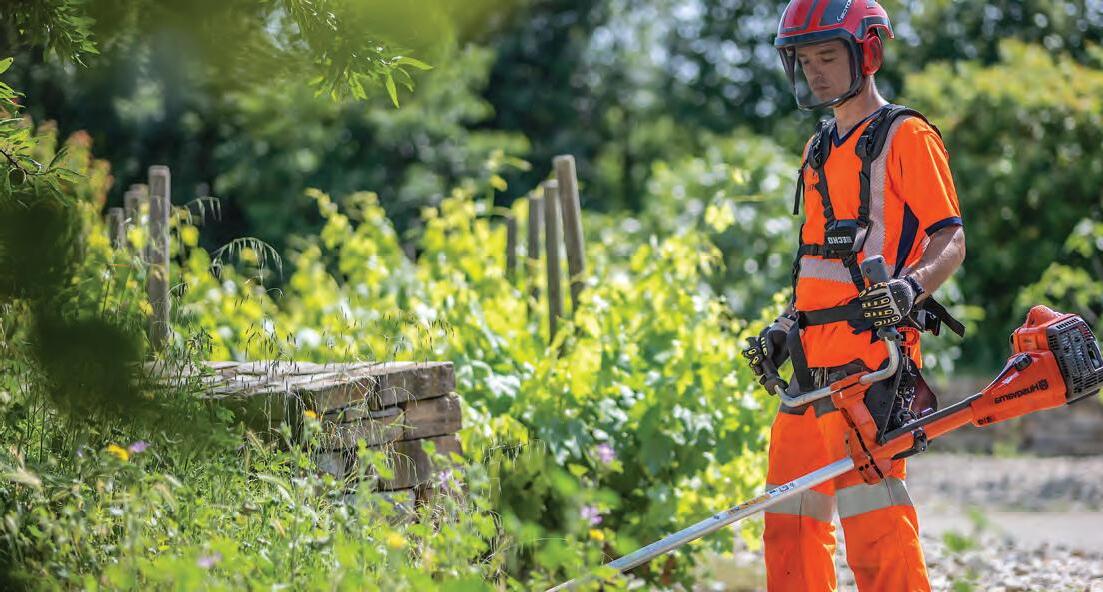

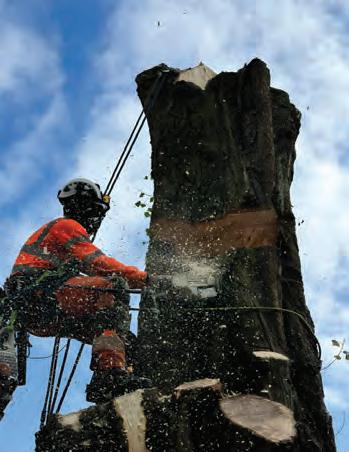
BEECHWOOD TREES AND LANDSCAPES
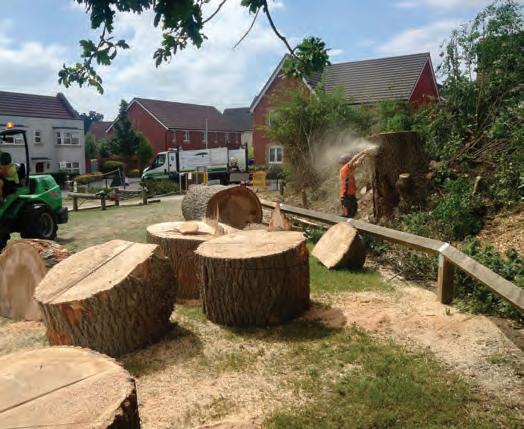
Outwear, the exclusive distributor of Protos, Pfanner, Crispi, Sasta and Woolpower has selected a winner for this issue’s Arb in Action photo contest. The competition, which ran for two months, invited tree surgeons nationwide to submit photos of themselves and their teams at work. Every magazine issue, the winning entry will receive an exclusive prize package from Outwear, and all participants will have their photos published across Pro Arb’s social media.
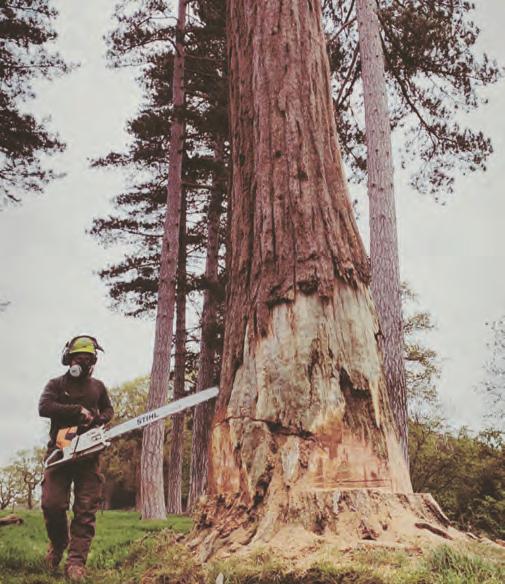

AND
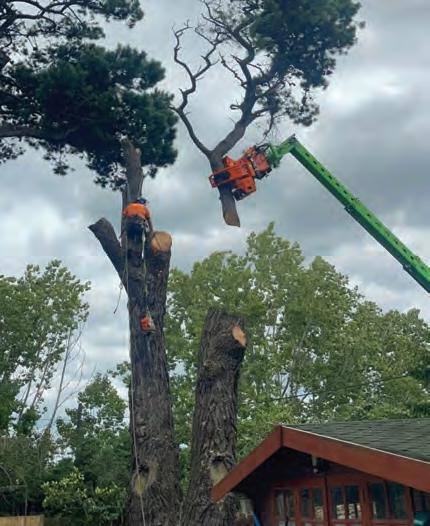
• HOW TO TAKE PART IN THE DECEMBER/JANUARY COMPETITION
You can email a single image or a number of images (high-resolution) to: proarbeditor@eljays44.com
• TELL US WHO YOU ARE
Please supply your name and that of your business – if you are a subcontractor, tell us who you are working for.
• TELL US WHAT YOU WERE DOING
Provide us with a few details of the job and the kit used.
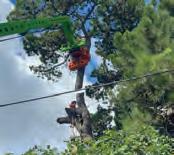

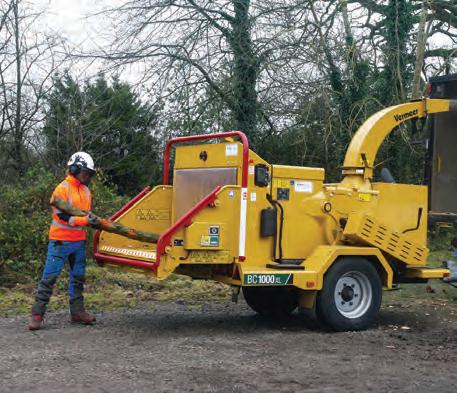
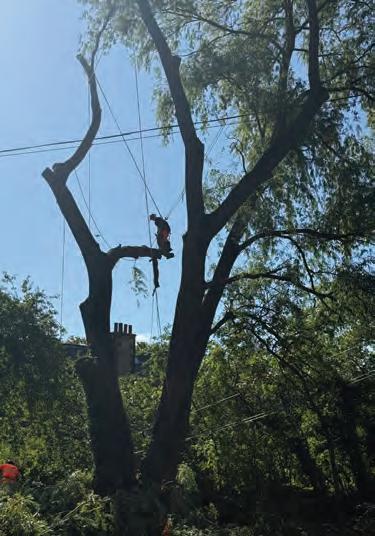
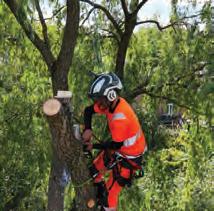
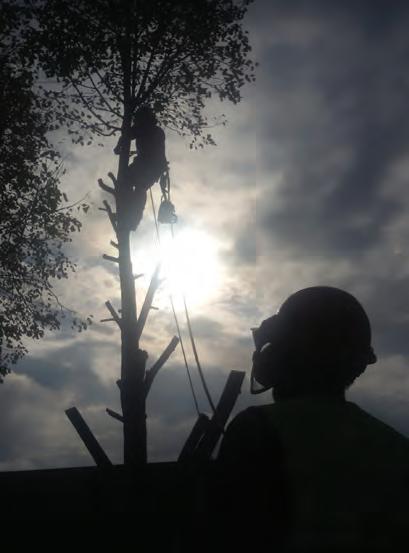

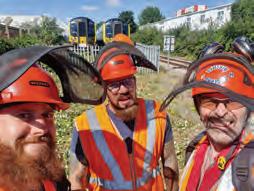

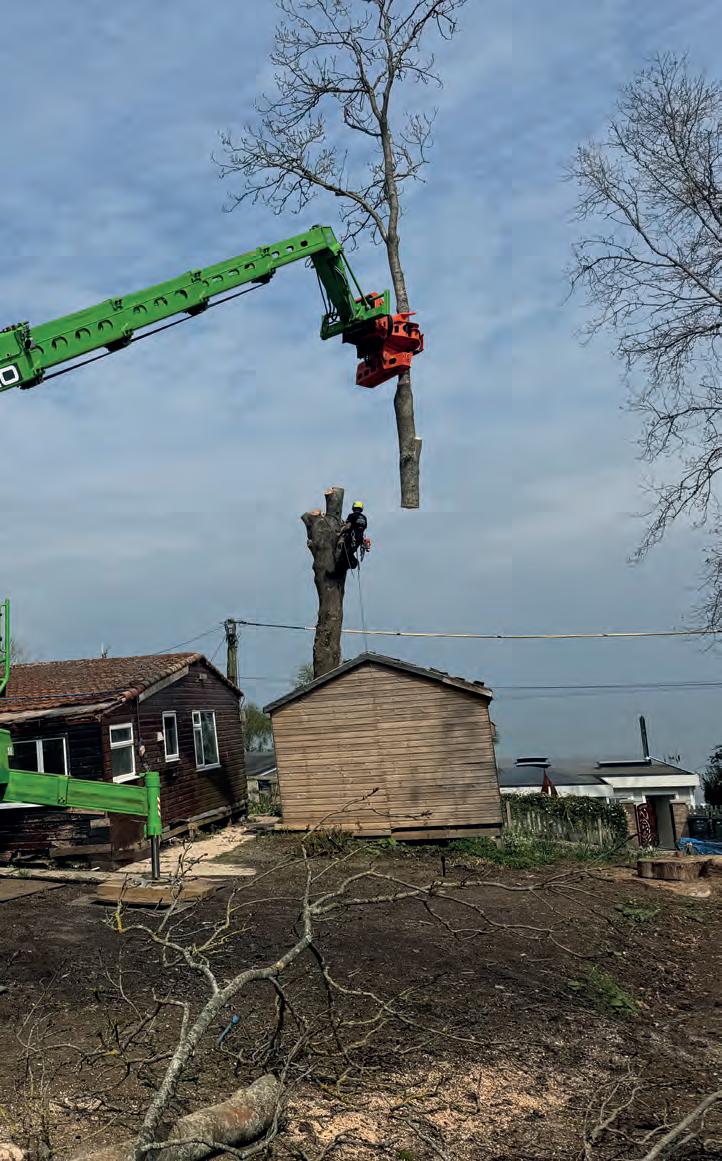


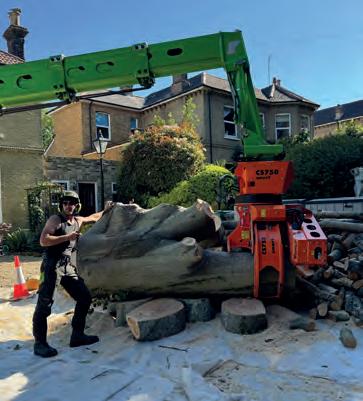
Leading the way with exceptional performance and unrivalled support.
It’s the Först way.
#ThisIsFörst
forstglobal.com 01264 721790